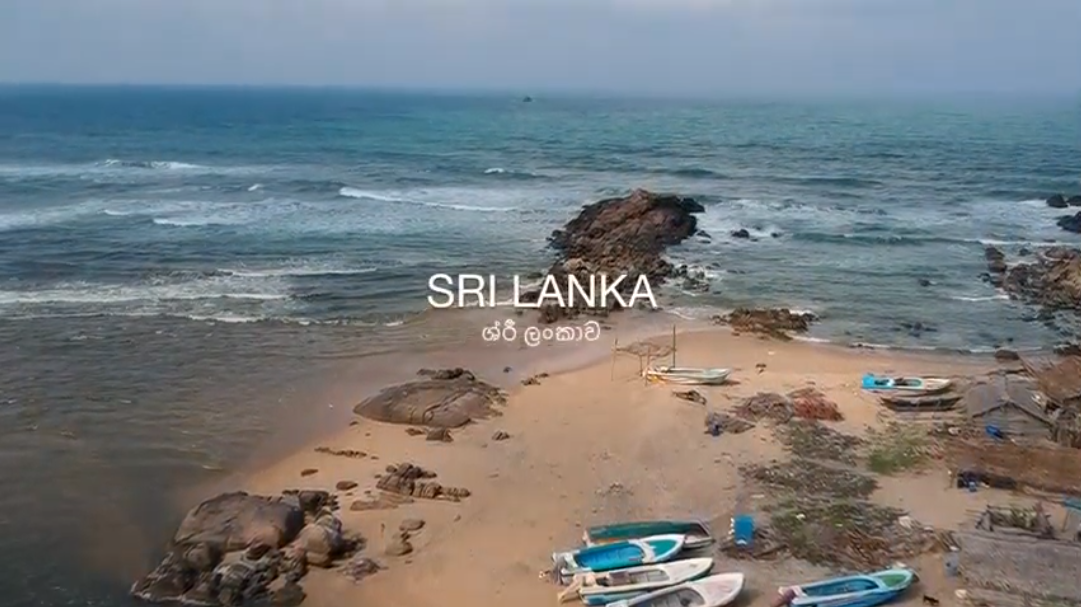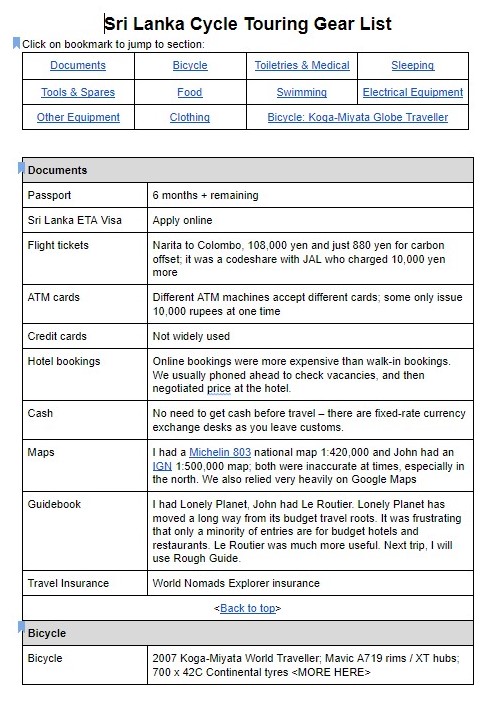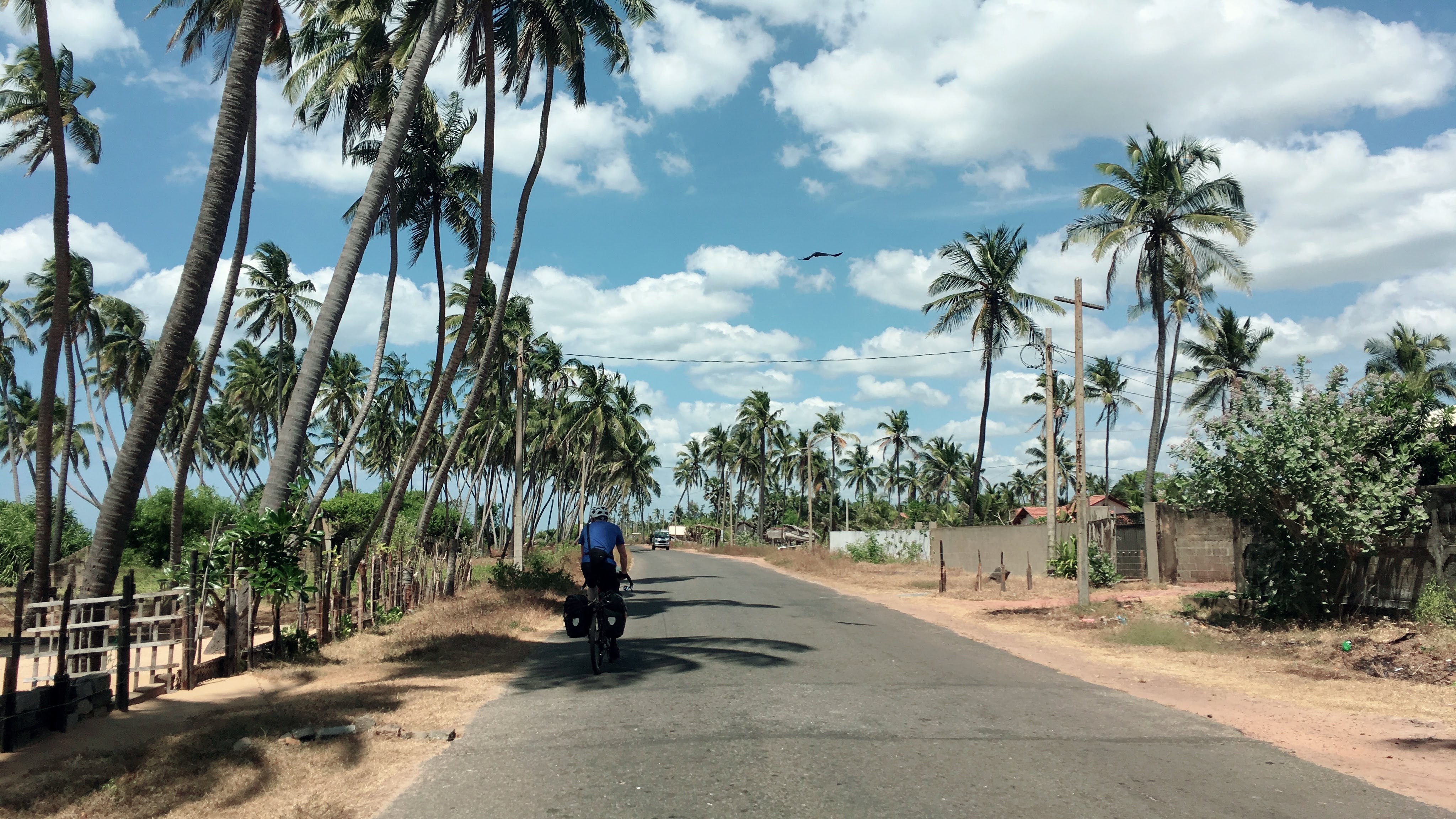
Sri Lanka
I had been thinking about visiting Sri Lanka for many, many years but somehow other places kept getting in the way. In 2018, my friend John and I had considered Sri Lanka but ended up cycling in Laos. For this year’s trip, we were hoping to go to South America, but with long flights and long layovers to get to Chile or Argentina, we turned our attention once more to Sri Lanka. With John living in Switzerland and me in Japan, Sri Lanka is somewhere in the middle. It is also just the right size for a short tour: 500 km from north to south and 300 kilometres from west to east. It seemed to satisfy most of our criteria for a cycle trip – good weather in our winter, varied geography, interesting culture, vegetarian food (for me), and hopefully some quiet roads. The last point is the most important; there is nothing worse than riding for long periods on roads choked with cars and trucks and buses. It was also the thing we were most worried about having endured heavy traffic on previous cycle tours, but fortunately for not too long. I spent hours poring over Google Maps and Street View trying to work out the amount of traffic on possible routes. What would Sri Lanka actually be like?
Sunday, Feb 16 – Negombo
I flew Sri Lankan Airlines which had the advantage of being relatively cheap and a direct flight. Everything else about the flight, from the one-hour wait on the runway, through the awful food, to the malfunctioning entertainment system, was best forgotten. Things perked up in Colombo International Airport where I glided effortlessly through immigration with my online ETA visa, found my bags on the conveyor belt, walked through customs, and exchanged some Japanese yen for Sri Lankan rupees. My hotel pick-up was not there, so I got a SIM card from the Airtel booth, which immediately worked, unlike in Laos and India. As I walked away from the booth, my taxi driver rushed up and guided me to his car. We arrived thirty minutes later at the charming Icebear Guest House, right on the beach in Negombo. It was the most expensive place of the whole trip, but the fantastic garden alone made it worth it.
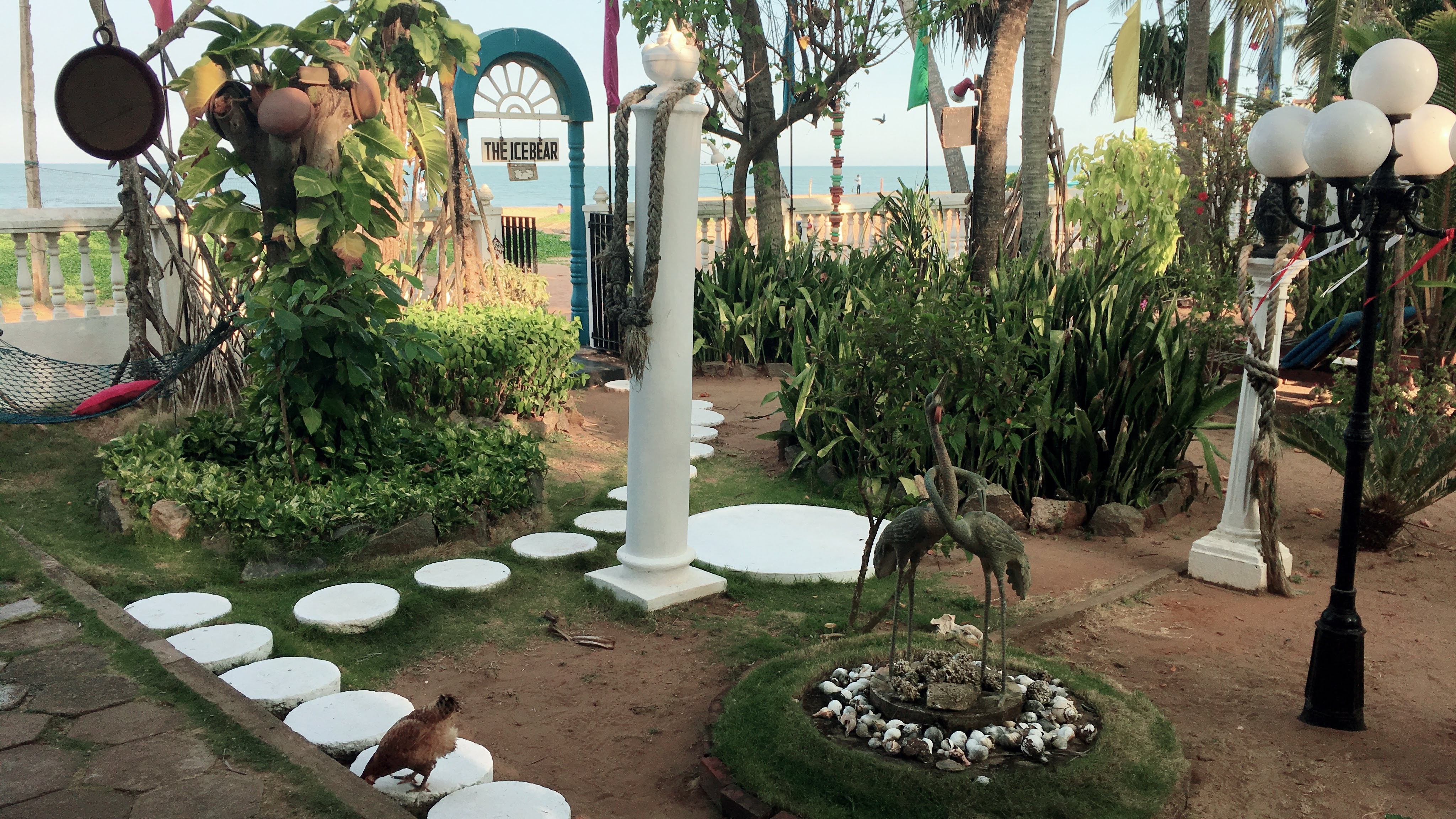 Garden of Icebear Guest House
Garden of Icebear Guest House
John and I hadn’t met since the Laos trip two years previously. We exchanged news over a pretty poor dinner of fish curry (a few chunks of tasteless fish in a nondescript brown sauce) and a tiny portion of rice. Surely we hadn’t arrived in a period of rice rationing. This didn’t bode well for the rest of the trip when we’d be burning several thousand calories a day. We discussed our plans for the tour as we had arrived without a clear route in mind. Although we would have liked to ride all the way north to Jaffna, it didn’t look like we would have time to also visit the south coast which we really wanted to visit. As Negombo is 20 kilometres north of Colombo, we decided to head out north along the coast and see where the road took us.
[Click here for full gear list]
Monday, Feb 17 – Negombo to Puttalam 120 km
 Setting off from the Icebear Guest House
Setting off from the Icebear Guest House
I got up at 4 a.m. and put my bike together in my room. Breakfast was at 7:30 a.m. and was a little better than the previous evening’s fare – scrambled egg, white toast & marmalade – but similarly overpriced. I finished getting my gear together and we set off north along the coast at 10 a.m. Within minutes we had to stop to replace a nut and bolt that had worked loose on my pannier hangers – it turns out Ortlieb uses plastic nuts on these crucial fixings.
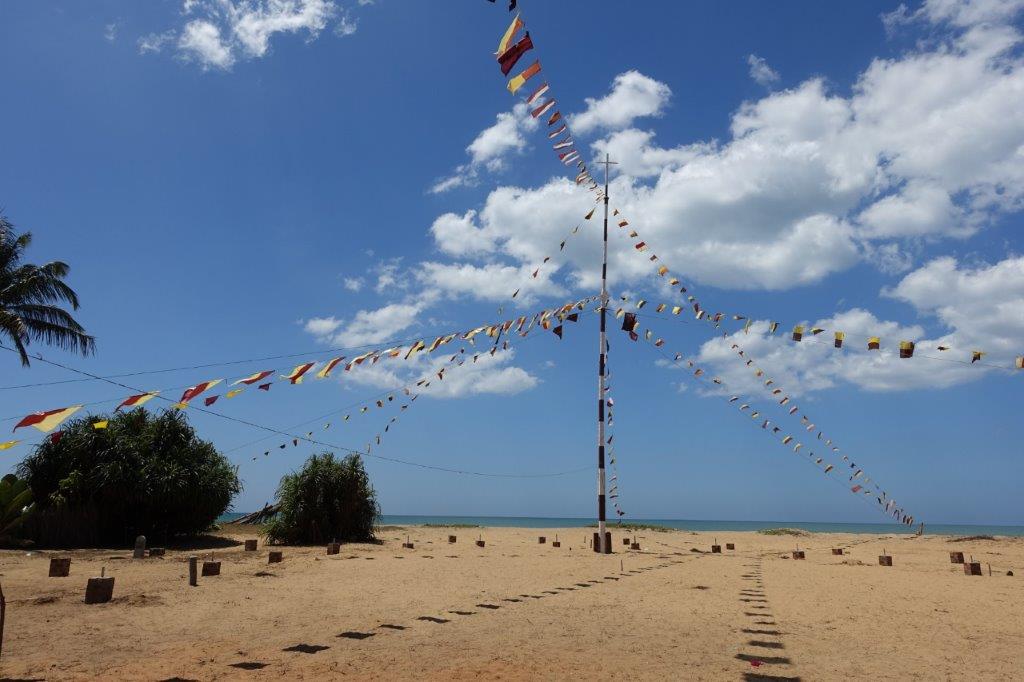
Then we were off again along the busy A3 as far as Nainamadana from where we managed to find quieter roads that wound up the coast. It was fantastic riding on small roads that ran through an endless string of fishing villages. We passed teams of men on the beach hauling in nets, and crowds of people haggling over the haul. Alongside the road, families were selling their catch laid out on plastic sheets. The smell of fish was everywhere.
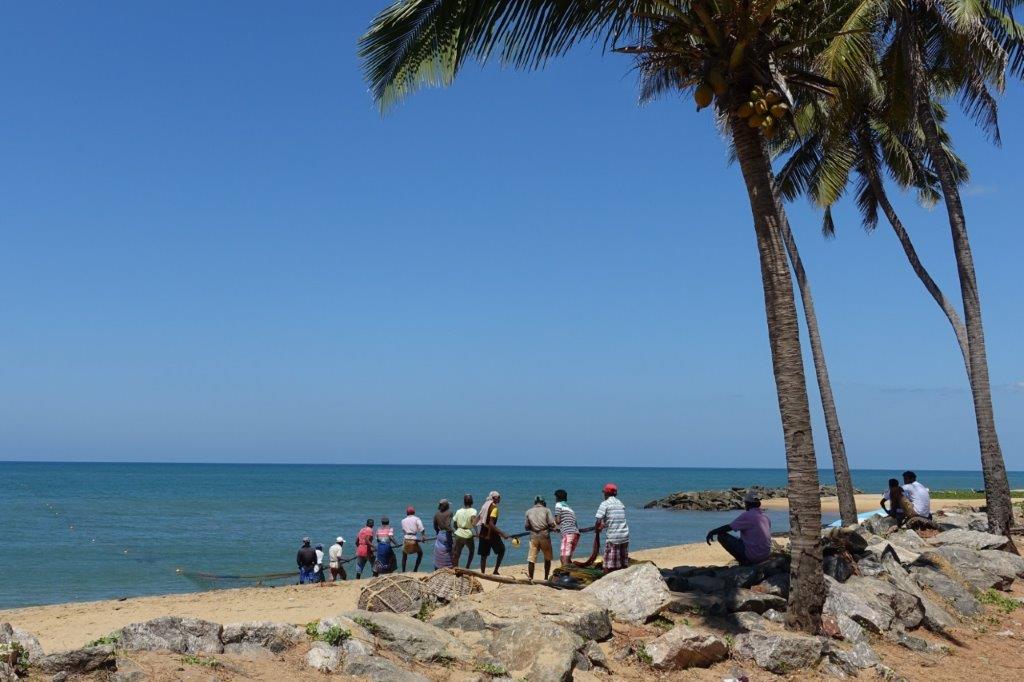
From time to time, the line of modest houses and fishing shacks was suddenly broken by luxurious resorts and clusters of tourist restaurants with signs in English and Russian. Large, pale tourists lolloped on loungers hiding from the sun beneath parasols. It was all very incongruous.
 Deduru Oya River, Chilaw
Deduru Oya River, Chilaw
We pedalled on and on. At Chilaw, we turned inland as our way was blocked by the Deduru Oya river estuary. We found a cheap restaurant called Madras Cafe where we had our first of many rice & curry lunch buffets. We filled up on dal and several vegetable curries before returning to the blistering mid-afternoon heat and mounting headwinds. We had little choice but to take the A3 for nearly an hour to Battaluluoya. It was busy but not too bad as everyone gave us plenty of room. After 15 kilometres of dogged riding we were able to return to small roads along the coast.
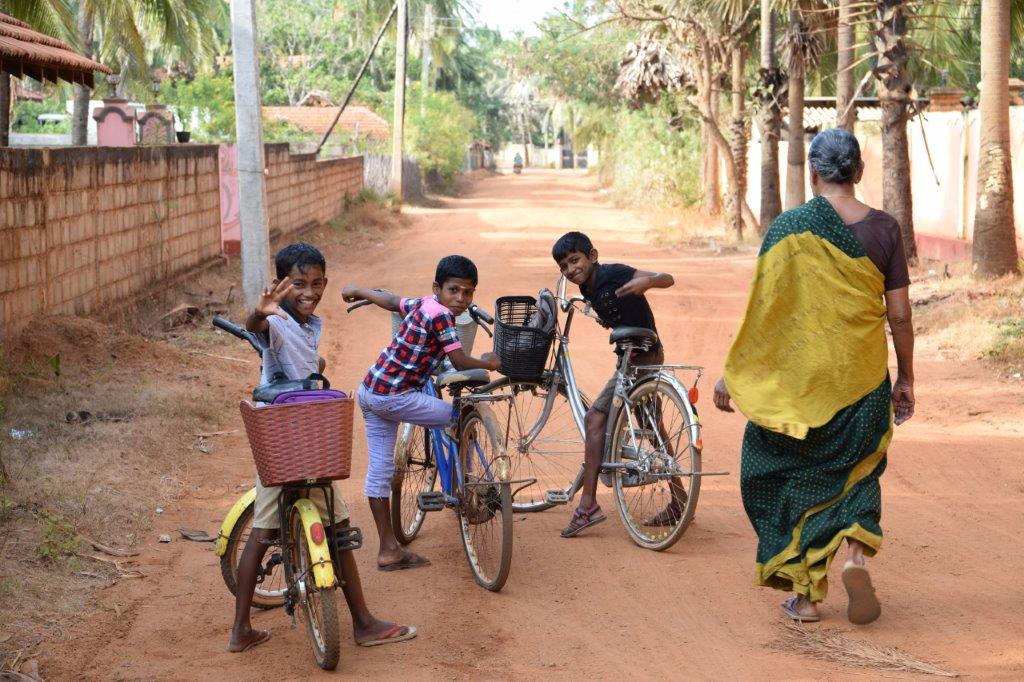 Coast road north-west of Battaluluoya
Coast road north-west of Battaluluoya
The roads might have been quiet, but the riding was no longer easy. At times, the asphalt gave way to sandy tracks, and the headwind was draining us of energy. We were getting ready to call it a day, but every hotel we phoned was full or not answering. We rode on, time moved on, the road got worse, the wind picked up; we needed a hotel. We finally gave up on the coast road, which was now loose sand, and doubled back inland to look for a better road. It was turning into one of those days. The sun started to go down, so we dug our lights out of the bottom of panniers. This was turning into quite a first day.
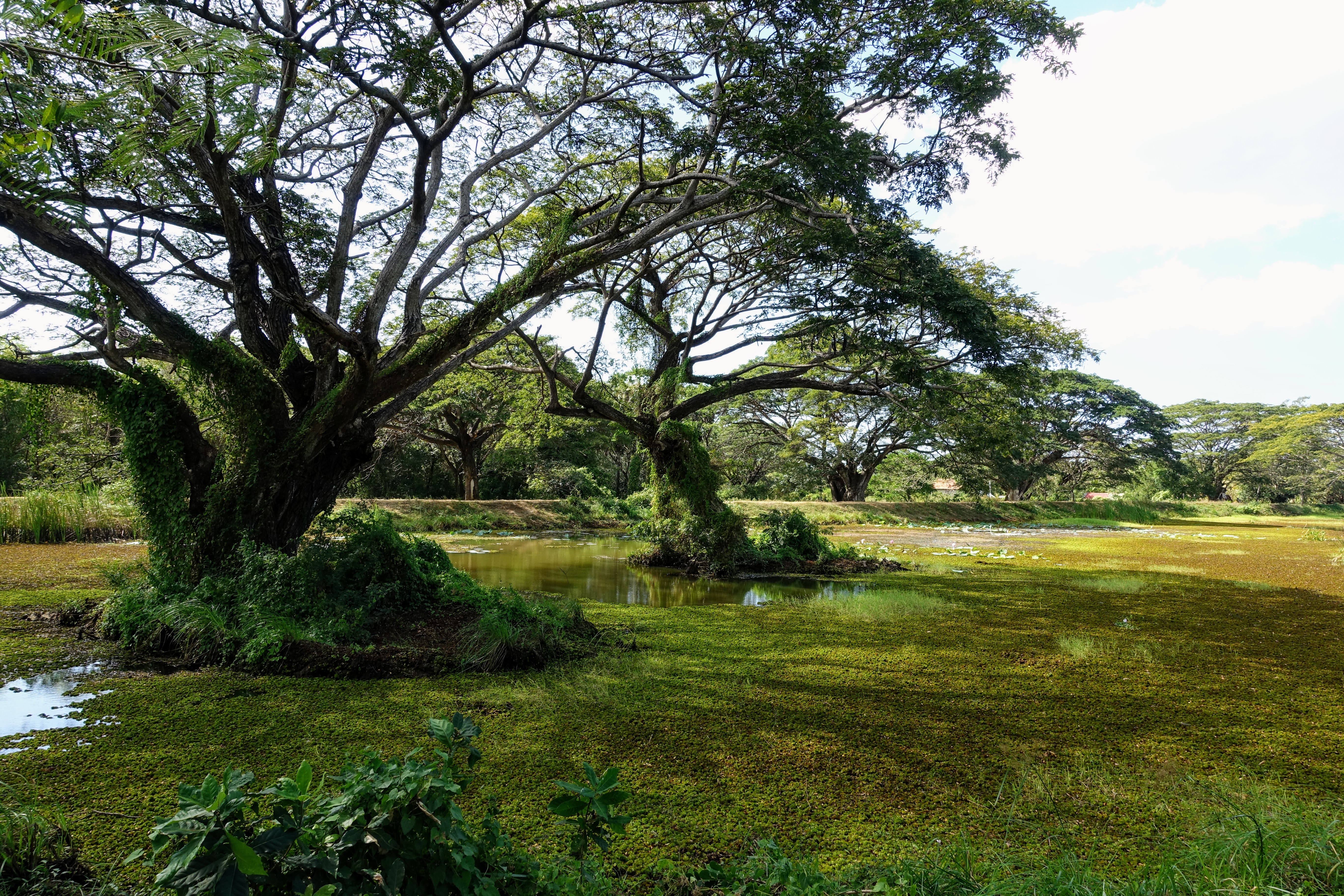 Wetlands cover most of the region
Wetlands cover most of the region
For the next hour, we put our heads down and time-trialled into the wind. At least it was good training. We finally reached Puttalam Lagoon and turned left towards the first resort on Google Maps. We arrived four kilometres later to discover that it was closed. We could have looked for more resorts in the area but decided to return the way we’d come and then ride another 20 km to Puttalam which would surely have plenty of hotels. It felt like a long ride in the dark on a busy road into the wind.
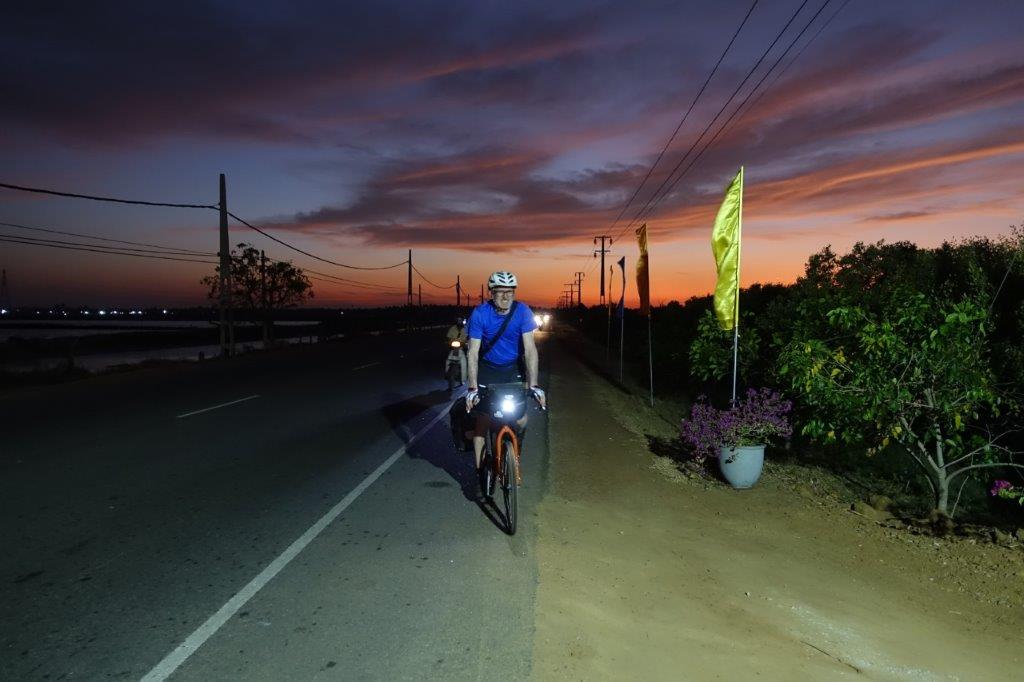
At last we arrived in Puttalam but still spent 30 minutes riding around looking for a hotel. The Airtel 3G was very patchy, Google slow to load, and the first two hotels marked on the map did not exist. At last, we spotted a sign to “Rest House” and followed it to a very welcome and welcoming government run guest house. It was in a sprawling colonial-era building with spacious rooms and large covered verandas typical of South Asia. We were shown to a large, basic room with three very short beds. It was paradise. Fortunately, there was a restaurant, but we seriously over-ordered: we received enough fried rice and fried noodles for a full team of cyclists. I was too tired to eat even half of mine.
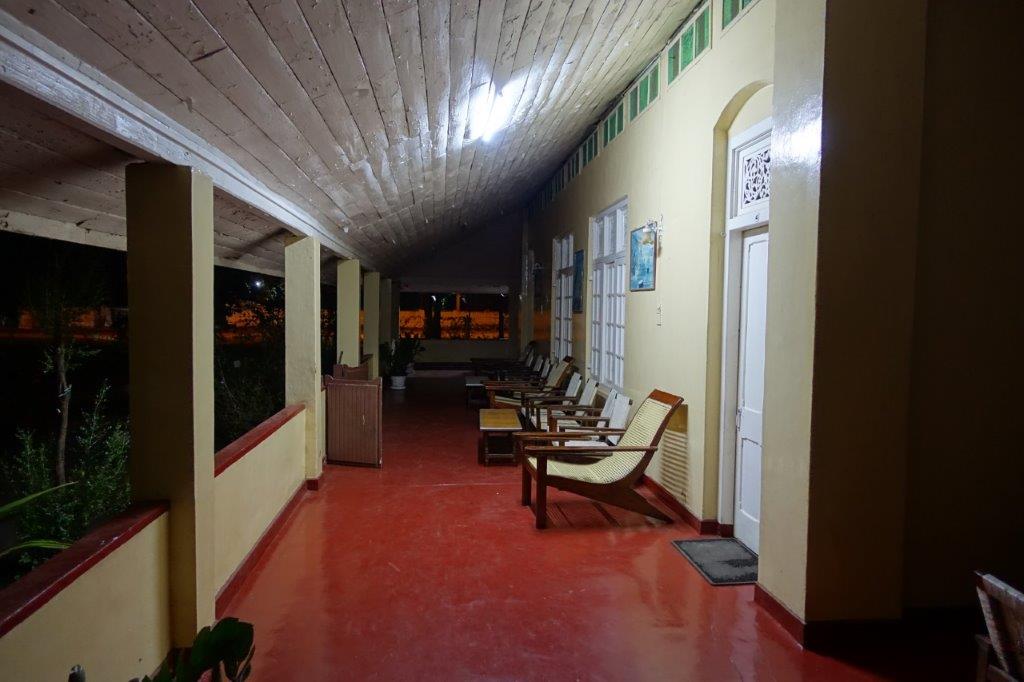 Puttalam Rest House
Puttalam Rest House
Tuesday, Feb 18 – Puttalam to Anuradhapura 78 km
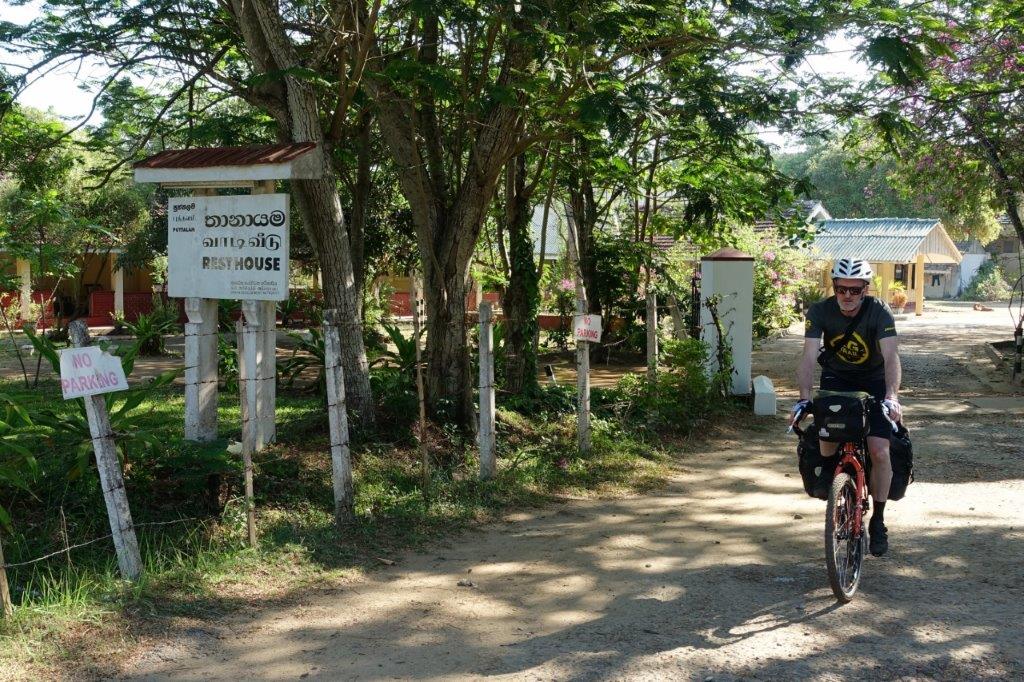
In the morning, we had fried egg and singed bread for breakfast. It was a meal we would get used to over the coming days and weeks. Our bill came to 5,500/- for the room and 6,800/- for the food and drinks. It seemed expensive but it would be typical for the trip. We learnt from the guest house that the road we had intended to take north from Puttalam though Wilpattu National Park was closed. This is the direct road to Jaffna, so we would have to make a new plan. We decided to head north-east to Anuradhapura. The only problem is there’s only one road, the A12, through Sri Lanka’s wetlands; all the smaller roads end at lakes and rivers. The good news was that the road was fairly wide with a shoulder to ride on and not too much traffic. The bad news was the wind was strong and straight into our faces. As we passed by the numerous lakes, we were almost blown backwards. It was only 79 km but we had to earn every one of them.
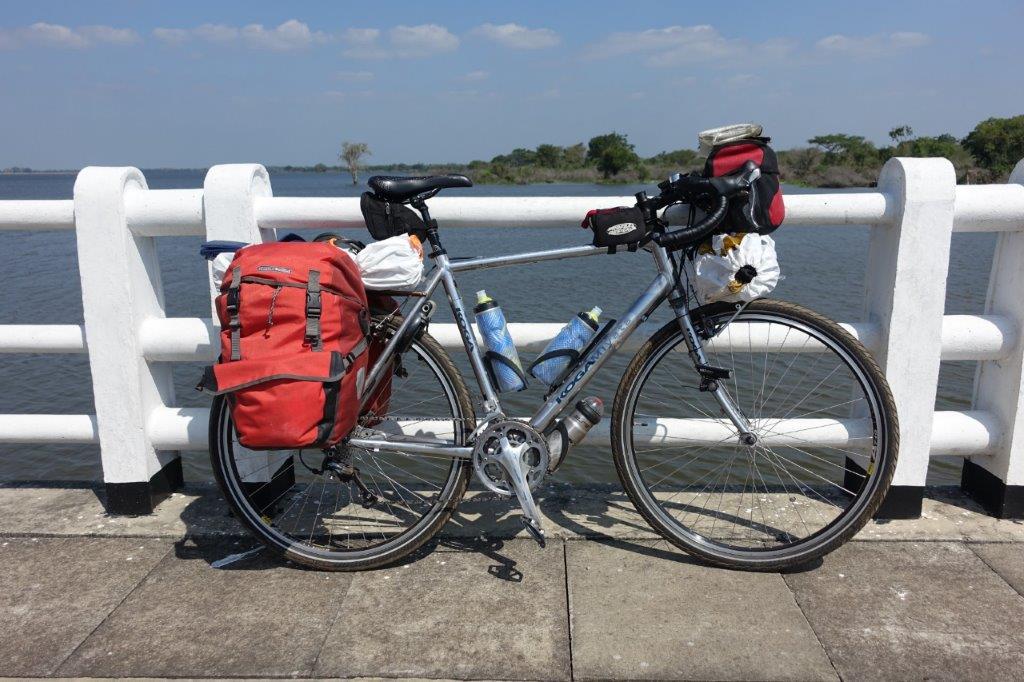 My bike
My bike
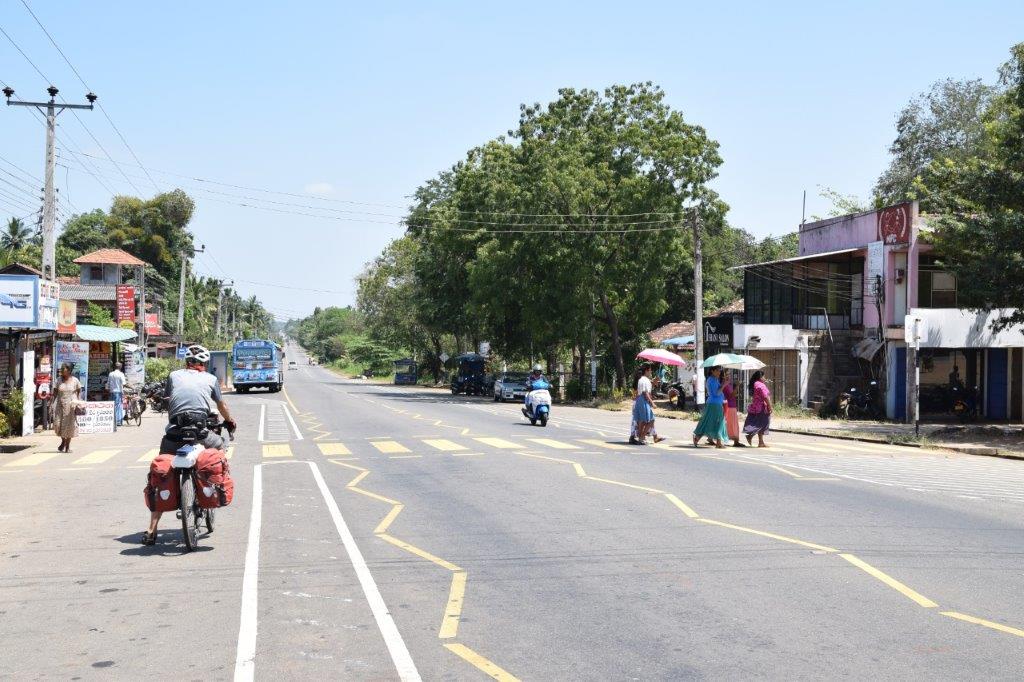 On the A12
On the A12
We stopped for lunch at a tiny roadside place. The mother and daughter running it had little English between them but seemed delighted by our visit. They had half a dozen clay pots with various curries; we had dal and rice. We sat down at a table covered with flies, but curiously most of them dispersed as we started eating. I am not sure it boded well for the quality of the food. Even more curiously, they had no fridge, so I had a warm ginger beer. Cold curry, warm drink, hot room – it was still good to be out of the sun and not pedalling against the headwind.
 The wetlands
The wetlands
We arrived in Puttalam and soon found our hotel, the Milano Rest House, which is very nice. It is down a quiet, residential street, and has a shaded veranda and leafy garden with tables and chairs. We chose a spotless family room with two huge beds for just 5,000/-. Many hotels have family rooms which are a great deal for two travellers.
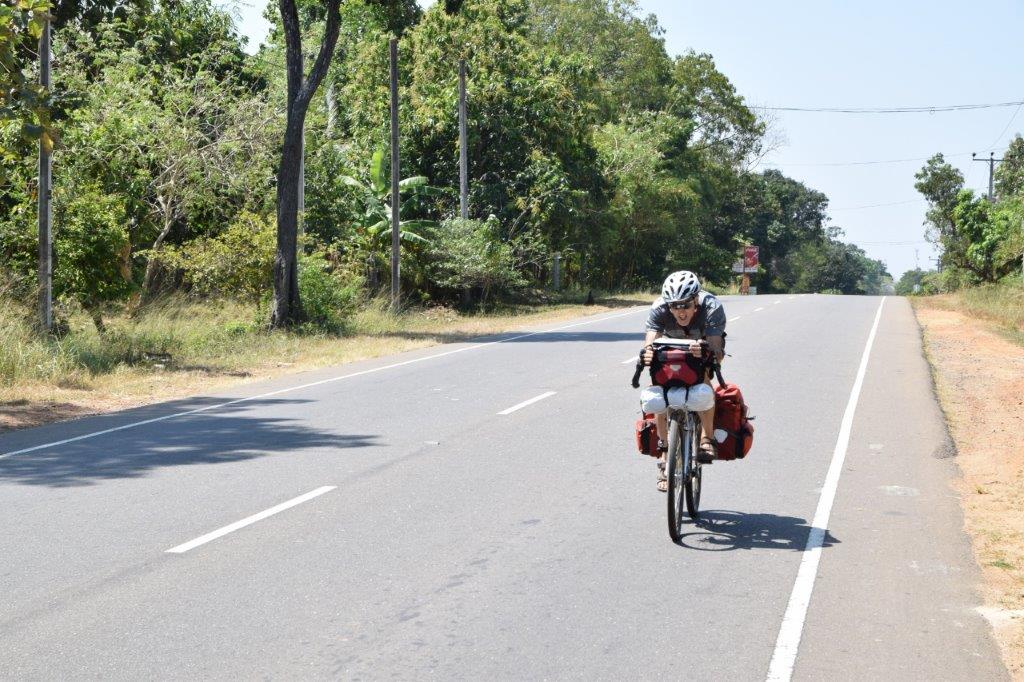
As we had had a short day in the saddle, there was still plenty of time for sightseeing. We cycled to a Buddhist temple, Isurumuniya Rajamaha Viharaya, next to Thissa Wewa “tank”, one of many reservoirs around the city. The temple is built on and around a small rock outcrop which you can climb up.
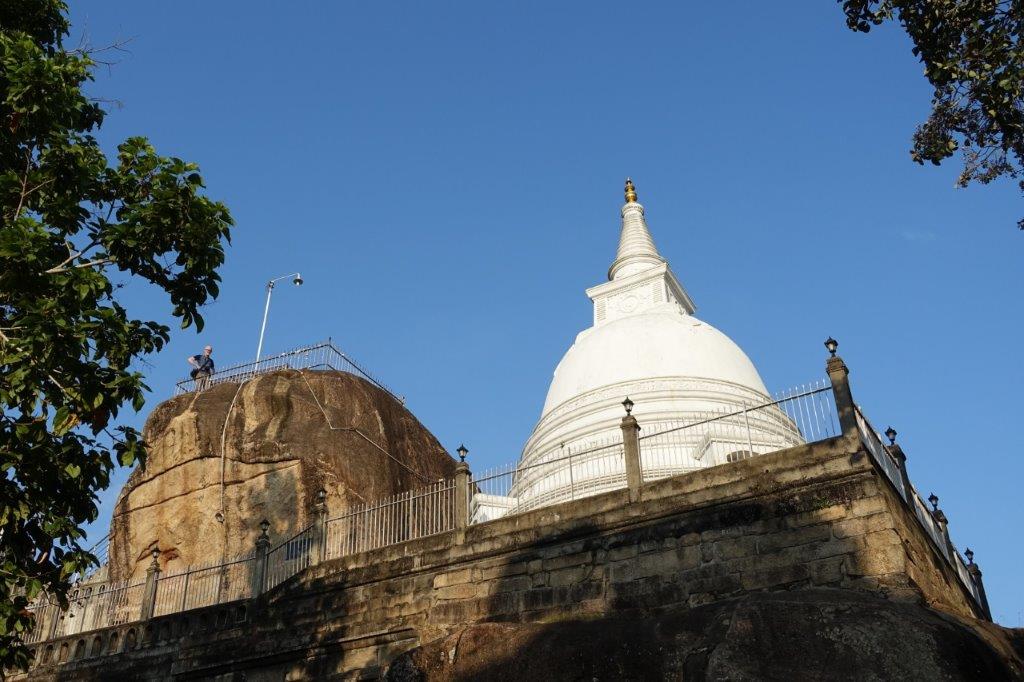 Isurumuniya Rajamaha Viharaya
Isurumuniya Rajamaha Viharaya
We then rode to the adjacent Ranmasu Uyana Royal Park which was free to enter. We had it completely to ourselves, so we took pictures of the somewhat dilapidated water gardens and statues which were home to numerous small monkeys, and if you believe the “Beware of Crocodiles” signs, some rather larger creatures. We cycled through the gardens and up on to the path around the reservoir in time for a beautiful sunset. This brief sightseeing had whetted our appetites, so we decided to stay another day in Anuradhapura. It would give our burgeoning saddle sores a chance to recover.
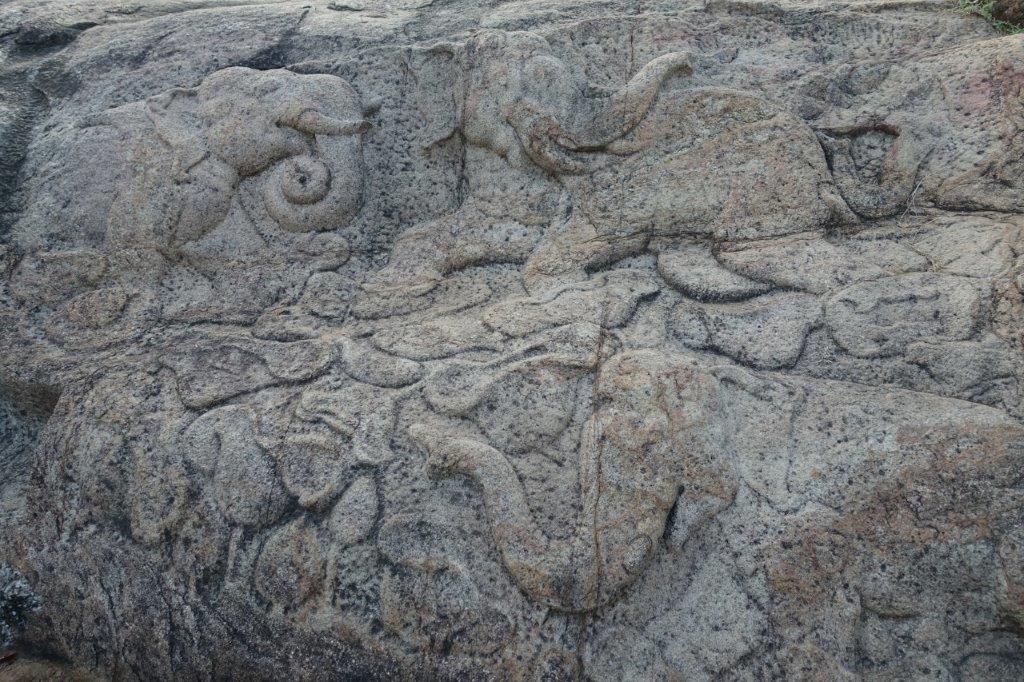 Elephant carvings in Ranmasu Uyana Royal Park
Elephant carvings in Ranmasu Uyana Royal Park
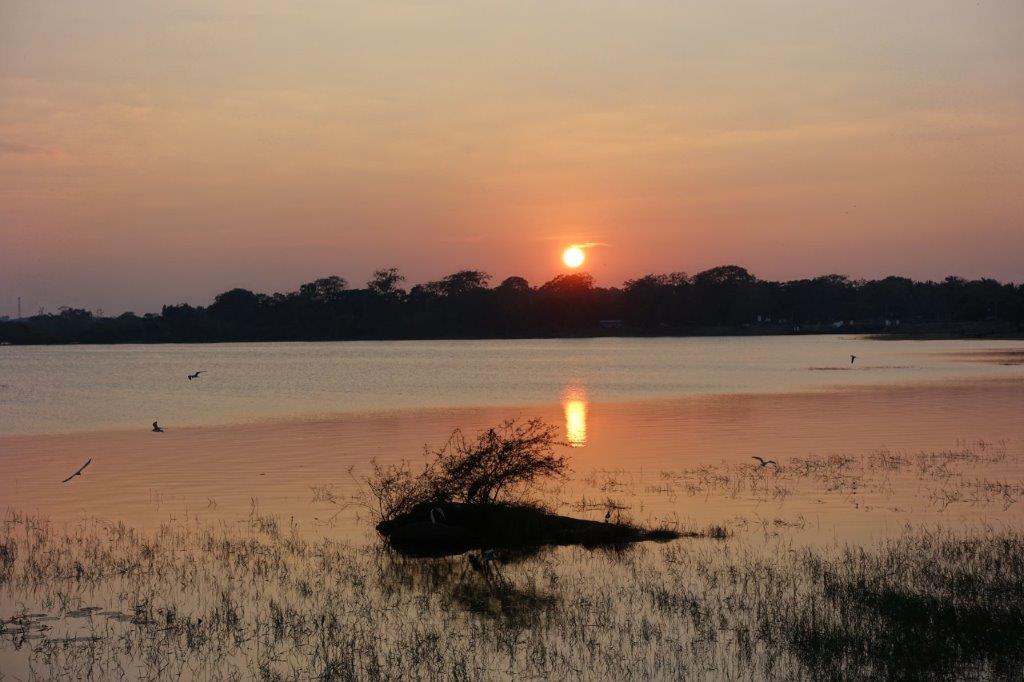 Thissa Wewa
Thissa Wewa
Wednesday, Feb 19 – sightseeing around Anuradhapura
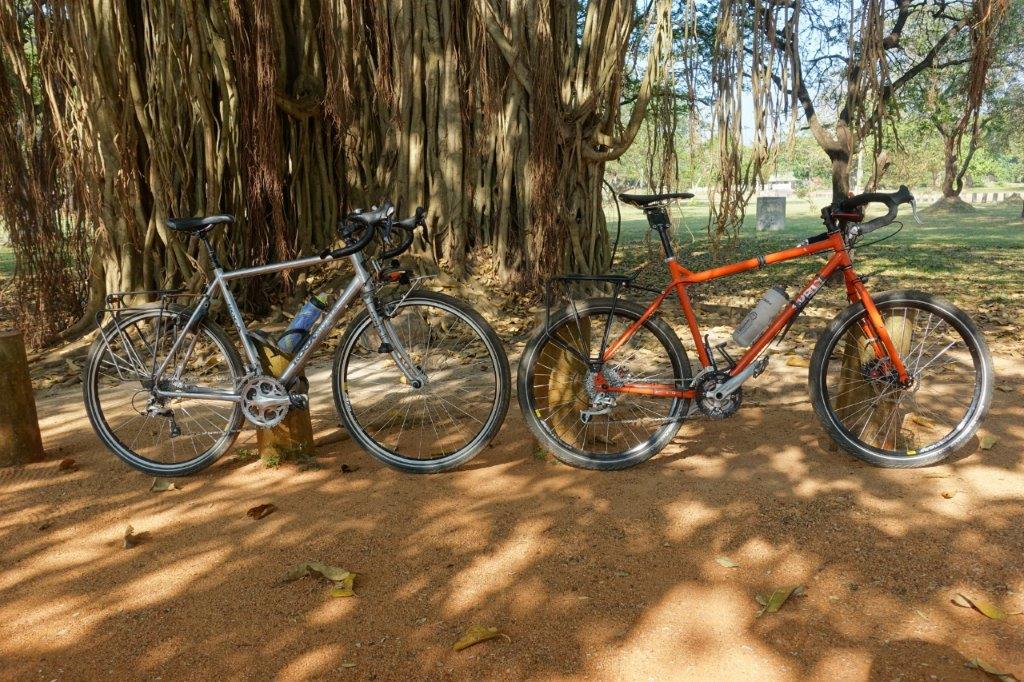 Jethawana Museum Gardens
Jethawana Museum Gardens
We spent the day cycling around the numerous World Heritage Sites of the ancient city. The sites are spread out away from the city, so we spent much of the day riding on quiet, leafy lanes and walking around beautiful ancient monuments. It is fine way to spend a day. First, we had to visit the Jethawana Museum to buy $25 combined tickets for the main sites. It was expensive but well worth it. The museum was closed for renovations, but we were surprised to learn we could ride through the tranquil grounds around Jethawanaramaya Dagoba, an impressive red-brick stupa. We pedalled along ochre dirt paths beneath spreading banyans with views of ancient ponds and stone ruins.
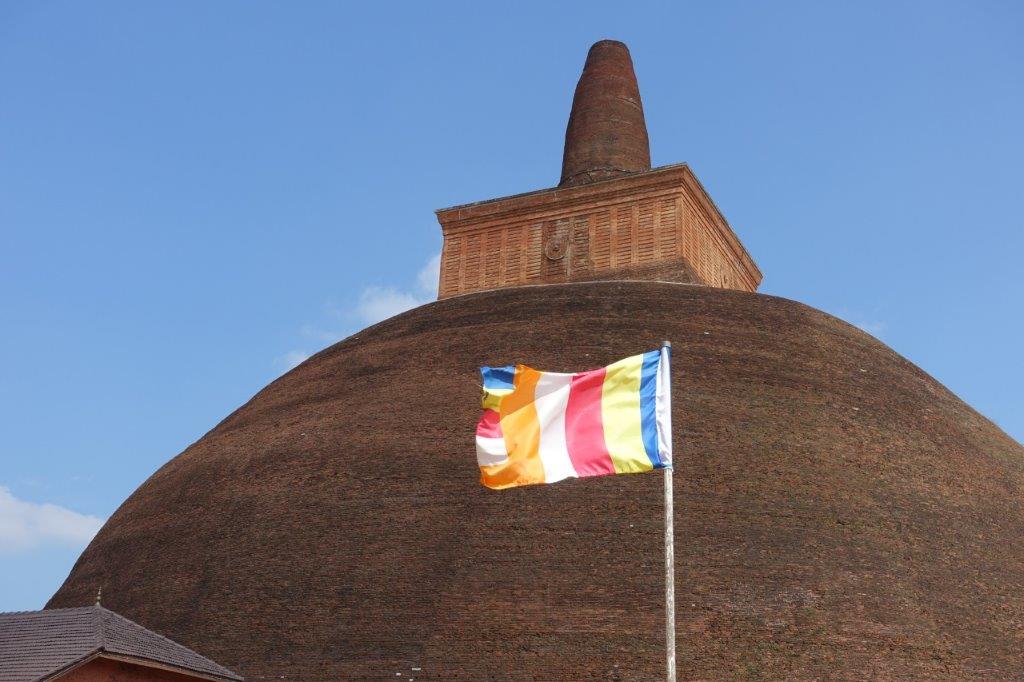 Abhayagiri Dagoba
Abhayagiri Dagoba
We headed north to the Twin Ponds and then around the various sites of Abhayagiri Monastery, including the huge dagoba. Apart from the dagoba, there are no particularly impressive single sites, but it is pleasant just to ride amongst the trees and ruins. We stopped at a stall for ginger tea, delicious vegetable roti, and milk drunk straight from a king coconut.

Next we visited Ruvanvelisaya Dagoba, but it was getting too hot to be out in the sun. We rode back across town to the Lakeside Hotel, recommended by Lonely Planet, but only able to serve an overpriced but undersized fish on rice. We then got pestered to pay the bill; there seems to be an inverse relation between the strength of the recommendation in LP and the quality of the experience.
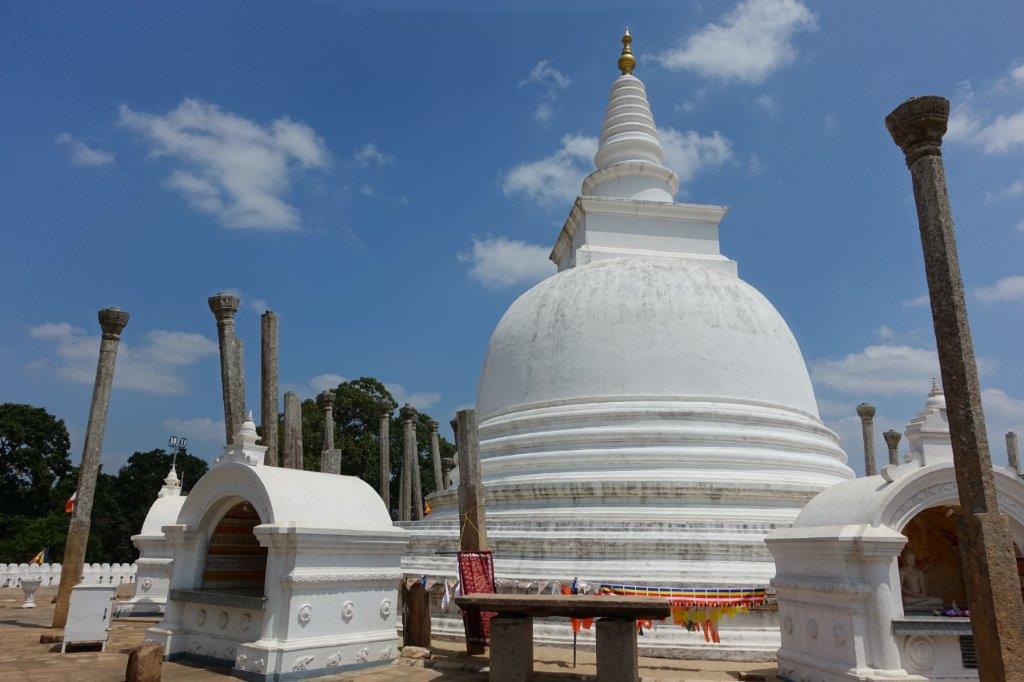 Ruvanvelisaya Dagoba
Ruvanvelisaya Dagoba
After lunch, we went to another dagoba, Ruwanweli Maha Seya, where we skipped barefoot across the burning stone floor from one coir mat to the next. At all the main Buddhist sites we had to remove sandals and hats, which is not ideal in the baking sun. We finished off at Sri Maha Bodhi which is a cutting from the tree under which Lord Buddha attained enlightenment. It was touching to see people picking up bundles of leaves from the ground as mementos.
 Lotus flowers
Lotus flowers
We returned to the Milano GH to relax in the garden and drink gallons of tea while planning our next couple of days. The hotel manager recommended we visit another important Buddhist site, Tantirimalai Rajamaha Viharaya, which offered us a circuitous route on quieter roads to our next destination, Vavuniya.
Thursday, Feb 20 – Anuradhapura to Vavuniya, via Tantirimalai 88 km
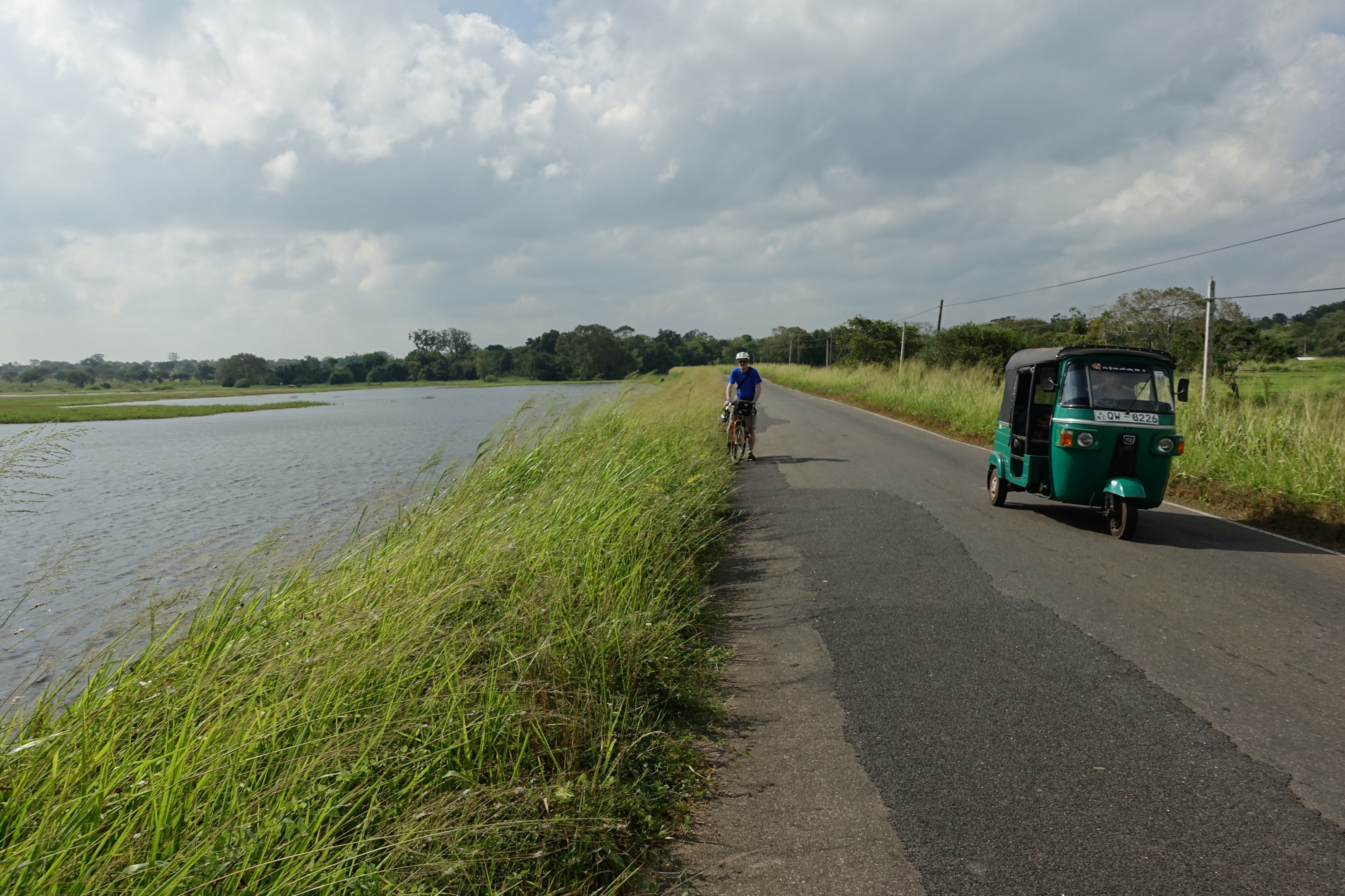
We got this day just right. Instead of following the direct route to Vavuniya, we concentrated on finding the best roads for cycling. We had a 7 a.m. breakfast and headed out through the mad rush of central Anuradhapura. The traffic quickly quietened down as we skirted Thissa Wewa reservoir and then turned off on a minor road towards Tantirimalai. We were heading north-west so the wind was for once not in our faces, and we could enjoy pootling along quiet roads through the beautiful landscape of shallow ponds covered in lilies and lotus flowers, vivid-green rice fields, and swaying palm trees.
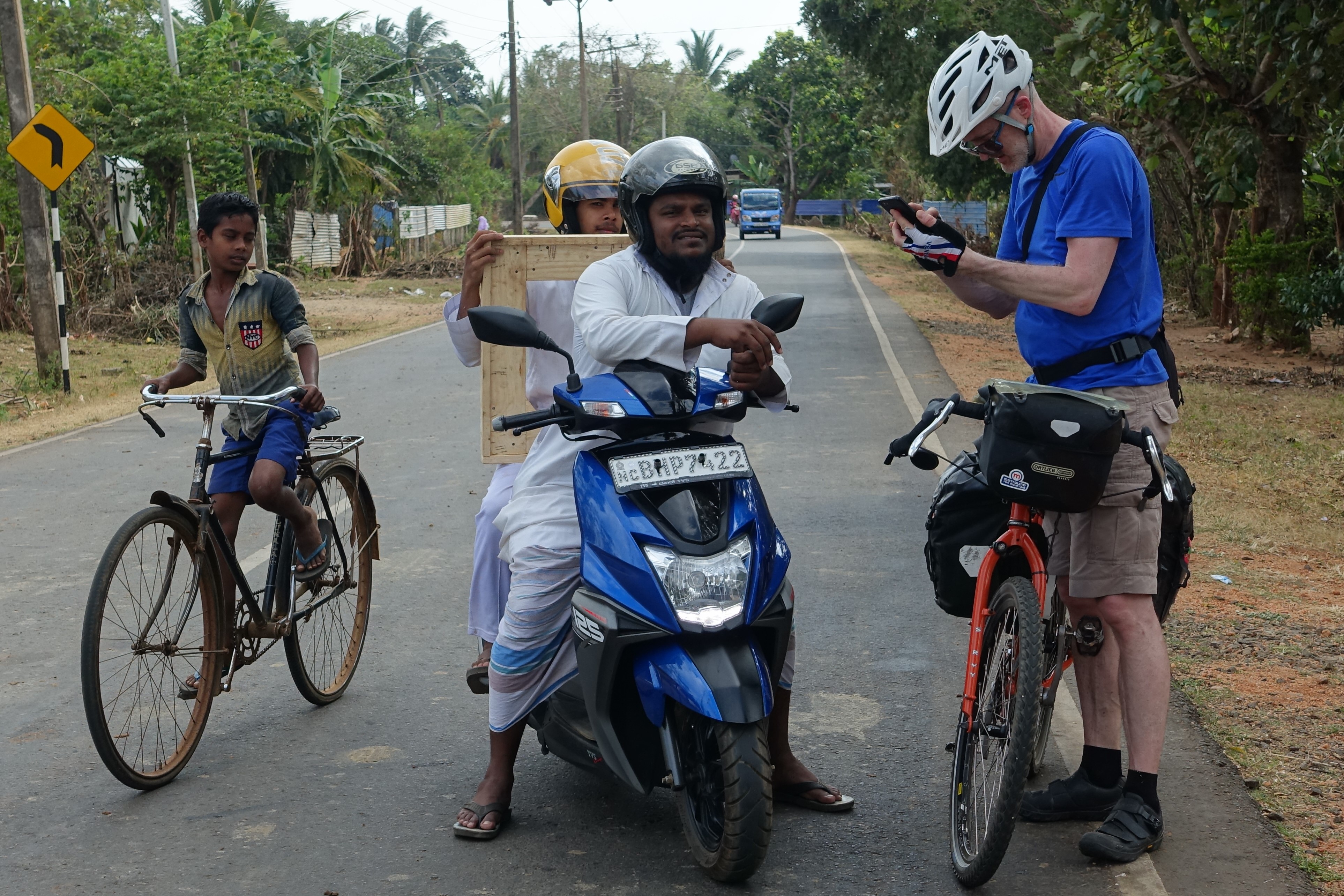 Exchanging contact details on the road
Exchanging contact details on the road
And the people! Are Sri Lankans the friendliest people in the world? Those who didn’t shout “Hi!” or “Good morning” would at least smile or wave. Greeting people was becoming a big part of our day. There are a lot of people along the way and we greeted almost every one of them. At times, motorcyclists pulled alongside us for a chat before pulling away. The conversation always involves, “Where are you from?”, “Where are you going?”, and “How long are you in Sri Lanka?” Many people would ask, “What do you think of Sri Lanka?” It was an easy question to answer…much easier than question two, as we could rarely remember or pronounce the names of the places we were heading towards.
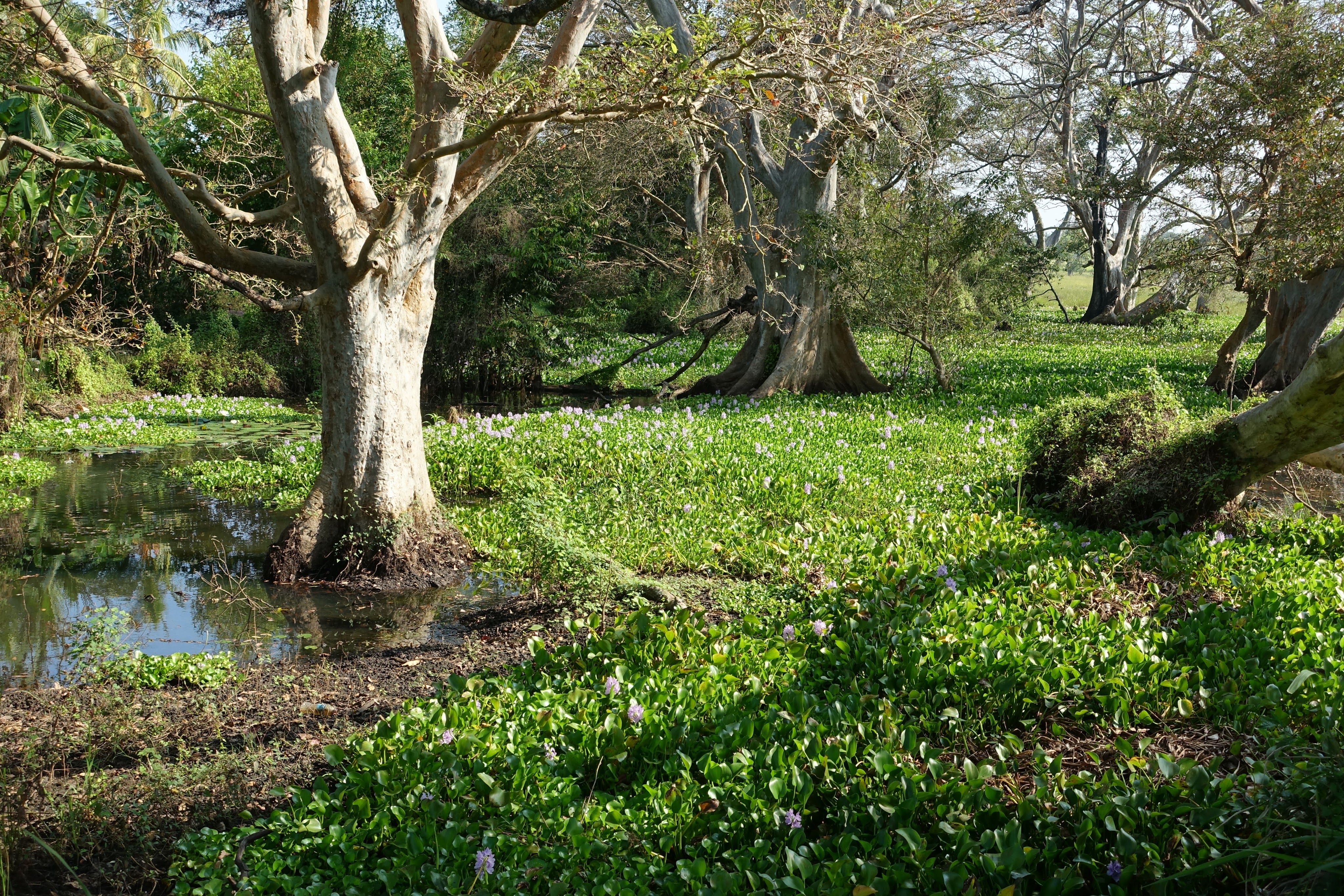 Flower-carpeted wetlands
Flower-carpeted wetlands
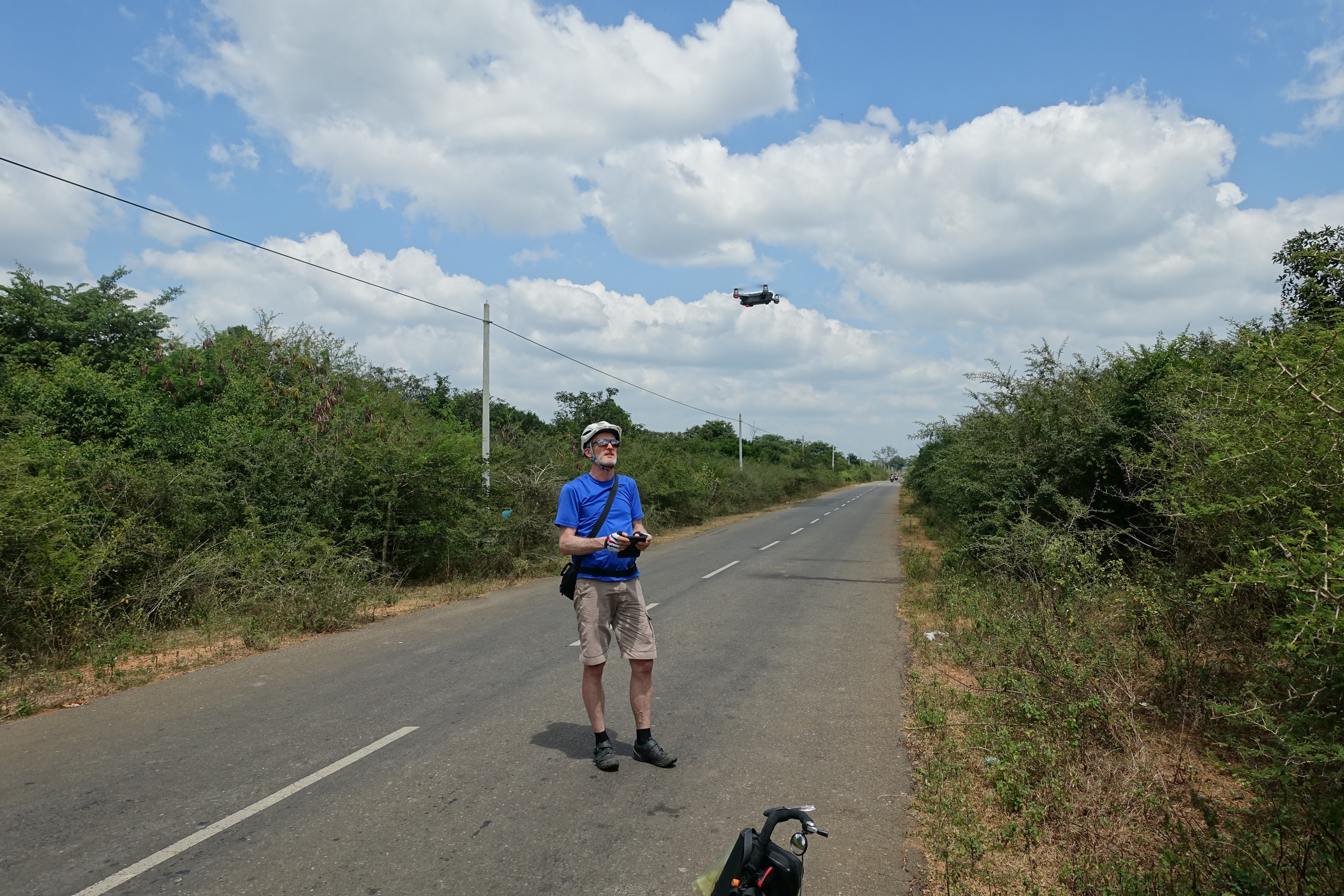 John and his drone
John and his drone
Although there is no clear road to Tantirimalai on the Michelin map, the route was clearly signposted. With little traffic and a smooth asphalt surface, it was fine riding. We were enjoying ourselves so much that we cycled right through Tantirimalai before we realised we had arrived. The monastery was back in the centre of the tiny village behind a new wall that looked more like an upscale resort than an ancient monastery. We cycled in and parked our bikes by the small museum at the entrance to the main site. There is always the quandary of what to do with luggage when visiting somewhere while cycle touring. We decided to leave the panniers on the bikes, lock them together, take our bar bags, and hope for the best. Later we were told that theft is unusual in Sri Lanka as the punishments are so harsh. It is hard to know how true this is, but it feels like a really safe country.
 Reclining Buddha, Tantirimalai
Reclining Buddha, Tantirimalai
Tantirimalai is a lovely place for a short visit. Dome like rocks topped with shrines rise out of shallow ponds. There is a small, pure-white dagoba, an ancient reclining Buddha, and splendid views across the tree-covered plains below.
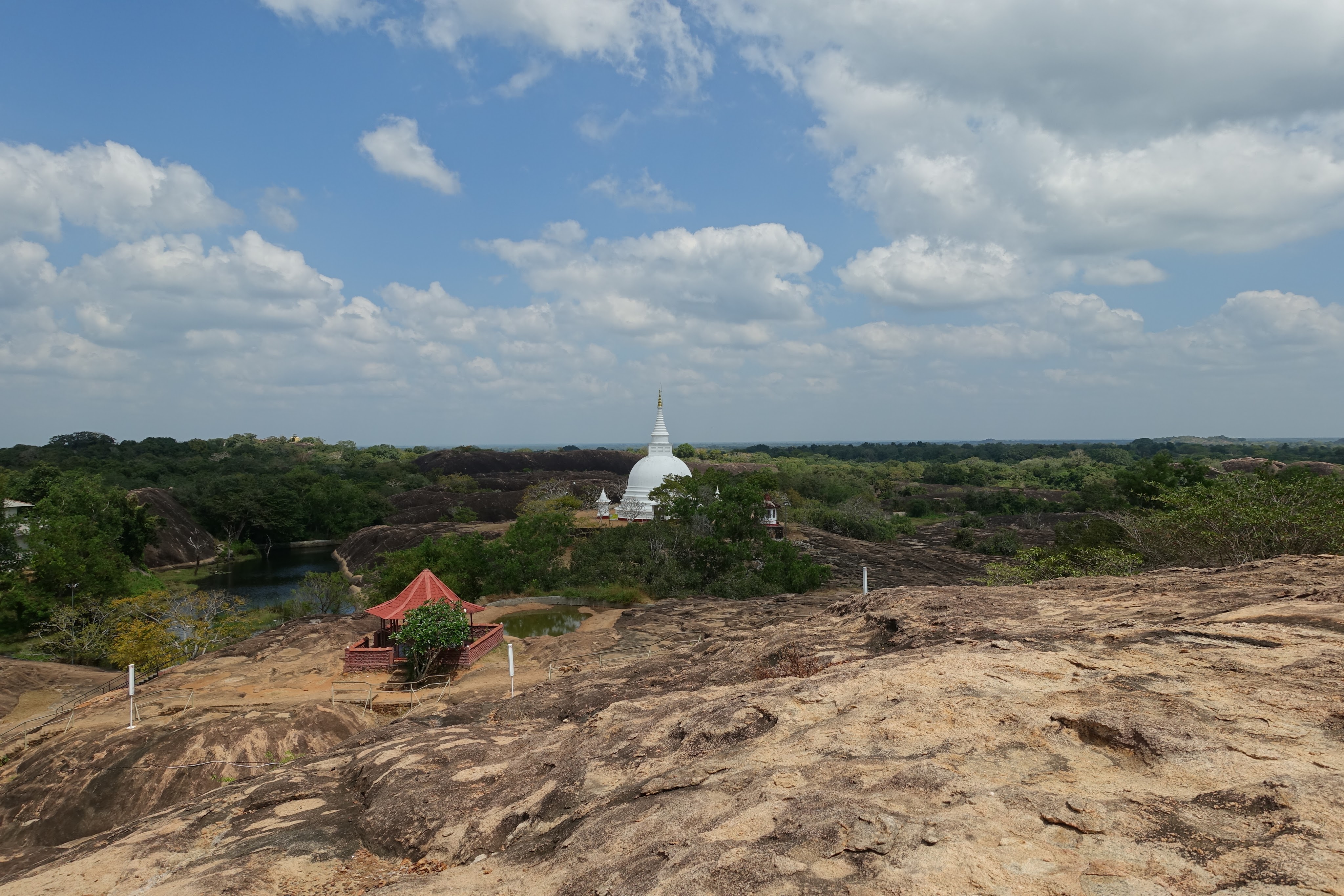 Tantirimalai Dagoba
Tantirimalai Dagoba
There is not much to do in the village itself, so we continued along the road in search of somewhere to eat. We soon found a basic restaurant with a covered eating area and a small shop. The whole extended family was working there – such a different life from the modern nuclear family. Judging by their constant talk and laughter, we in the West have lost at least something. We had the usual dal, vegetable curry, and rice, on a plate wrapped in a plastic bag. For some reason, many of the places we ate served food in this way; is it to save on washing up? Is it considered more hygienic?
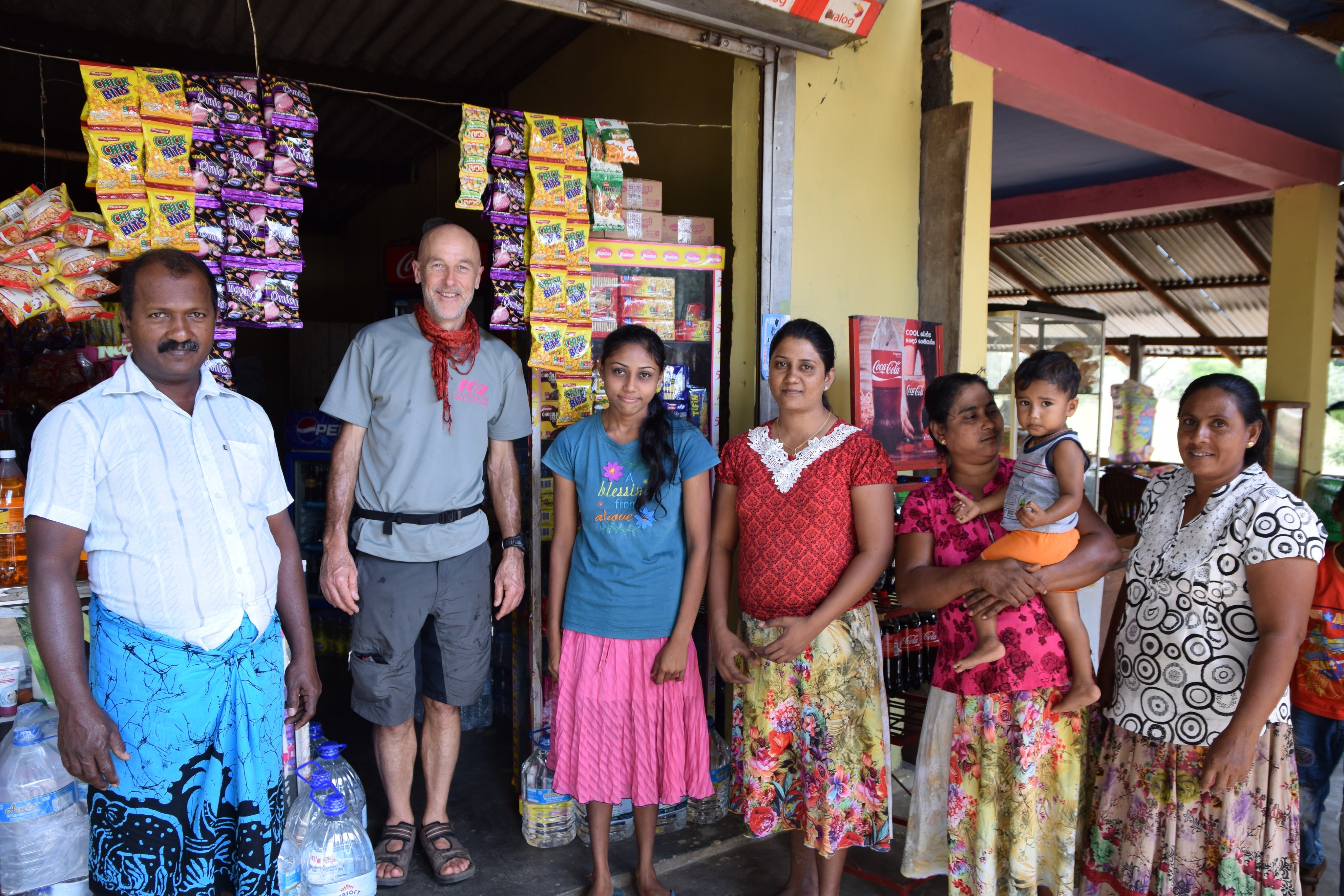 Lunch stop
Lunch stop
After lunch, we cycled to the main A14, turned right, passed through our first army checkpoint, and then left on to a minor road two kilometres later. Here we hit our first poor surface – a bumpy and very uncomfortable patchwork of endlessly repaired asphalt which jolted and jarred us mercilessly. Where possible, we cycled along the gravel verges which were much easier on us. At least the road was very quiet until we reached the A30 which took us the last few kilometres into Vavuniya. We tried several “hotels” marked on Google Maps, none of which existed, before choosing a hotel recommended in the guidebook called Nelly Star. It is a big place with a huge event room, a bar, and a dubious-looking pool.
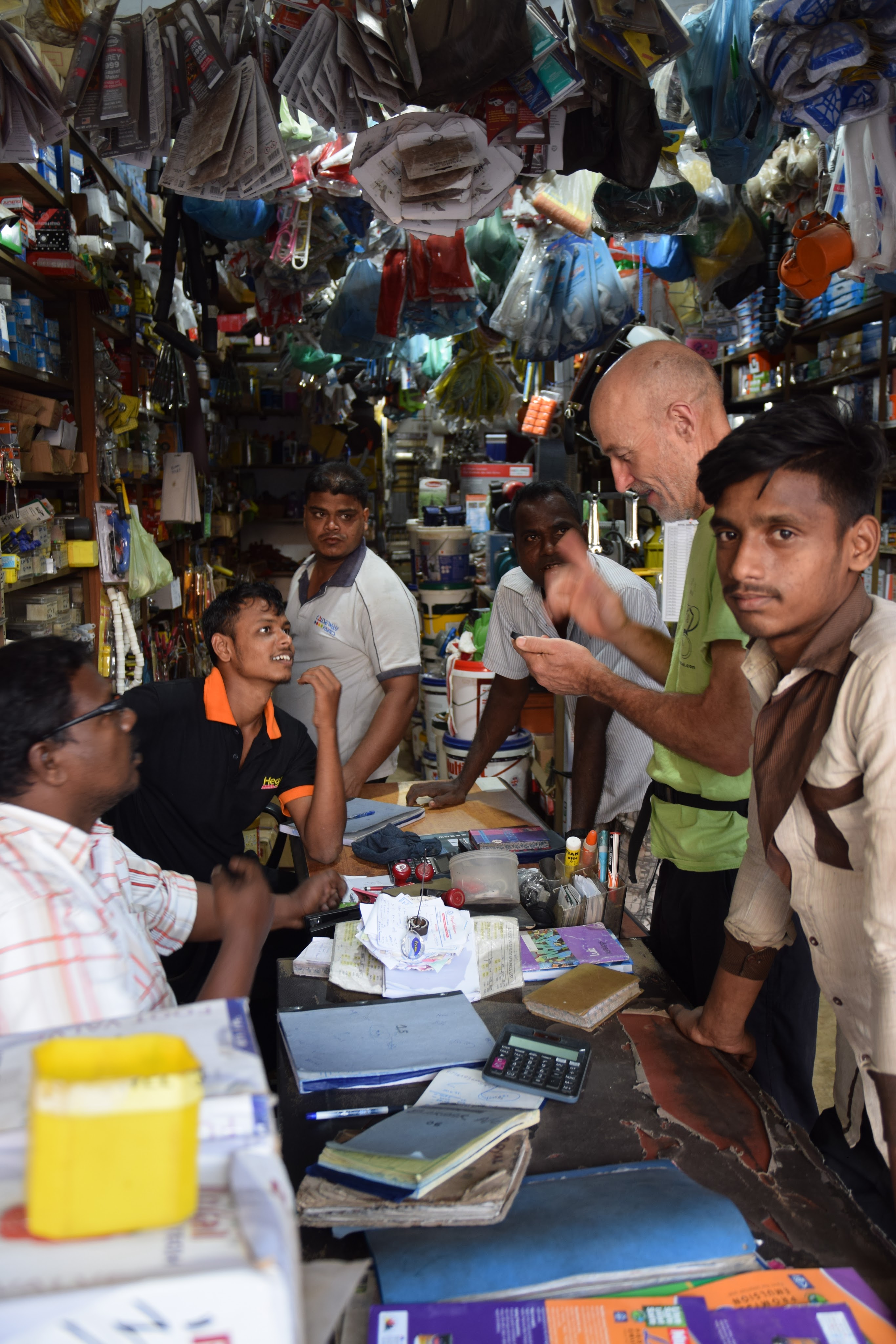 Buying glue with the help of Google Translate
Buying glue with the help of Google Translate
It was mid-afternoon, so we wandered around the busy town centre where I bought some contact adhesive (“multi-bond”) to repair the pockets which had fallen off my bar bag. Ortlieb is no longer the reliable bag maker it once was. We then ate at the Madras Indian restaurant which is close to the hotel back on the main A9. There we had pretty good Indian food including my beloved alu mattar. It turned out to be one of the best meals we had in Sri Lanka. Once more we discussed whether to ride to Jaffna, and once more we put the decision off. We would decide on the road.
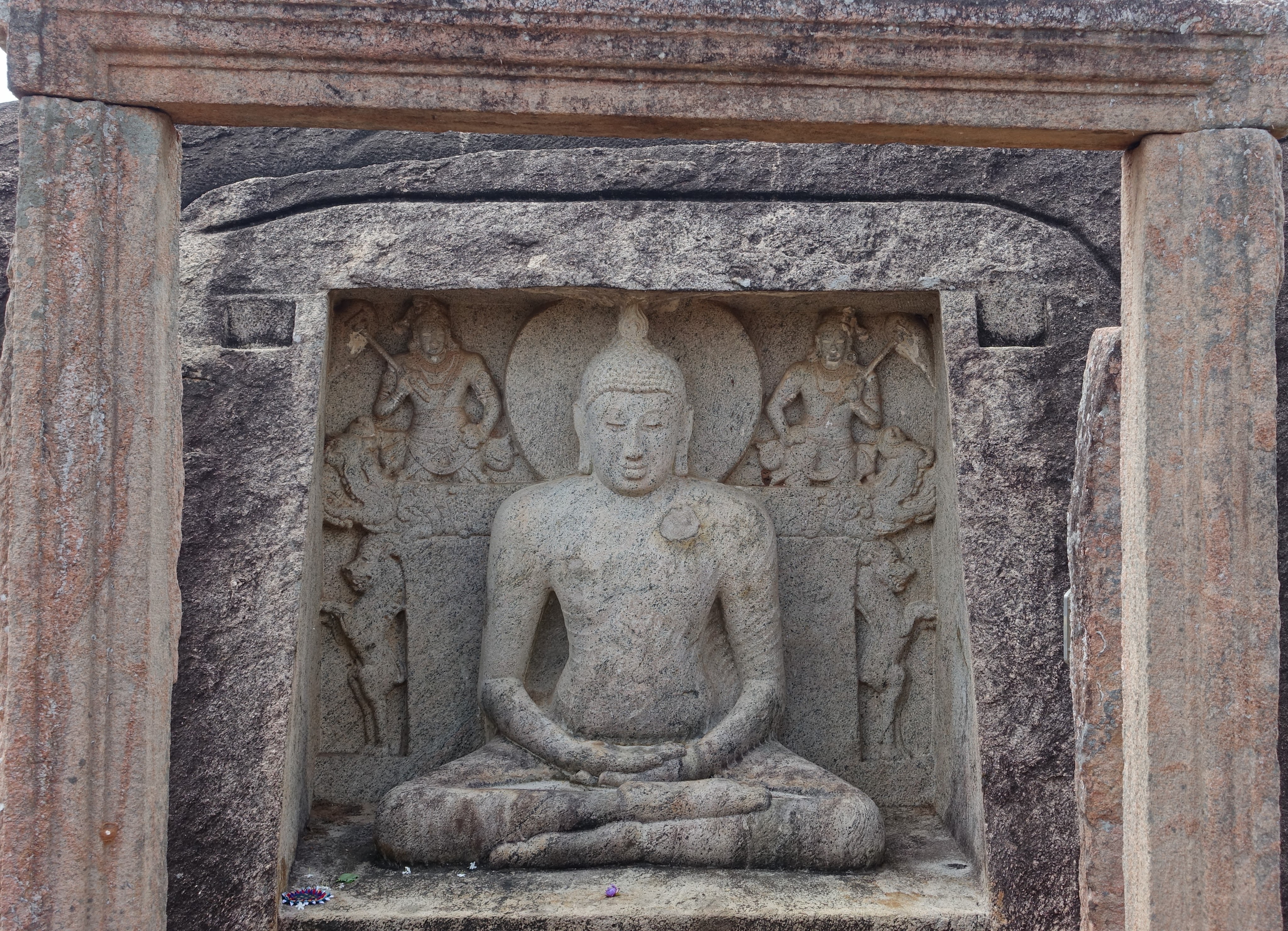 Seated Buddha, Tantirimalai
Seated Buddha, Tantirimalai
Friday, Feb 21 – Vavuniya to Jaffna 160 km
This was a long, long day. At 160 km, it was the furthest I had ever ridden on a touring bike, with all but 40 km into a strong headwind. Towards the end of the day, we had a few rain showers, culminating in two torrential downpours as we approached Jaffna. Much of the day was on A roads, not so busy as to be irksome, but busy enough that we had to stay alert the whole time. As much as I like cycling, I don’t want to have too many more days in the saddle like this.
The first 45 km were north on the A9 which is busy but has a shoulder to ride on. At Pullyankulam, we reached a fork in the road and a decision had to be made. To the right, the B296 ran north-east towards Mullaitivu, and straight on the A9 continued north-west towards Jaffna. The road to Jaffna was busy with traffic, the scenery was unvarying, and the headwind brutal. But at the end of it lay Jaffna which somewhere along the way had become an essential place to visit. We continued north.
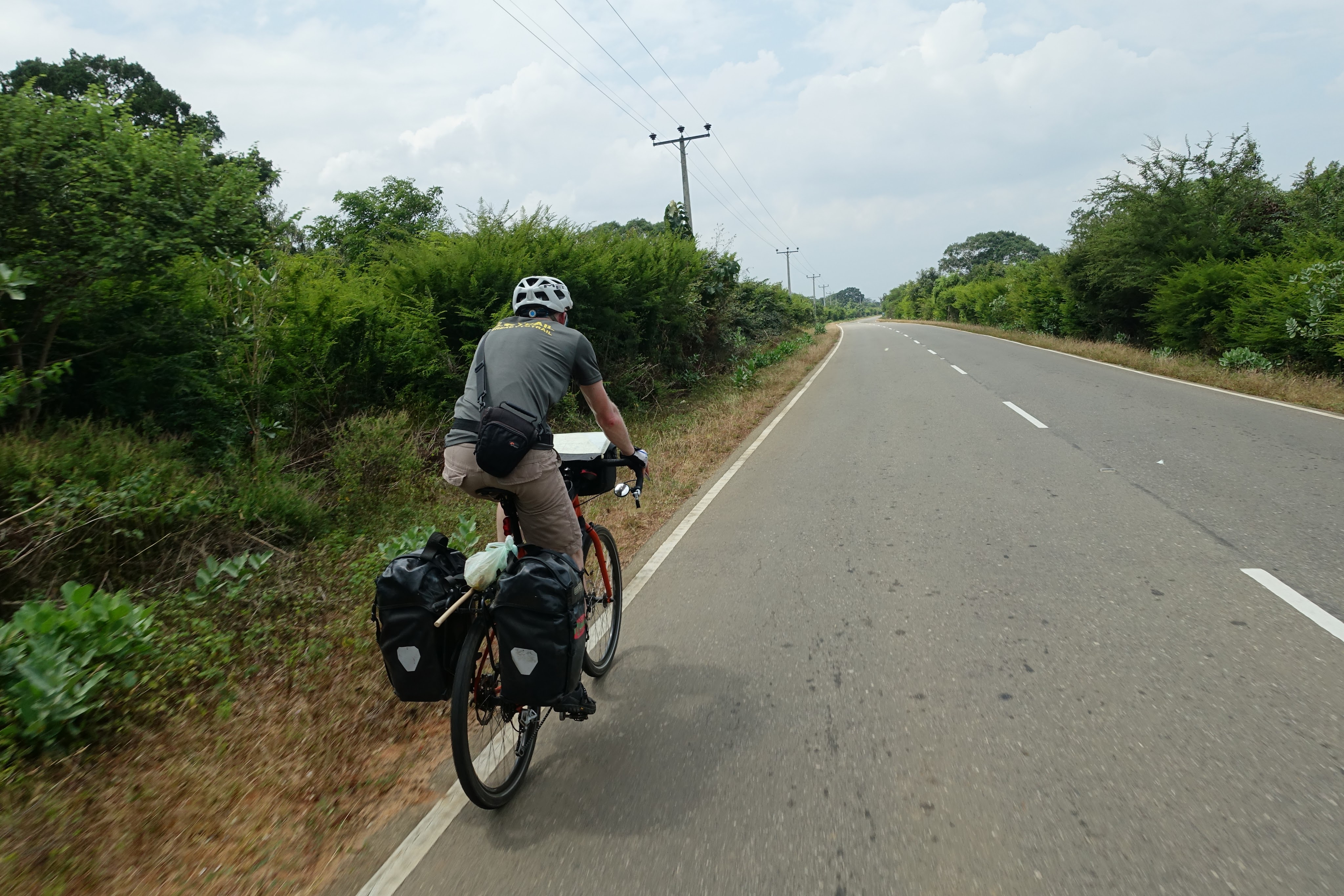 The B269 to Vellankulam
The B269 to Vellankulam
At Mankulam, we stopped for a cold drink at a spartan roadside café which turned out to be run by the army. There are many such places in the north. We then passed through a checkpoint where bus passengers were lined up with their luggage waiting to be searched. We were waved through with a smile. We then turned left on the B269 which heads west to Vellankulam near the coast. For 42 km we cycled on a smooth, deserted road pushed along by the wind at over 30 km/h – a blissful break from the gruelling grind into the wind.
 Brief lunch break
Brief lunch break
The A32 which runs along the coast to Jaffna was a bit disappointing. There was more traffic than we had hoped, the headwind was even stronger, and there were no hotels. We kept looking out for a hotel, but there was nothing all the way to Jaffna. We stopped for lunch at a cluster of shops around a noisy Hindu temple just north of Vellankulam. We had a quick, joyless rice and curry and then went back out into the heat to tackle the 63 km left to ride to Jaffna. We took turns at the front, down in the drops, once more grinding into the wind. This is the toughest kind of riding. Usually, you can shift your riding position and relieve your body as the road goes up and down, or just freewheel for a few moments on the flat. Riding into a headwind on a flat road, especially loaded up with panniers, forces you to stay in exactly the same position, pushing constantly on the pedals…hour after hour after hour.
There is no shoulder on the A32, and in places the asphalt is breaking up, so we had to stay focussed the whole time. Two-and-a-half hours later we arrived at the causeway across the Jaffna Lagoon. On another day, we would have stopped to take in the spectacular vista of seabirds wading through the vast expanse of shallow water and sand flats, but we had to push hard to keep moving into the now fierce wind. Showers rolled in off the huge lagoon which forced us to wear rain jackets despite the heat.
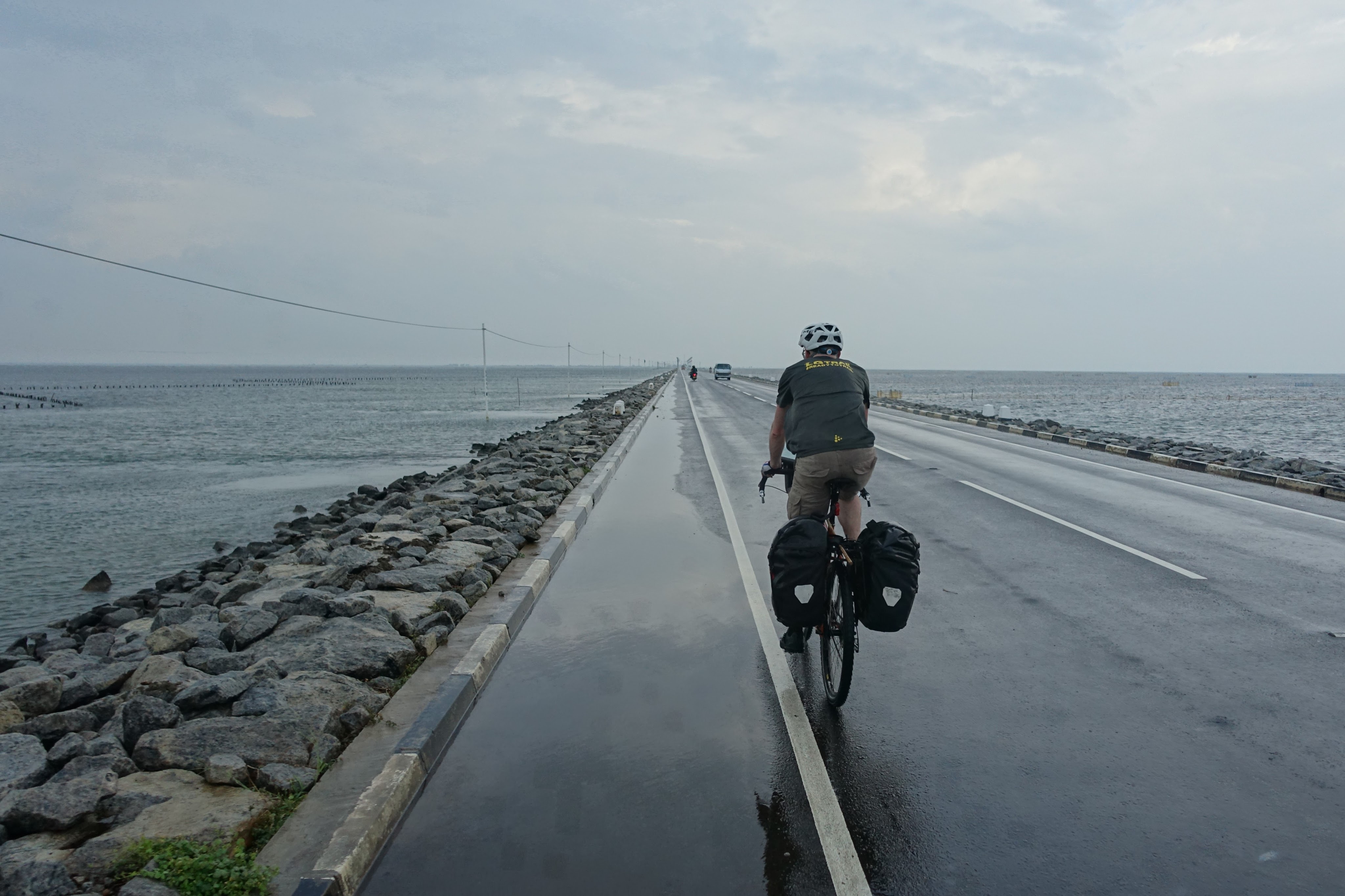 Causeway across Jaffna Lagoon
Causeway across Jaffna Lagoon
We reached the Jaffna Peninsula and gradually turned away from the wind. Just as it looked like we would arrive in Jaffna before dark, the heavens opened and we took shelter at a bus stand squashed together with several drenched people. The rain stopped as suddenly as it had started, and we managed to get all the way to Jaffna before we were forced to find shelter again from a stupendous downpour. I opened Google Maps and found the Old Park Hotel was just 350 metres away. As the rain eased a little, we made a dash for the hotel, and arrived as the rain strengthened once more. At 6000/- for a twin, it was more expensive than we had been paying, and there was something off-putting about the manager, but we didn’t want to go back out into the rain. The power went off, and we decided to stay.
The hotel itself definitely has charm. It is in an old house with a simple, beautifully furnished living and dining area. The young manager, however, was something different. He was over-attentive and obsequious in a Basil Fawlty way and shared much of his incompetence. I was shown to one room which was attached directly to the dining room. I asked to see other rooms but was told they are all the same. They aren’t. I insisted on a larger, quieter room at the back, which we were reluctantly told was available. As we started to bring in our luggage, we were told it had just sprung a leak. We reluctantly took the other room. I got ready for a shower but found it hadn’t been cleaned and the toilet showed rather unpleasant evidence of recent heavy use!
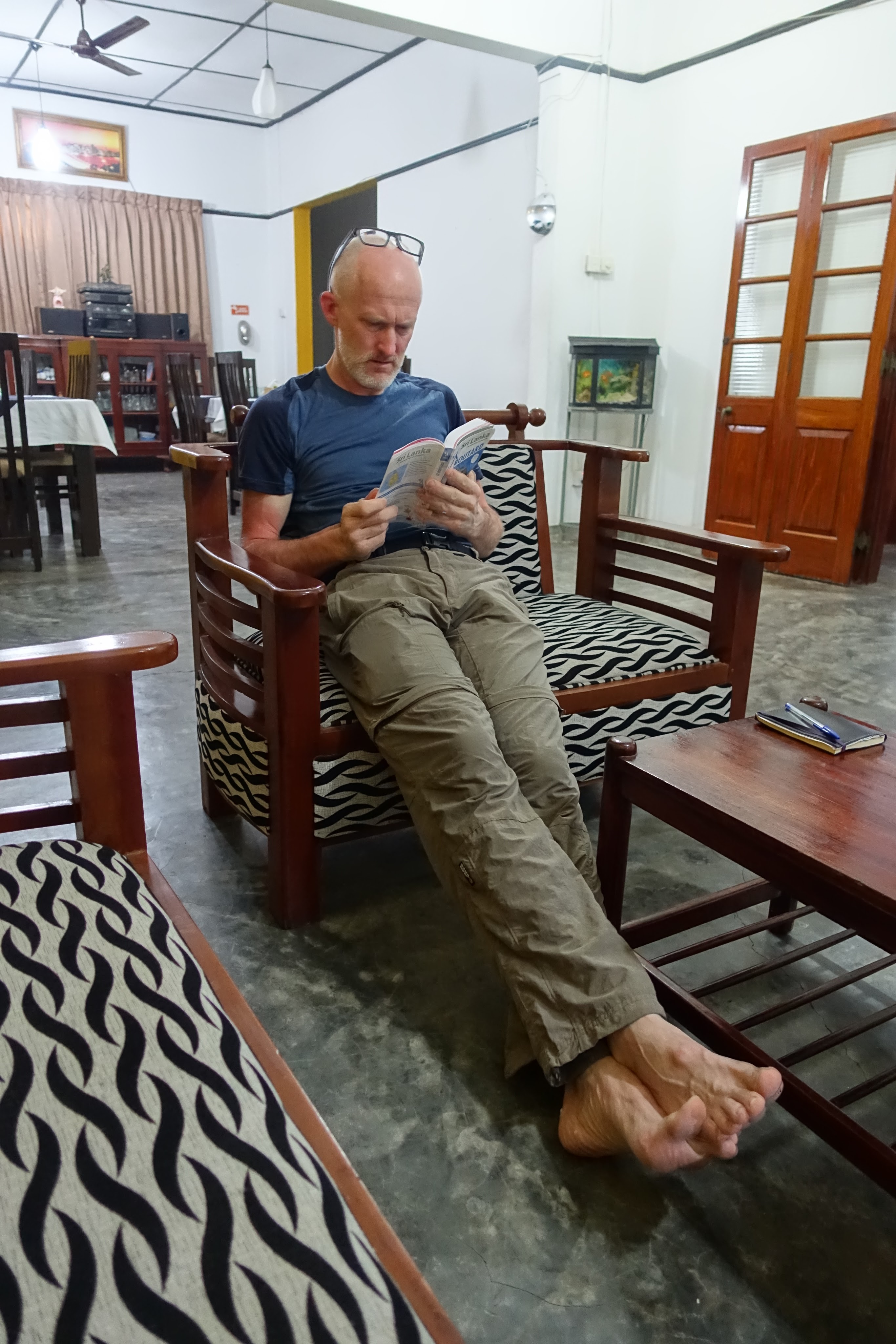 Waiting for dinner at the Old Park Hotel
Waiting for dinner at the Old Park Hotel
On arrival, I had asked about dinner, and the manager told us they had a restaurant. After showering, we were told that they do indeed have a restaurant, but it was not open. Staying calm was starting to be a challenge. It was raining outside, we had ridden 160 km into the wind, and we were very hungry. After much umming and erring, they agreed to send out for food. An hour-and-a-half later, we were still waiting in the living room, which was at least a beautiful place to wait. It turned out that they had made rice and dal in the kitchen but were waiting for vegetable curry to be delivered. We asked if we could just have dal and rice. “Please wait!” We waited and waited, but finally hunger stripped away our last vestiges of patience. We demanded dal! As we ate the admittedly tasty pulses, the curry finally arrived and we could recover some of the day’s lost calories.
Several long days in the saddle had led to both of us getting saddle sores. I also had a rash and blisters on my thighs. I had never suffered this before despite all the riding I do, but it was obvious it needed treating. We decided to spend the next day in Jaffna.
Saturday, Feb 22 – Around Jaffna Islands 55 km
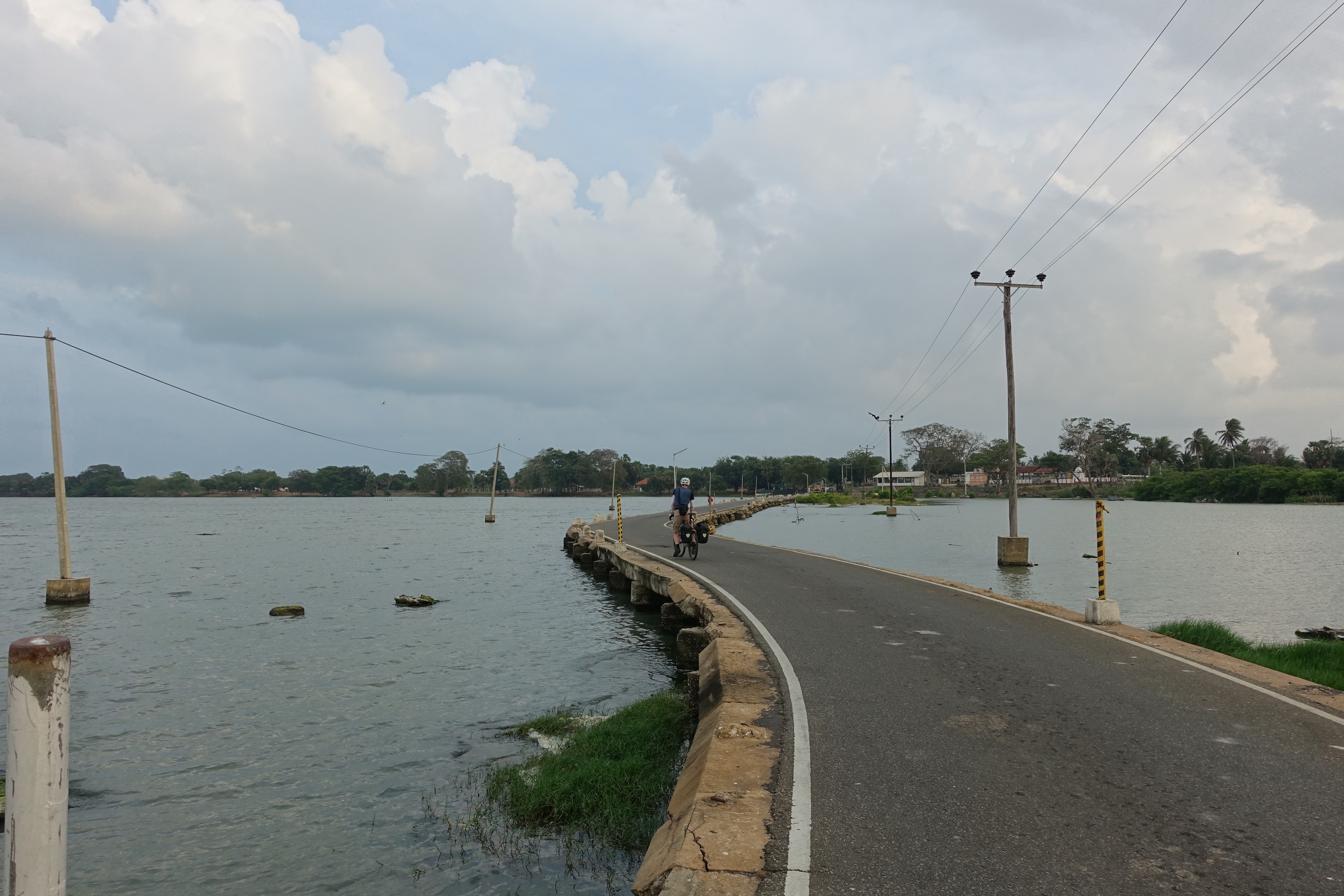 The Jaffna Islands are linked by causeways
The Jaffna Islands are linked by causeways
Our troubles with the Old Park Villa continued in the morning. After ordering toast and omelette for breakfast, our obsequious host served up dal and rice. We asked for toast and omelette, but suddenly he no longer spoke English and just pointed at the dal and rice. We’d had enough. We checked out. We moved on to the nearby Sarras Guest House which is a lovely place. Looking back, the Old Park Villa was the only minor hiccup on the whole trip. And let’s face it, a dirty toilet, a late dinner, and the wrong breakfast is not exactly a major problem. But after pushing our bodies hard, we just wanted to relax and recuperate.
 Velanai Island
Velanai Island
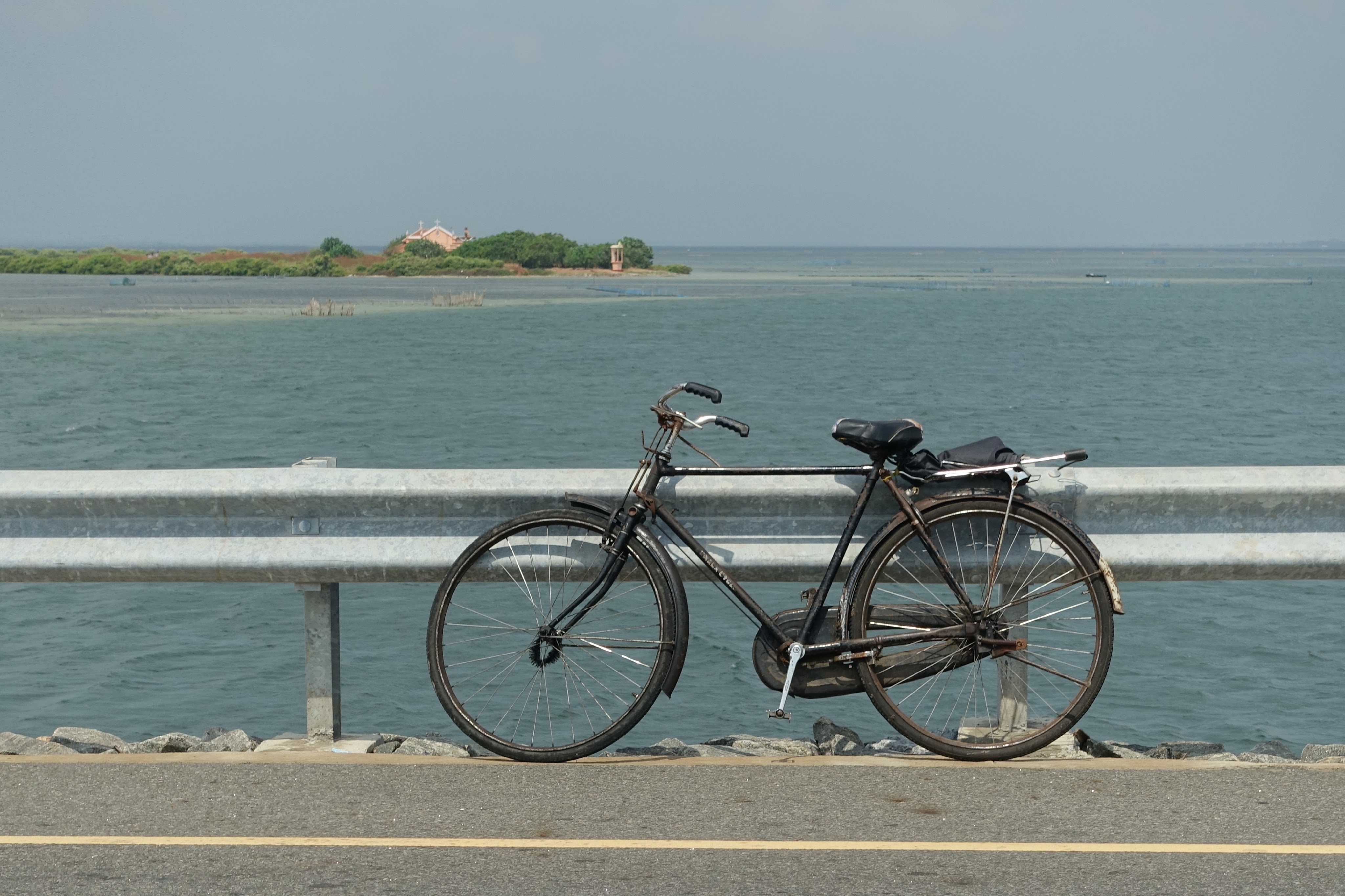 Jaffna Lagoon
Jaffna Lagoon
We had a whole day ahead of us, so we left our panniers at the Sarras GH and went in search of breakfast. We ate savoury vegetable pasty rolls and super-sweet Nescafe at nearby Dora Café, and then headed for Jaffna Fort. John did a quick tour of the fort, while I sat beneath a tree overlooking the lagoon. Next, we headed across a long causeway to Velanai Island with its mangrove lagoons and tranquil fishing villages. We visited a beach where fishermen were repairing nets, and cycled down narrow lanes to Chaaty Beach where busloads of Sri Lankan tourists were bathing, the women in their saris. After a rice and curry lunch at a scruffy place called Api Hotel in Velanai, it dawned on me that all the places called “Hotel” are actually restaurants, not guest houses. We took the almost deserted B441 to Kayts where we would catch the ferry across to the next island. Along the way, we were joined by two lads on a bicycle, one sitting on the saddle, the other on the rear rack, but both with their feet on the pedals!
 Kayts to Karaitvu by fishing boat
Kayts to Karaitvu by fishing boat
There was a 75-minute wait for the next ferry, so John successfully persuaded some fishermen to take us across the lagoon for 1000/-. The next island, Karaitvu, was even quieter, apart from a large flock of green parakeets. We returned to the peninsula by a windswept causeway which passed over a shallow lagoon with fishing huts balanced on posts, nets strung between bamboo poles, and numerous wading birds. I saw my first flamingo.
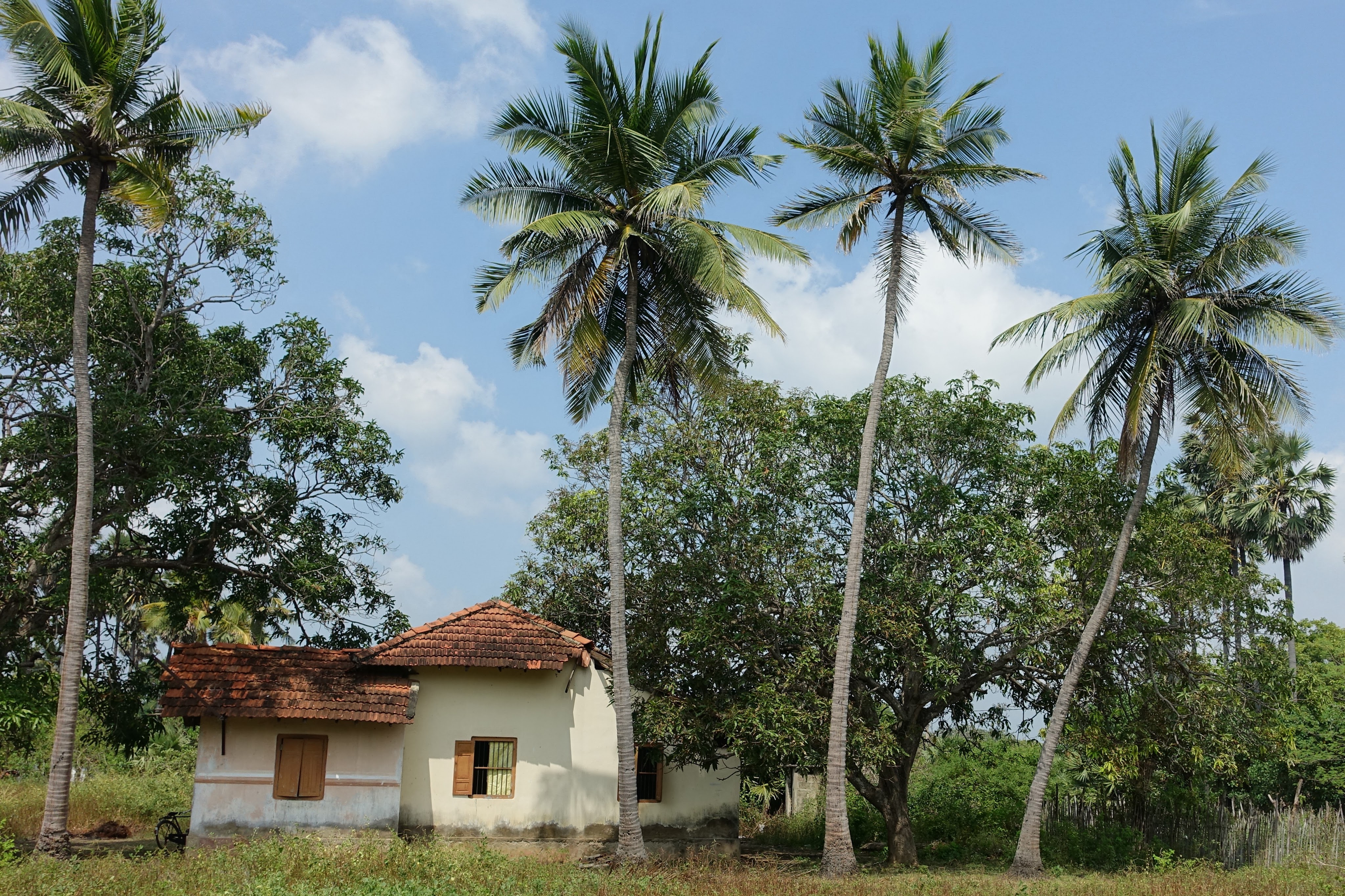 Velanai Island
Velanai Island
The last 15 km to Jaffna is on the very bumpy AB15; our poor saddle sores. In Jaffna, we stumbled upon the Malayan Café which is an atmospheric, traditional place where they ladle out huge plates of dal from a stainless steel bucket. We had tea and hard, super-sweet cakes. Super-sweet was becoming a theme. Next we went to a very helpful pharmacy where John bought expensive sunblock, and I bought calamine cream whose smell took me back to my childhood. The calamine worked wonders on my sores and rashes.
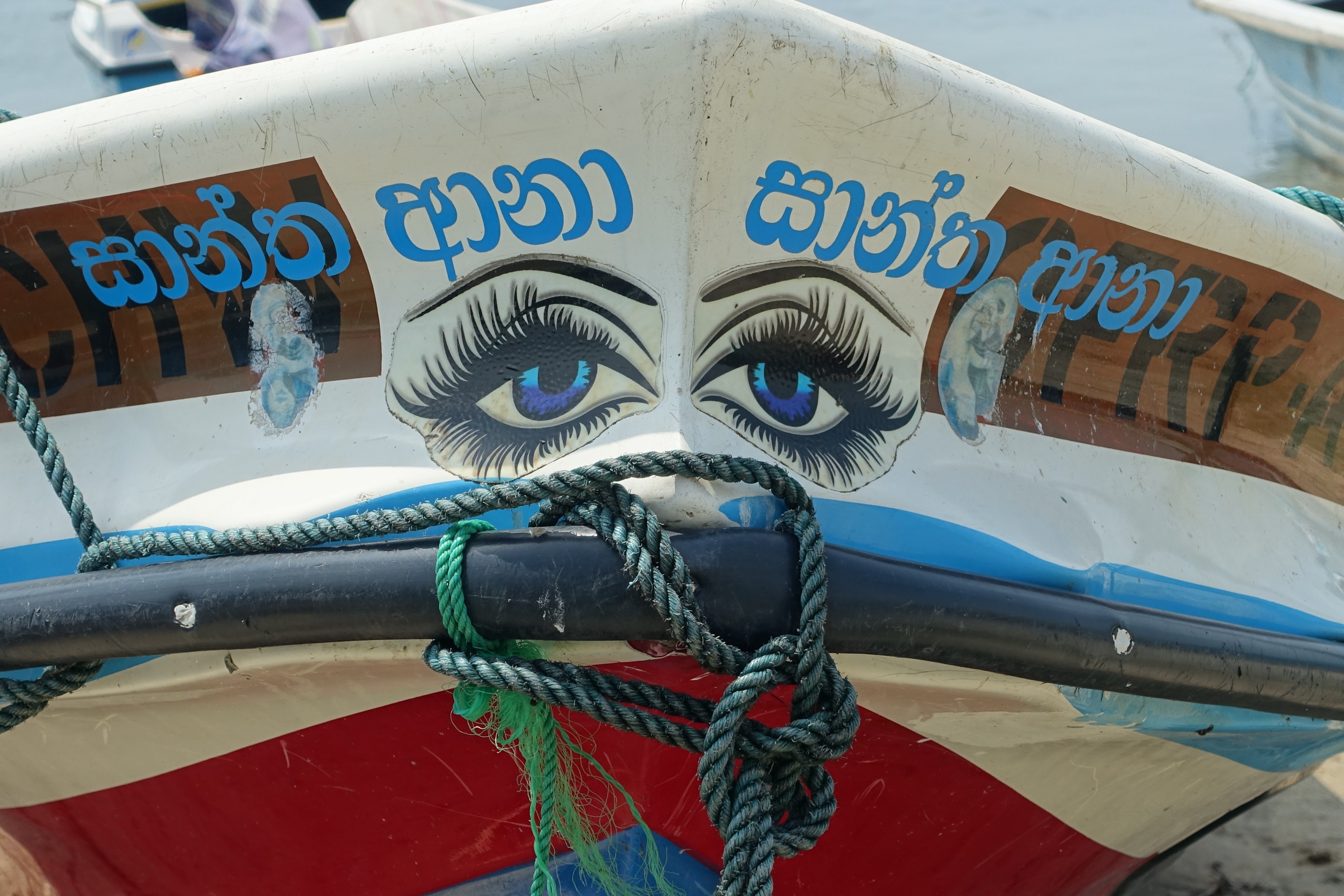
We returned to the Sarras GH to find that we had been given a free upgrade to a beautiful room with high rafters, wood floors, and a fancy marble bathroom. I went to a tiny barbershop opposite the old park for a shave, haircut (don’t laugh), and head massage. There is nothing better than the luxury of a proper shave with a cut-throat razor followed by a head pounding. A delightful luxury for 500/-.
For dinner, we cycled a couple of kilometres to the excellent Mangos Restaurant where I ate my first kotthu, a bowl of chopped up roti mixed with roasted cashews, paneer, vegetables, and spices. It was a new food for me and absolutely delicious. I risked a banana lassi which was, of course, delectable.
Sunday, Feb 23 – Jaffna to Mullaittivu 144.83 km
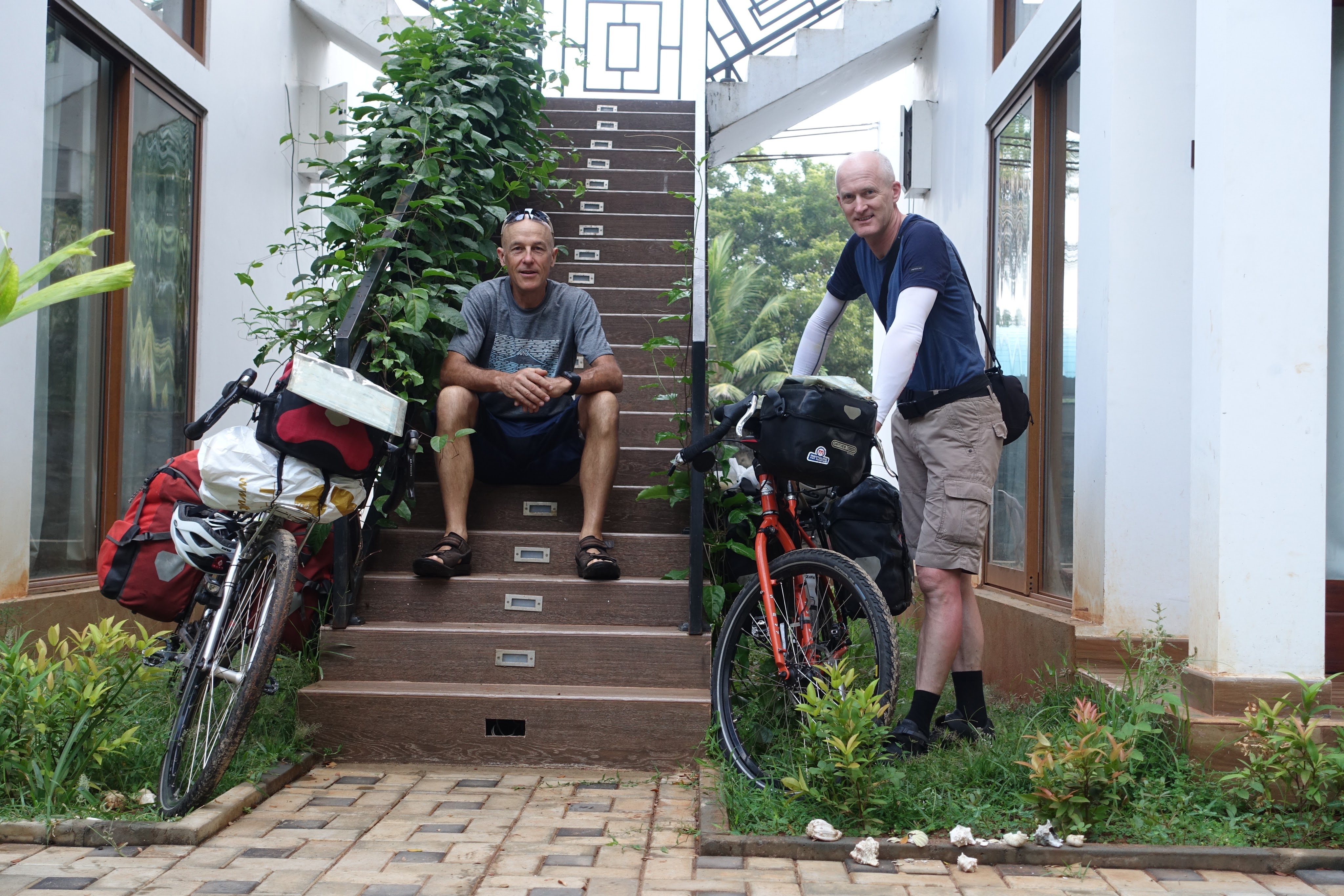 Leaving Sarras Guest House
Leaving Sarras Guest House
Another long, tough day with mostly head and swirling sidewinds, a lot of it on bumpy roads, especially around the northern Jaffna Peninsula. We hadn’t quite realised how far it was to Mullaittivu, especially as we took in the northern coast of the Jaffna Peninsula. This detour, however, was well worth it, as the coast is interesting with lots of fishing villages linked by a quiet road that runs along by the sea.
We started off at 8:00 a.m. from the Sarras GH after an insubstantial, reluctantly-provided early breakfast. We headed north-east on the AB20 and then took the B33 north to Valalai. It was straight into the teeth of the wind. The coast road was all bumpy asphalt which was hard on our behinds. I had not skimped on the Vaseline and calamine which stopped things getting any worse.
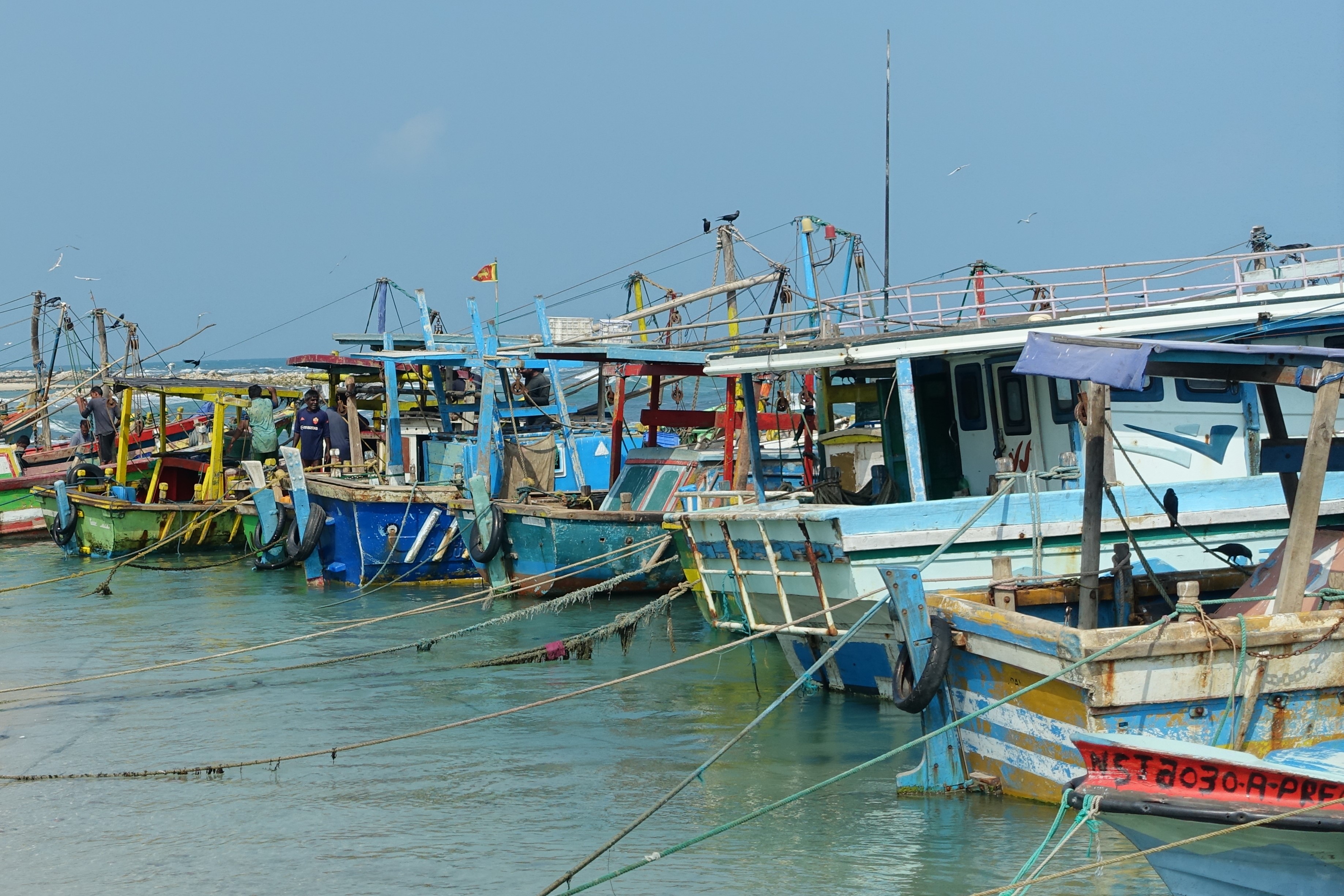 Valvai Revady Union Beach
Valvai Revady Union Beach
At Valalai, we stopped to take photos of the scenic fishing boats working on the beach. On the wall of a community centre was a plaque commemorating the great Sri Lankan swimmer, Muruguppillai Navaratnasamy, who was the first person to swim 55 km across the Palk Strait between Sri Lanka and India.
 The mighty Muruguppillai Navaratnasamy
The mighty Muruguppillai Navaratnasamy
We passed Sri Lanka’s northernmost place, Point Pedro, and headed south-east on the B371. It is a quiet road through lagoons and flatlands, but the sidewinds meant constant hard pedalling. Like previous days, we found ourselves sitting hunched into the wind, churning the same cadence hour in, hour out. At Maruthankerny, we had to turn inland as the coast road stops further down at a lagoon in Chundikulam National Park. We were blown by the wind across a causeway, and then sped down the A9, drafting a tractor for part of the way. After 19 kilometres of this, we turned east on the A35 and back into the wind. The road, however, was excellent: smooth, little traffic, and pleasant countryside. The last part around Nanthi Kadai Lagoon was once more into a side-headwind, so we knuckled down and raced the last stretch at a lung-busting 27 to 28 km/h.
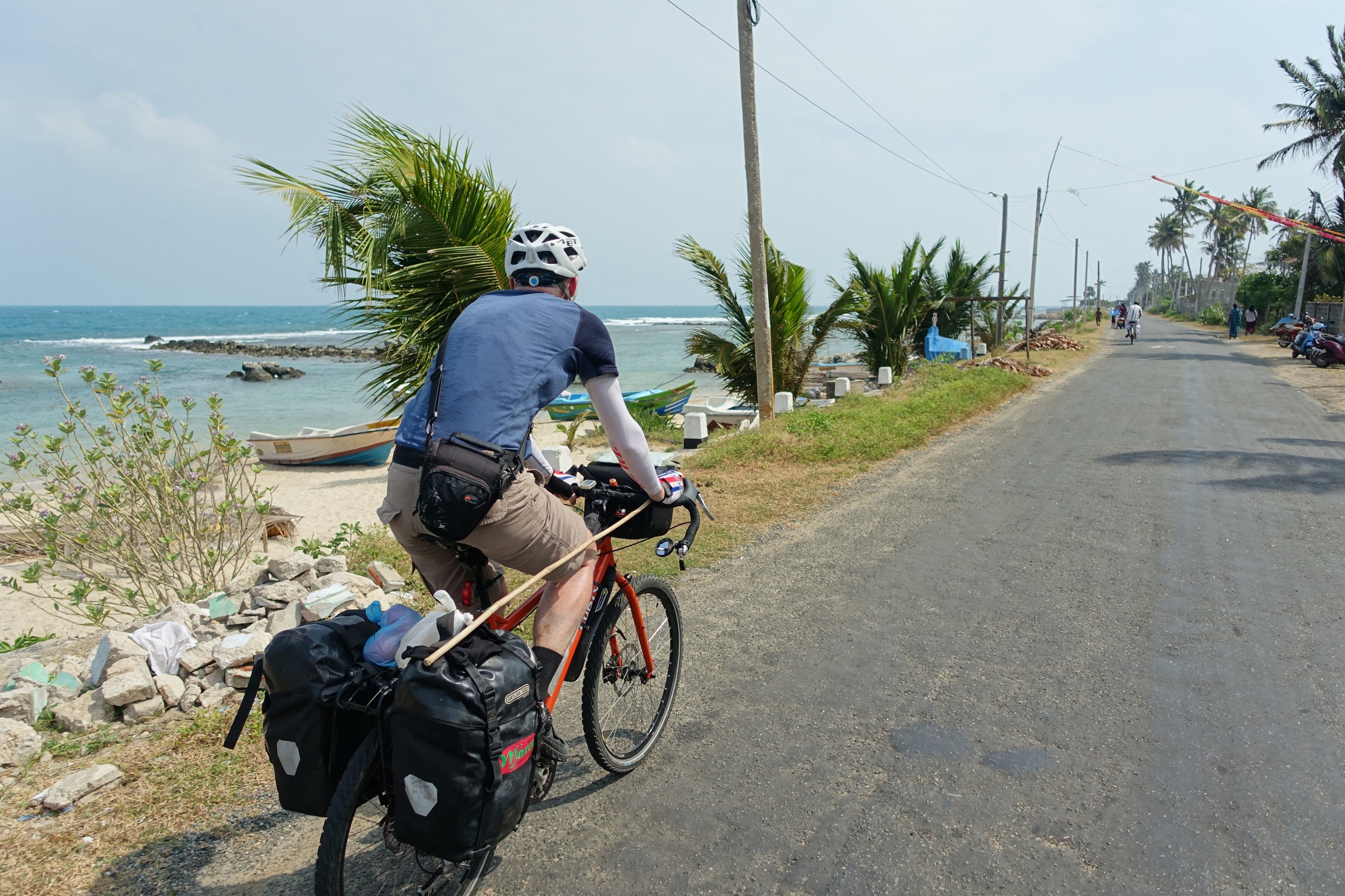 North Jaffna Peninsula
North Jaffna Peninsula
By the time we reached Mullaittivu, I was completely spent. Just before the town, the road crosses the lagoon on a very scenic causeway. It felt great to spend a few minutes relaxing on the lagoon, safe in the knowledge that we had completed the day’s ride.
We had made a reservation at the Sun and Sand Hotel for 4000/- for a twin, but when we arrived, we were told a basic double would be 5,500/-. John cycled off to look at nearby Ocean Park Resort, while I haggled and haggled for a better room at a better price. I finally got the twin we had been promised, but there was no restaurant, no hope of tea, and not much to earn the title of “hotel”. However, the room was cleaned for us, and we were brought a kettle of hot water. My coffee from Japan had never tasted so good.
 Sun and Sand Hotel
Sun and Sand Hotel
The Ocean Park Resort was 11,000/-. John had originally suggested we stay, but when we went there for dinner, we were glad we hadn’t. For such an expensive hotel, the restaurant was terrible. All we managed to get was vegetable fried noodles and vegetable fried rice. It took several goes to get a pot of tea as if this was an unusual request at a resort in the home of Ceylon tea.
Monday, Feb 24 – Mullaittivu to Uppuveli 117 km
 Leaving Mullaittivu
Leaving Mullaittivu
Another long day in the saddle, but we finally managed to escape the clutches of the headwind. Much of the day we enjoyed a cross-tailwind which allowed us to maintain around 22 km/h without the need to constantly crush the pedals. What a relief. We could just turn the pedals and enjoy the splendid scenery as it unfolded around us. It was a day to soak up the sights: wide lagoons stretching into the distance, ponds covered with flowering lily and lotus, lakes with the skeletons of long-dead trees, dry plains knotted with shrubs, and birds flying and wading all around.
The hotel did not provide breakfast, so we cycled a kilometre into Mullaittivu for sustenance at the Theensuvai Bakery. We dined on vegetable curry filled rolls and both tea and coffee at a table outside the shop while watching the town wake up.
 Perfect cycling on the B297
Perfect cycling on the B297
We set off south-south-east on the B297 which is a perfect, smooth asphalt road with almost no traffic. It was one of the best roads we cycled on in Sri Lanka. We pedalled leisurely through beautiful wetlands stopping frequently to take photos. A few kilometres before Kokkilai Lagoon Bird Sanctuary, we had to turn inland for several kilometres and enjoyed a strong push from the wind. At one lake, we came across navy recruits going through their swim training. They could barely swim but would have to manage 6 km by the end of their training.
The army and navy are everywhere in the north. You are never far from a base with its lookout towers and sentry posts. And you are never far from road checkpoints with heavily armed soldiers swinging rifles and machine guns. You even see groups of soldiers on bicycles with rifles slung over their shoulders.
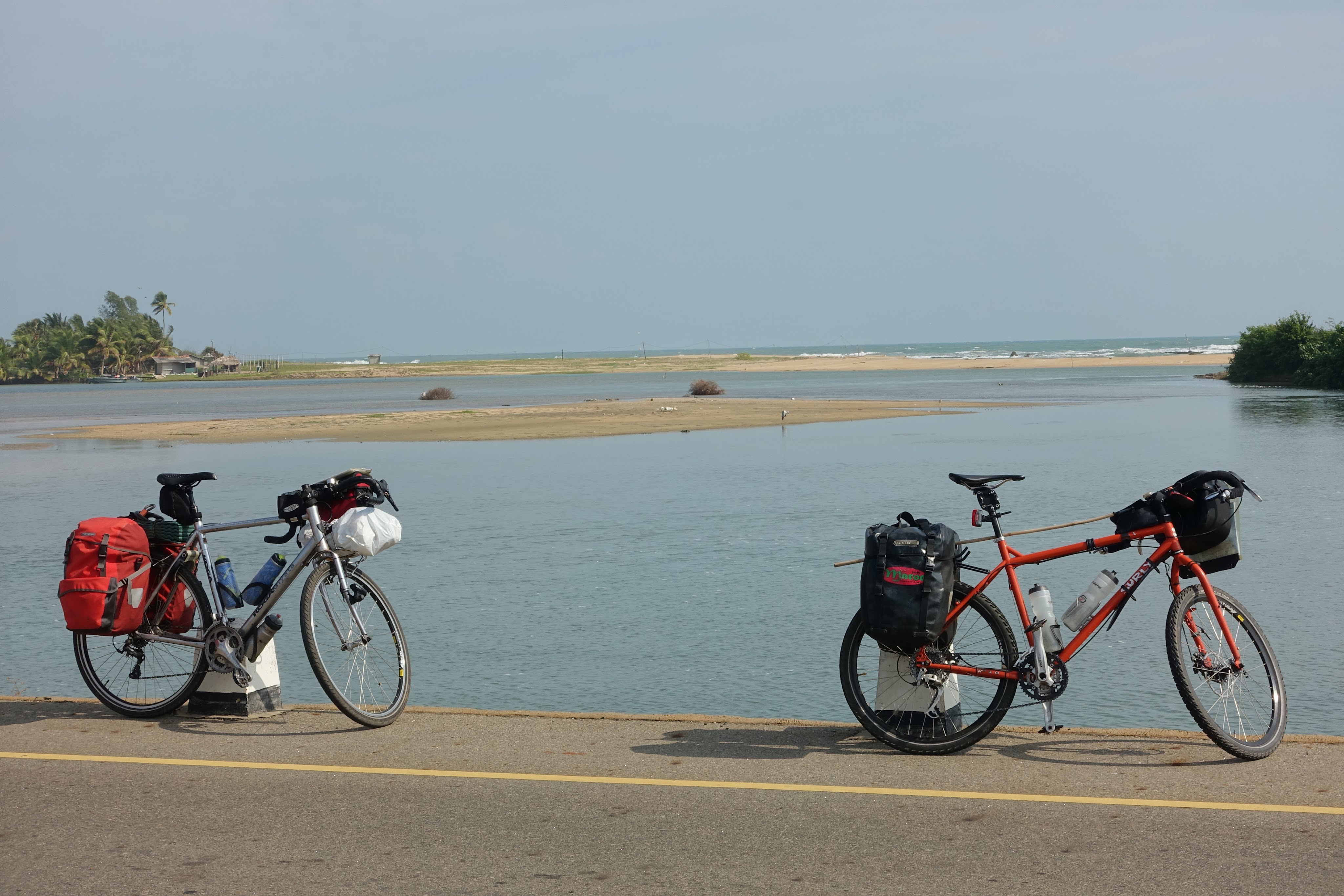
We then cut back on small roads and one stretch of dirt track to the lagoon. I doubled back to have my photo taken by John, turned too sharply, and fell. I cut my elbow which was a nuisance. I should have learnt by now that a fully-loaded touring bike doesn’t like sharp turns.
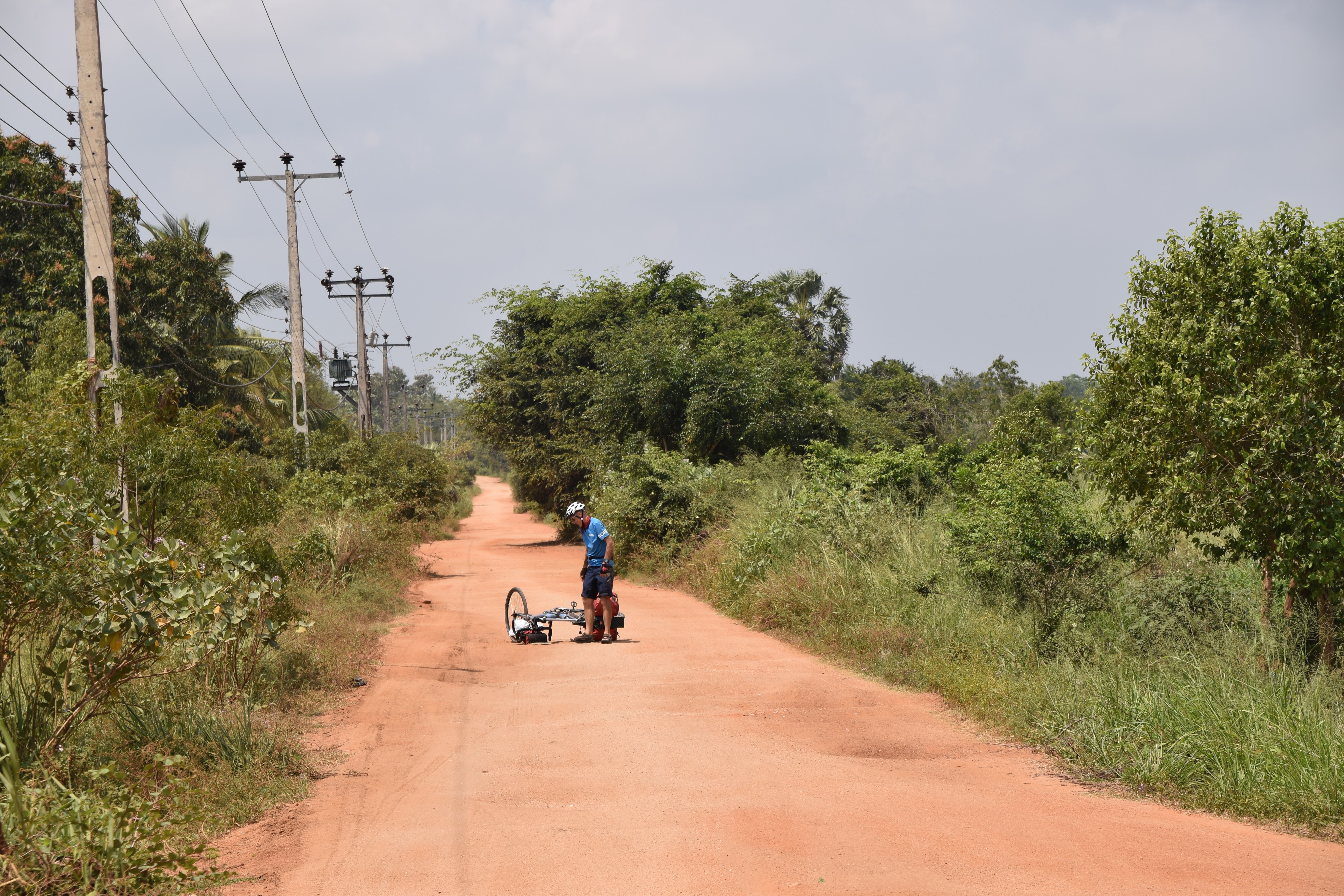 Learning the hard way that loaded bikes are unstable
Learning the hard way that loaded bikes are unstable
We picked up the B60 back to the coast at Pulmoddai which is the best place in the area for lunch. We had the usual rice and fiery vegetable curries. I tried twice to order tea without sugar, but only managed to get a cup slightly less sickly sweet than usual.
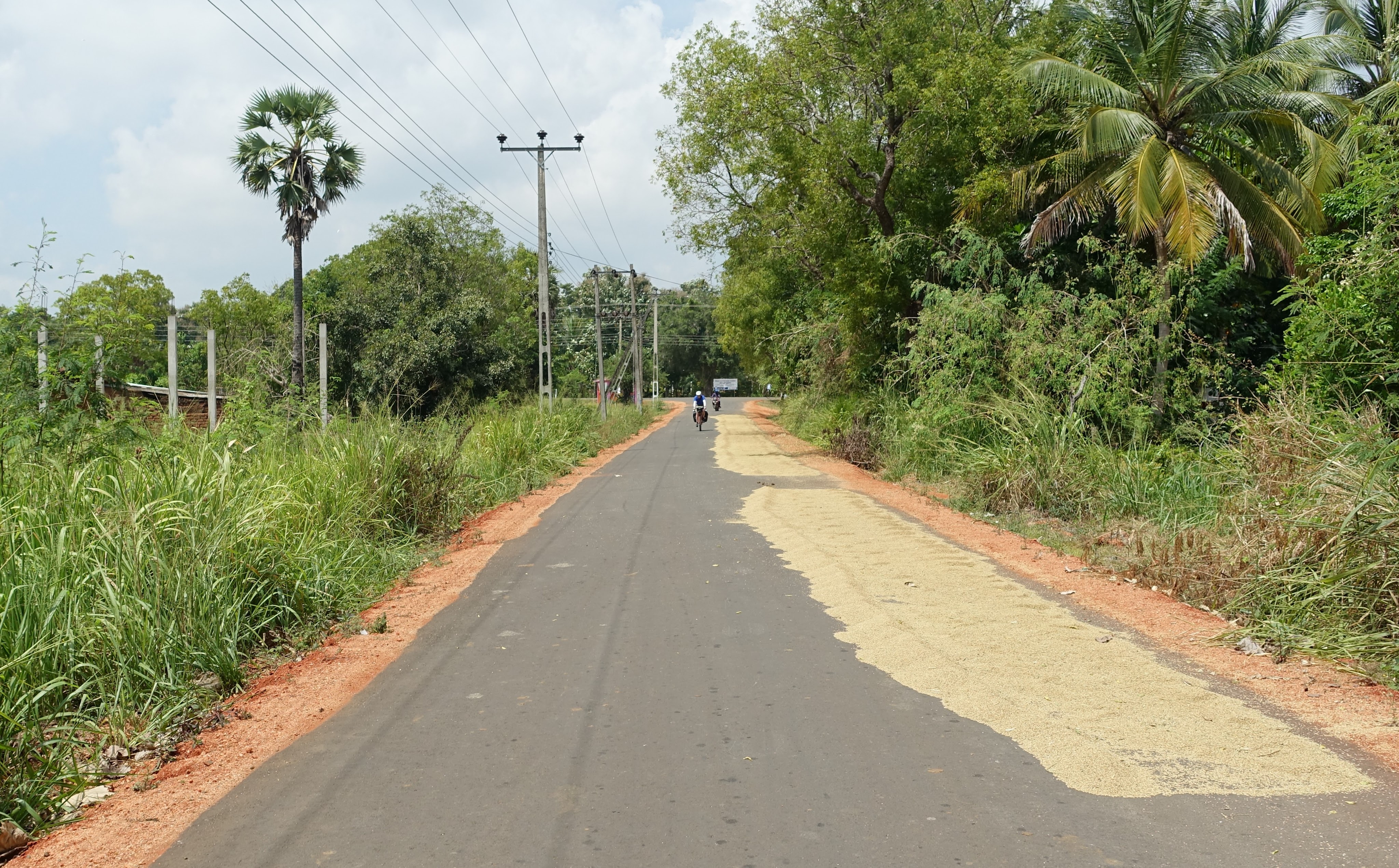 Drying rice on the road
Drying rice on the road
The last stretch along the B424 is pleasant. You rarely see the sea, but the lagoons are always scenic. At Salpayaru we watched gannets diving into the river estuary for fish and took lots of photographs and drone footage. We also met pilgrims visiting Bahiya Pabbatha Monastery which is curiously located next to the Prison Department Holiday Resort. At Nilaveli, we came across our first fellow cycle tourists, a couple from France taking a break at the resort.
 Salpayaru Fishing Village
Salpayaru Fishing Village
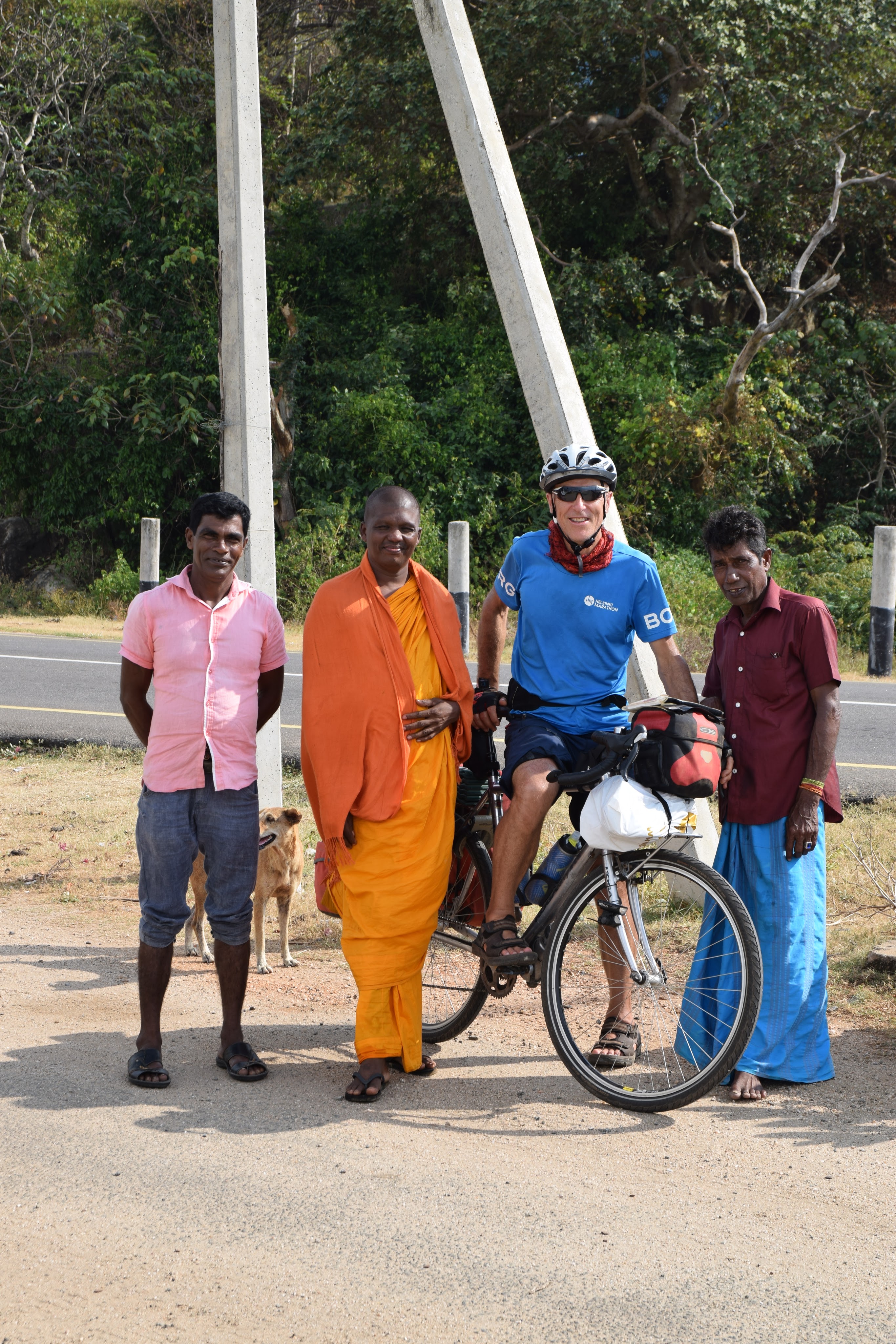
We sped up for the last few kilometres, eager to get to our hotel, the Coconut Beach Lodge, which was right on the beach. It is a splendid place with helpful staff, beautiful gardens, and a restaurant overlooking the sea. The twin room was tiny, but it was a bargain at 5,000/-. We had a splash in the crashing surf before a tasty meal of devilled fish and rice. We spent the rest of the evening deciding where to ride the next day. Our first choice was Sigiriya with its rock citadel, but there didn’t seem to be any routes which avoided the main roads. In the end, we decided to try the A9 which runs directly south-west to Sigiriya. The big attraction was that we would at last have a tailwind. If it was too busy, we would change plans and ride to Polonnaruwa on back roads.
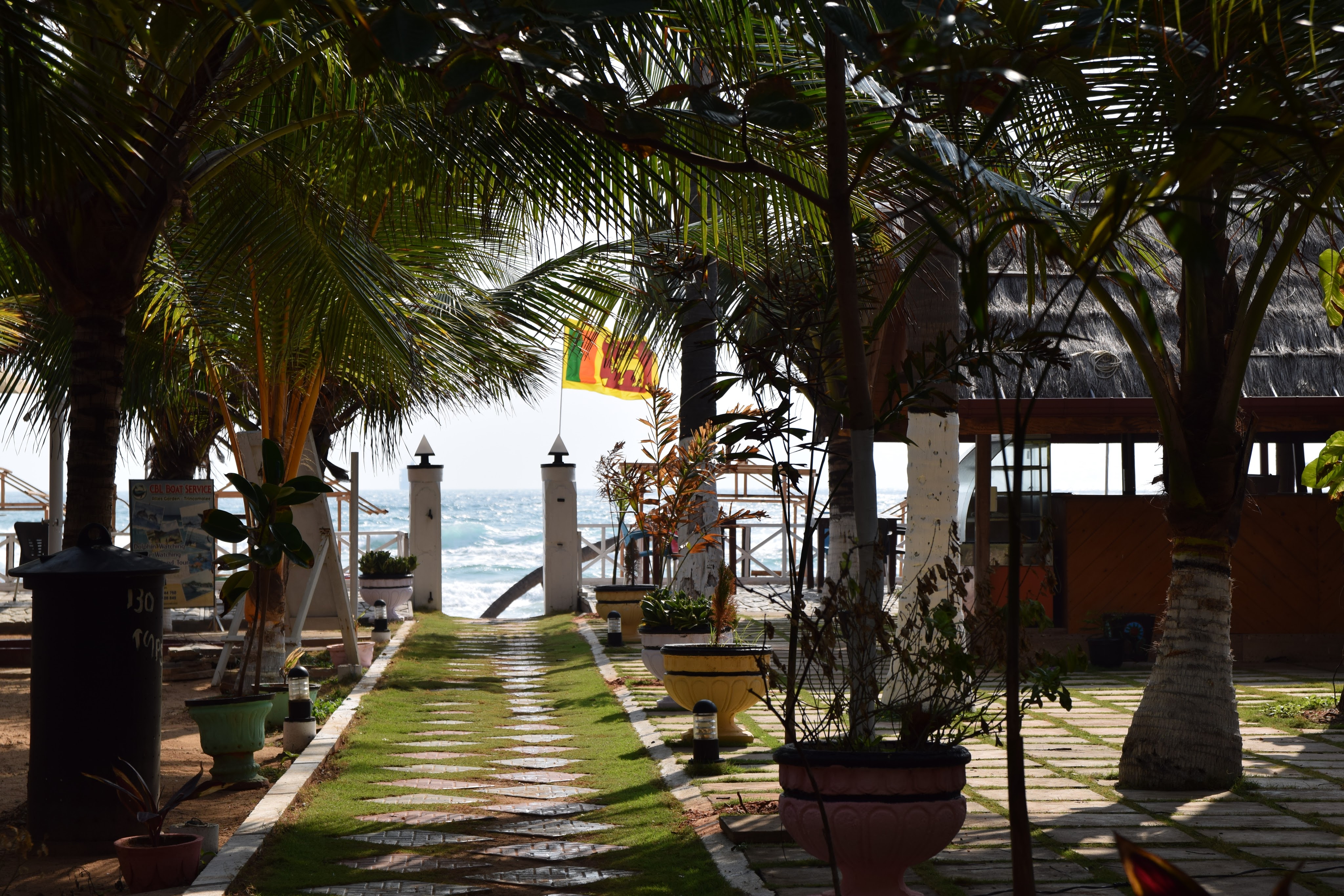 Coconut Beach Lodge
Coconut Beach Lodge
Tuesday, Feb 25 – Uppuveli to Sigiriya 106 km
We had planned to stay a day in Uppuveli but the beach is only okay, and the sea was too rough for swimming. We would spend a day sightseeing around Sigiriya instead. With the tailwind and a short day ahead, we gave ourselves the luxury of a late start. John went for a dip in the crashing surf, we had breakfast overlooking the sea, and were on the road by 9:40. We soon joined the A6 and were surprised by how little traffic there was. We kept waiting for convoys of trucks and buses to thunder past, but it never happened. Soon we were in pleasant countryside. At Kantale, we climbed a little out of the town to a huge reservoir, and suddenly we were presented with fine views across forested plains dotted with distant rock outcrops. The road around the reservoir is almost deserted as heavy vehicle have to take a lower road.
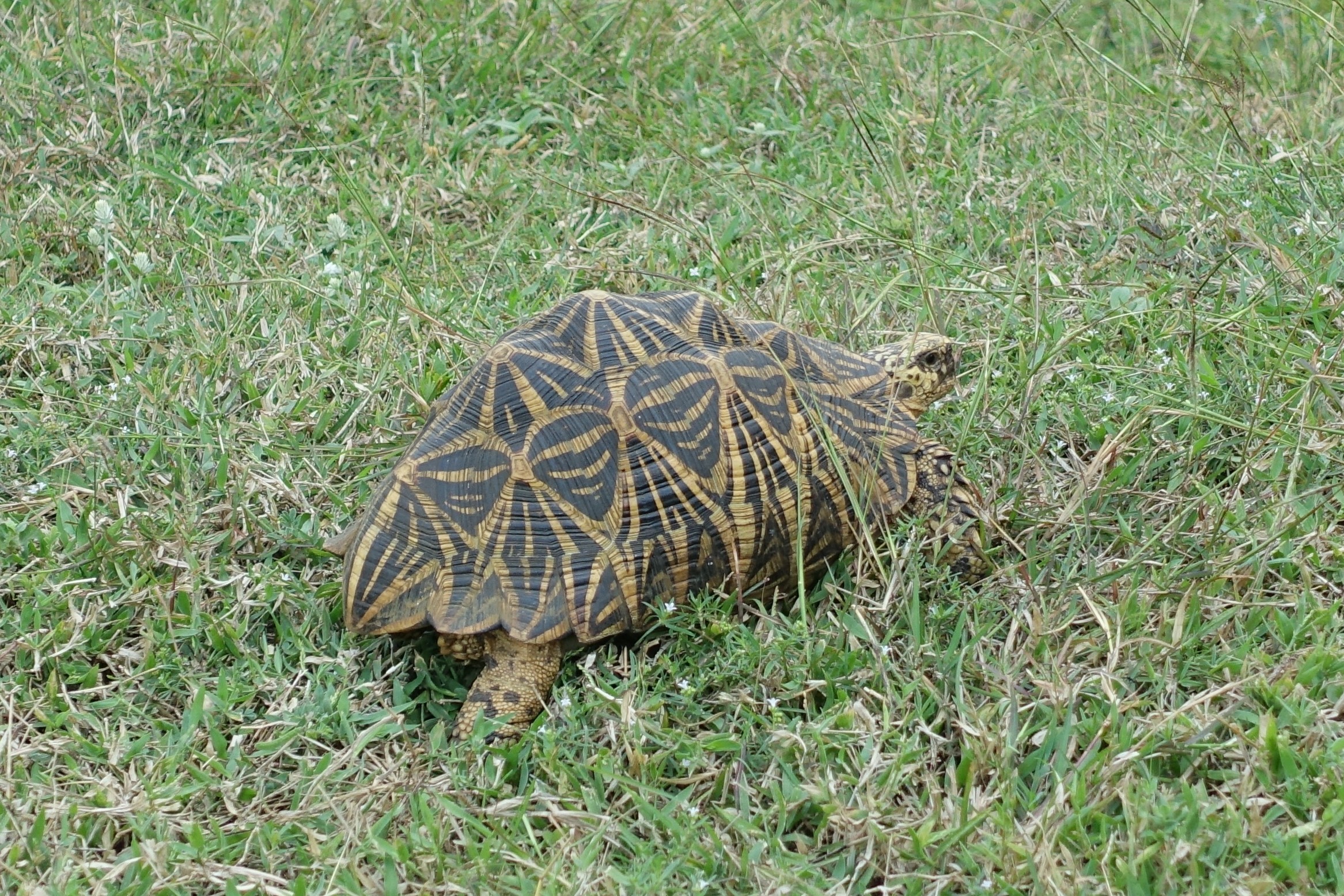 Rescued tortoise
Rescued tortoise
At the end of the reservoir, I spotted a large tortoise with a dramatically patterned shell walking down the road. I rescued it and put it on the grass slope below the reservoir. After much hesitation, it plodded off to safety.
We had a brief stop at a bakery – we were starting to crave these little oases of carbs and caffeine – where we had a slice of absolutely delicious chewy, slightly malty coconut cake and the usual sickly-sweet Nescafe from a machine.
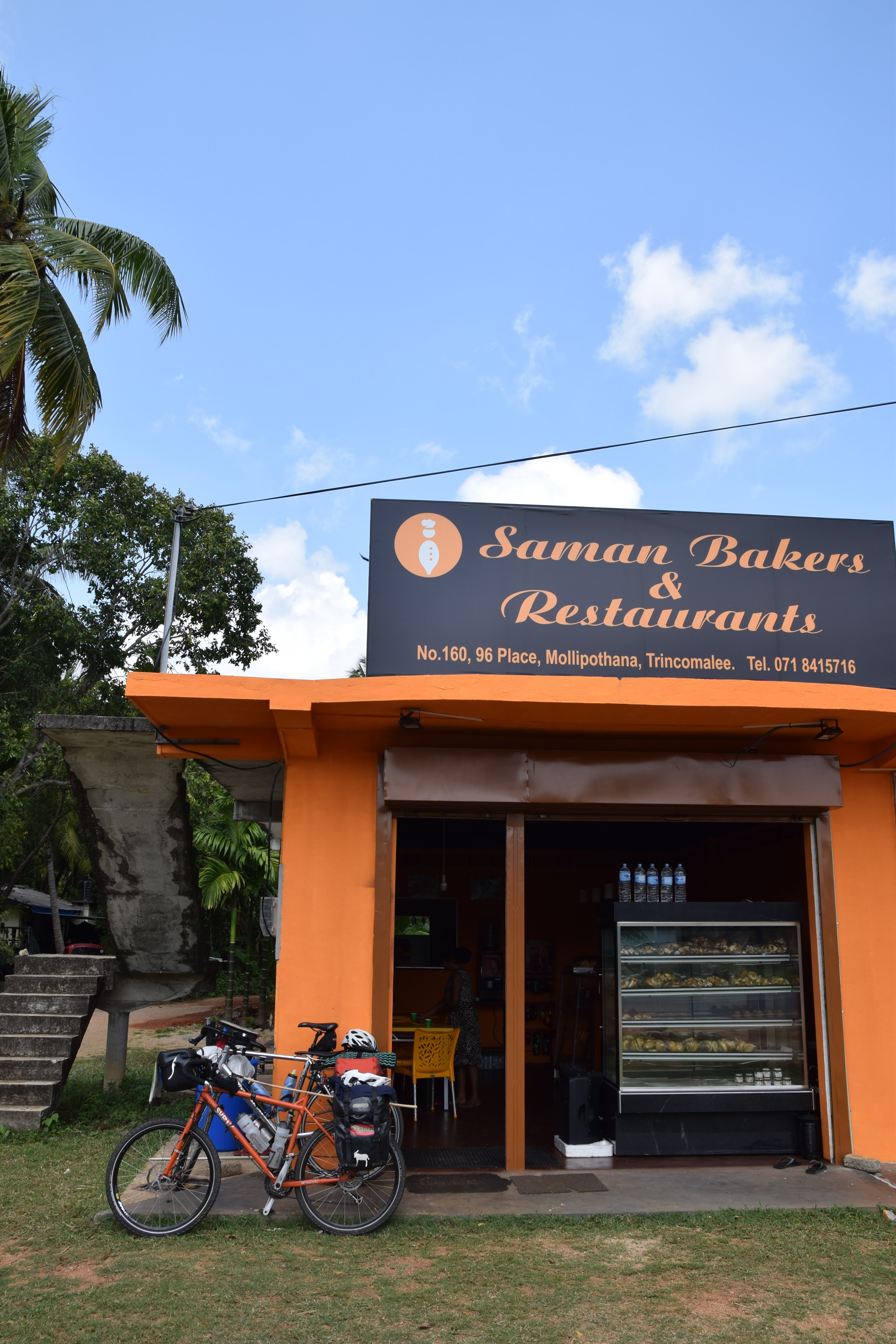 Best cake in Sri Lanka
Best cake in Sri Lanka
The countryside continued to improve. We had expected a heads-down slog on a noisy main road, but instead we were enjoying a pleasant ride. For lunch, we stopped at the usual roadside food place, but this one had a self-service buffet. We heaped rice, dal, pumpkin curry, and dried fish on to our plates.
The scenery got even better as we passed close to Somawathiya National Park. Just before Habarana, there is beautiful afforested grassland – patches of trees amidst tall grasses and shrubs. John rode on ahead while I slowed down to savour the natural beauty. I stopped for a call of nature and walked off the road into a grassy clearing. My heart stopped. 30 metres away a young elephant was munching away at the grass. I watched mesmerised as it slowly walked towards me oblivious of my presence. When it was within 15 metres, it suddenly fixed its eyes on me, grunted, and rush towards me. I have never got on my bike so quickly.
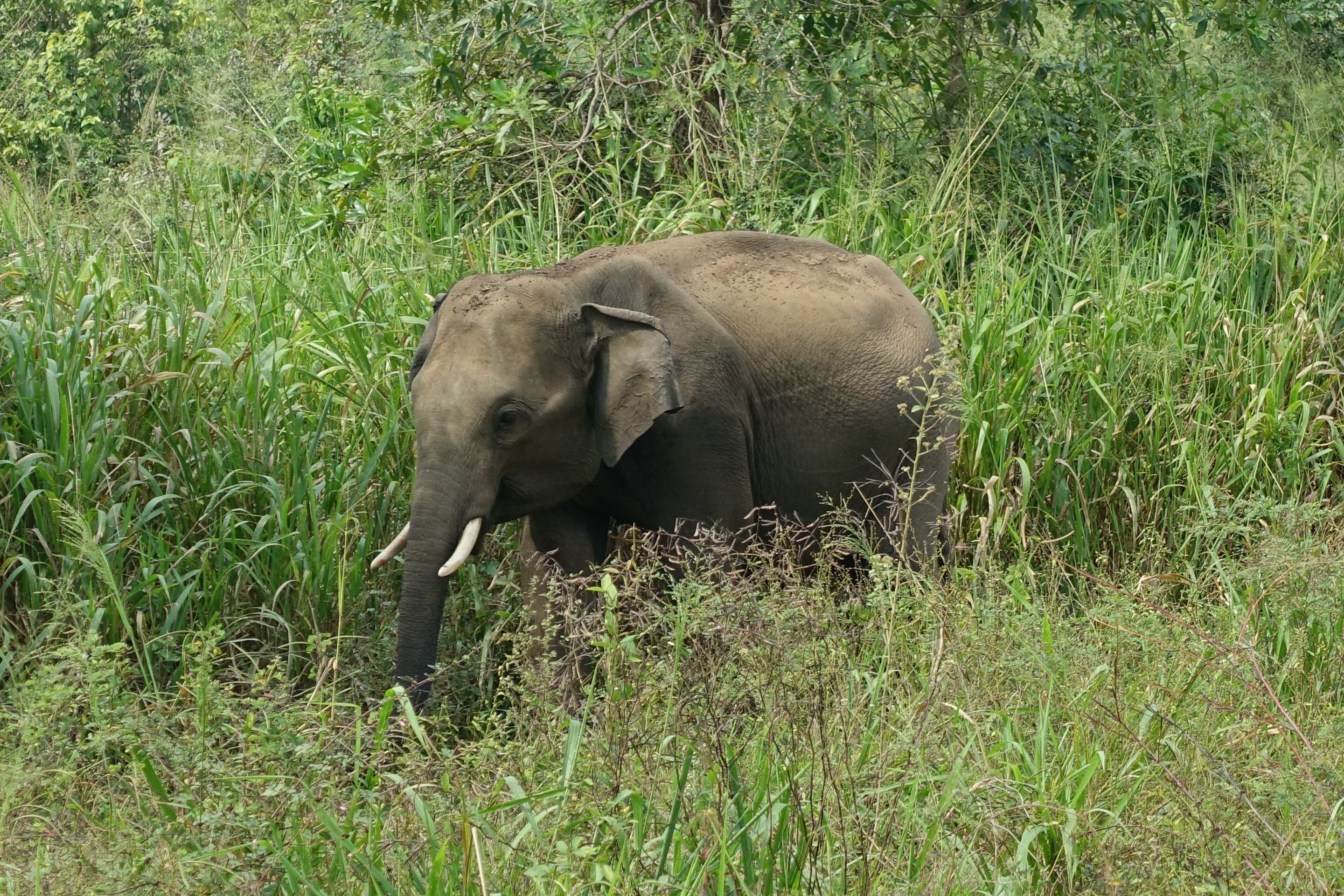
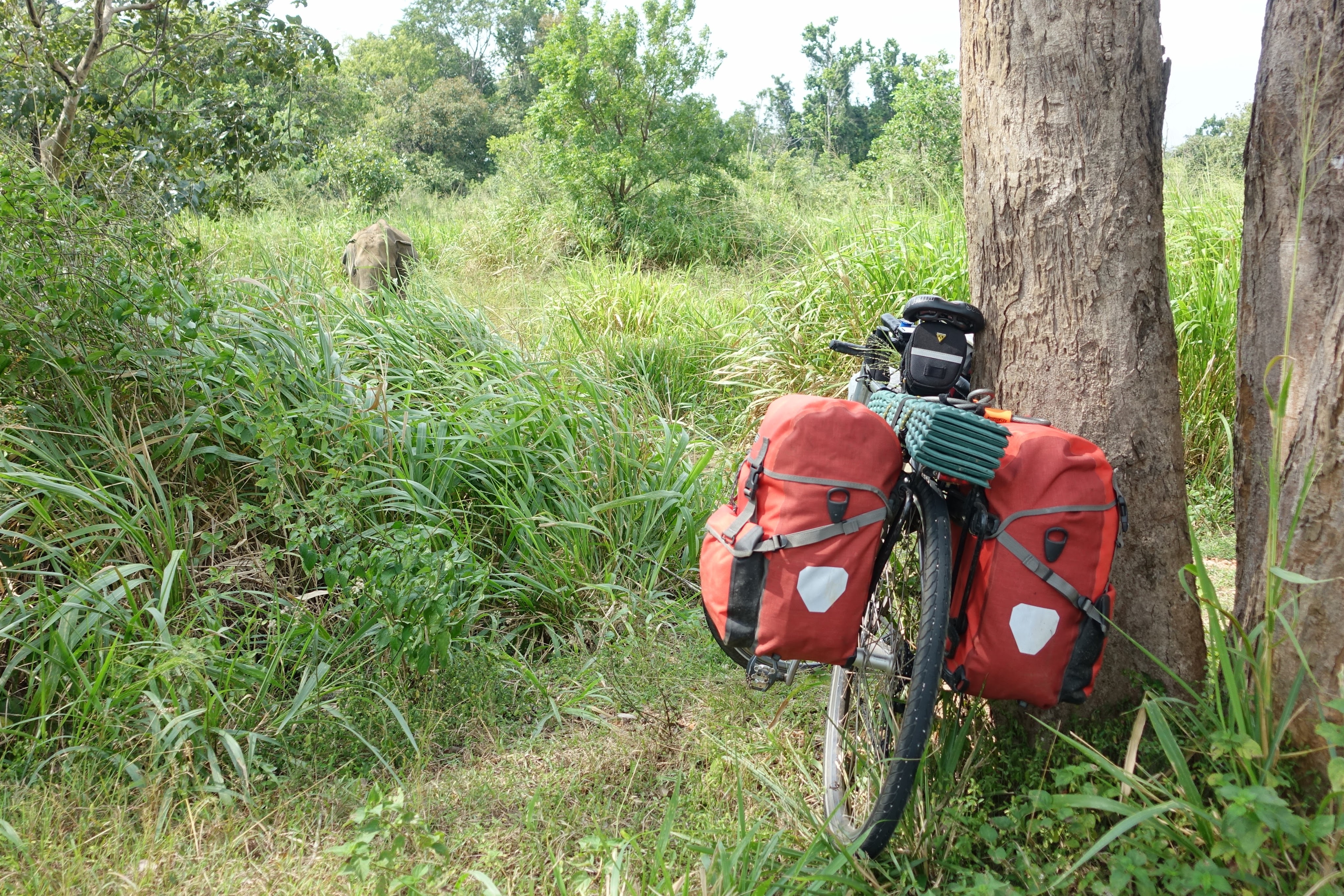 Moments before I fled
Moments before I fled
I rode on full of the experience. John was waiting a few kilometres up the road. As I told him what had happened, I realised I was shaking. Later we came across a “three-wheeler” (tuk-tuk) and a jeep waiting by the road. There was a huge elephant walking fast towards us. We turned around, retreated a safe distance and waited for it to go back into the forest.
At Habarana, we took out money from an ATM, got some rehydration salts from a pharmacy, and turned off on to the A11 for a couple of kilometres. It was crowded with traffic. Fortunately, we soon turned right on to the B294 which is a lovely quiet lane that winds through the forest beneath a canopy of leaves all the way to Sigiriya. We stopped often for photos, and John took some more drone footage. At last we reached the great rock outcrop overlooking the village of Sigiriya. It was quite a sight in the late afternoon light.
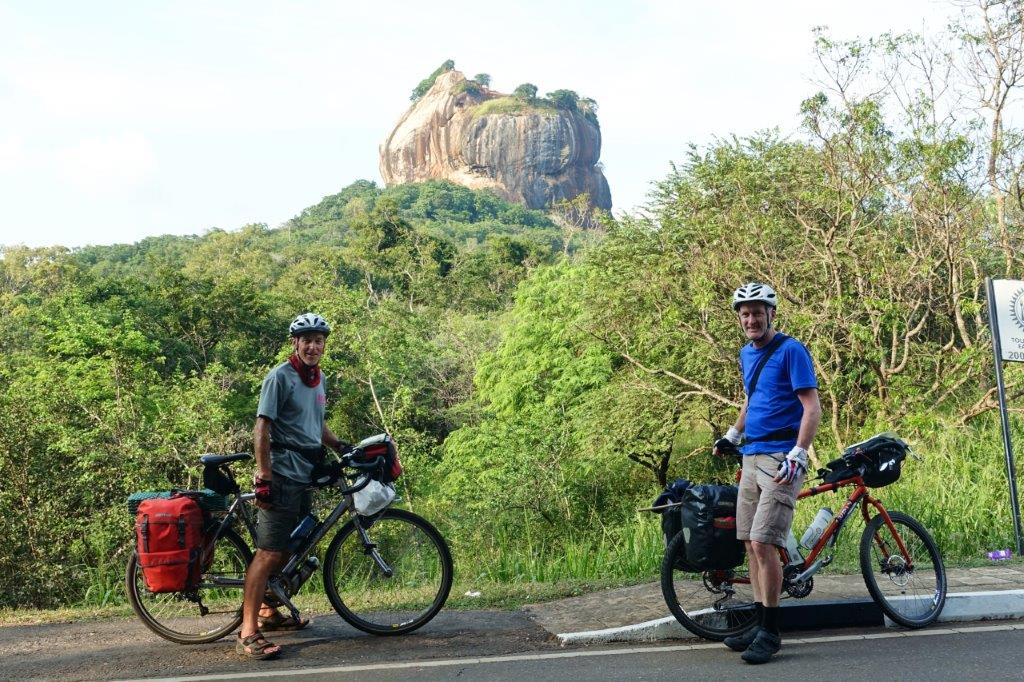 Sigiriya Rock
Sigiriya Rock
In the village, we passed two huge working elephants being washed in the creek. We soon found our hotel, the Sigiri Lion Lodge which is rightly recommended by our guidebooks. It is a splendid place. It has leafy grounds, quiet, super-clean rooms, and very cheerful, helpful owners. This was a place to spend two nights. Dinner was at nearby Nirwana Restaurant. The food was tasty, non-spicy, filling, and cheap – just 300/- for a satisfying veg kotthu.
 The delightful Sigiri Lion Lodge
The delightful Sigiri Lion Lodge
Wednesday, Feb 26 – Sightseeing around Sigiriya
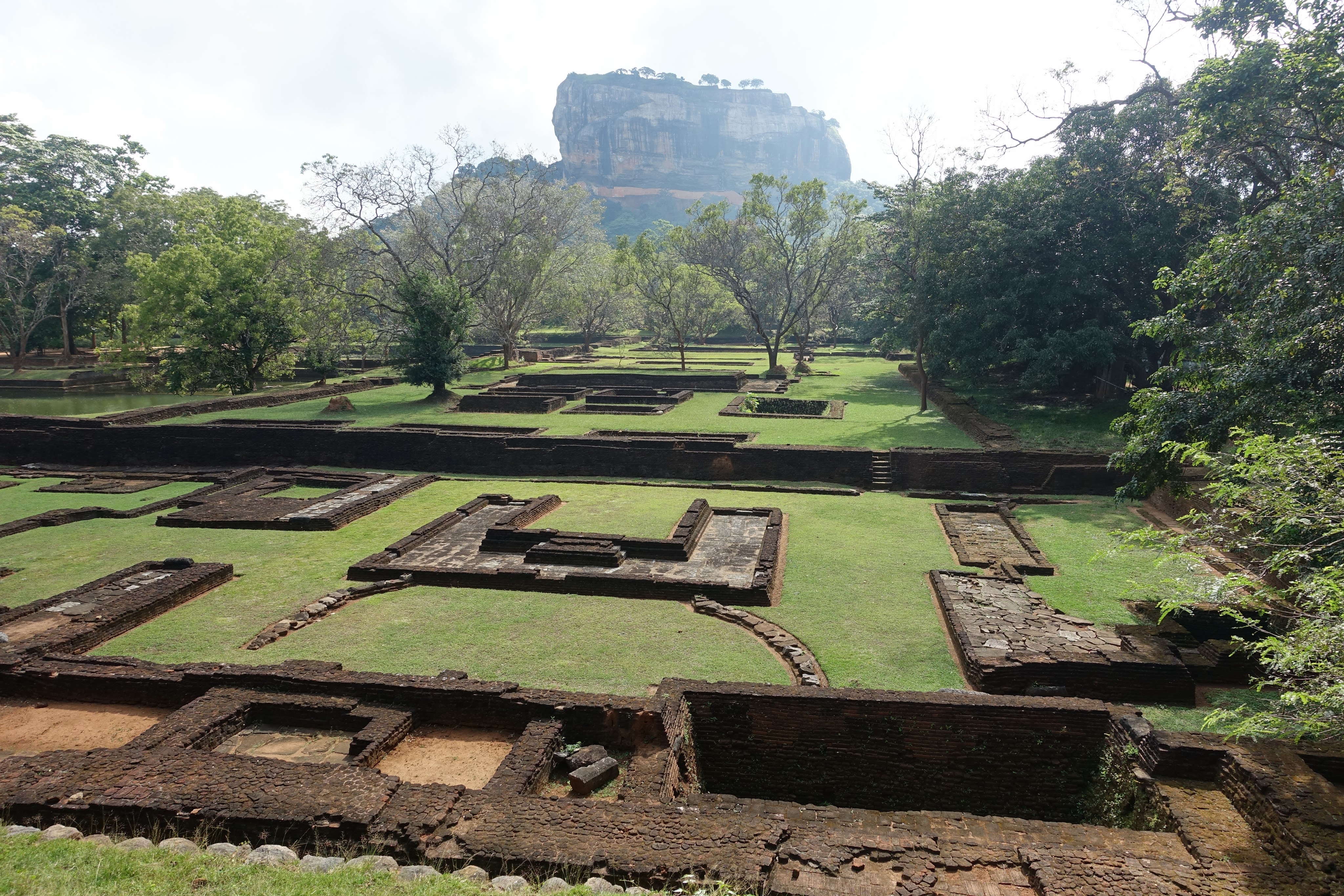 Sigiriya Water gardens
Sigiriya Water gardens
The Sigiri Lion Lodge owners continued to make our stay perfect. We had an excellent Western-Sri Lankan fusion breakfast and then were driven to the nearby citadel in the hotel’s own three-wheeler. We arrived at 7 a.m. to beat the crowds, but there was already a line of people climbing the rock. It is a great place to spend two or three hours. We climbed steps cut into the rocks, and then metal staircases bolted onto the vertical rockface. Overweight tourists were being pushed up by lean tour guides twice their age. There are many things wrong in the world. At the top, there is a ruined palace which offers sweeping views across the misty plains to distant outcrops and peaks.

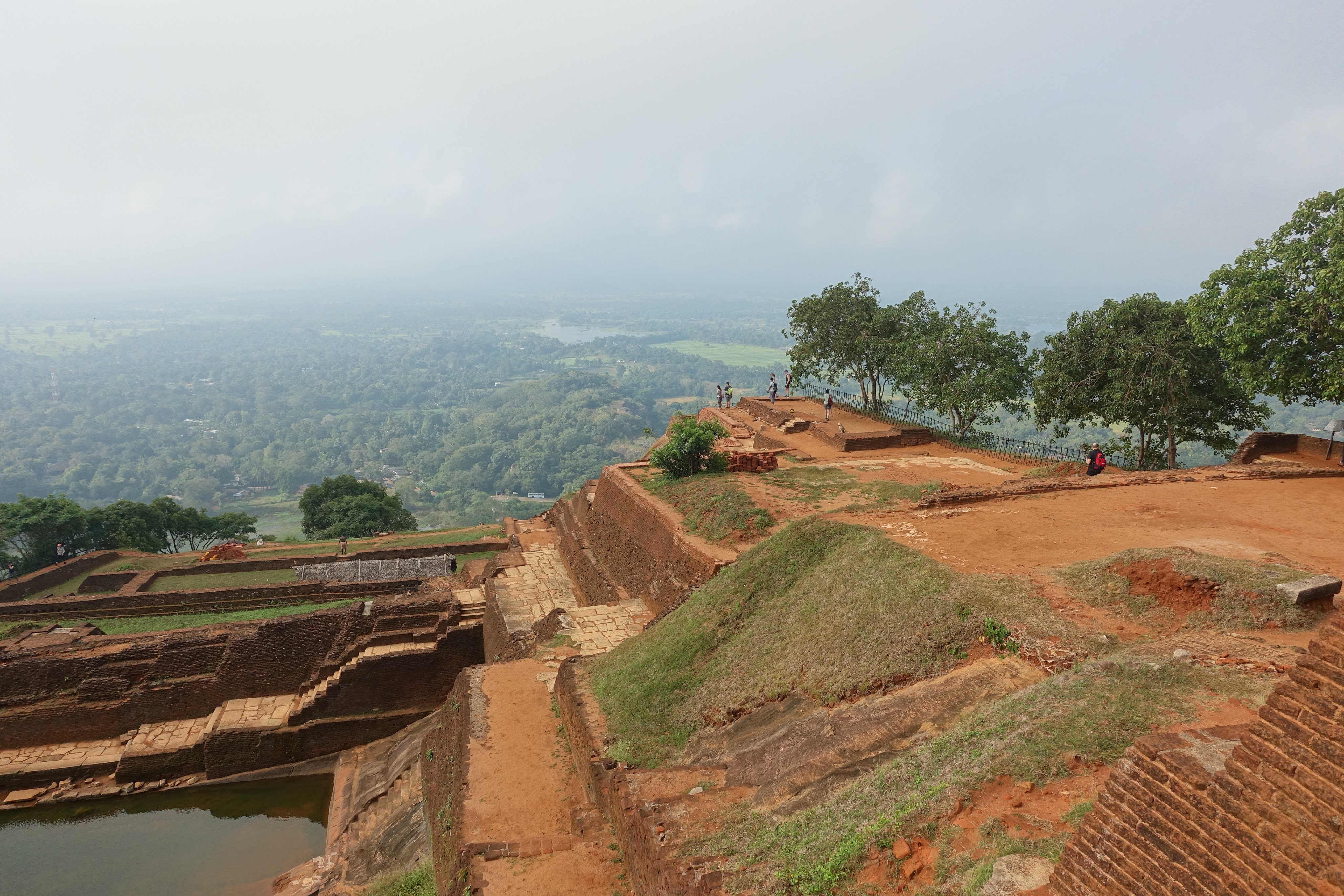 Palace ruins on top of Sigiriya Rock
Palace ruins on top of Sigiriya Rock
We walked back to the hotel and booked a three-wheeler which would take us 30 minutes to Dambulla and back for just 1500/-. It is a magnificent place. There is a series of caves cut into the rocks with statues, reclining Buddhas, and ceiling paintings. It is wonderful.
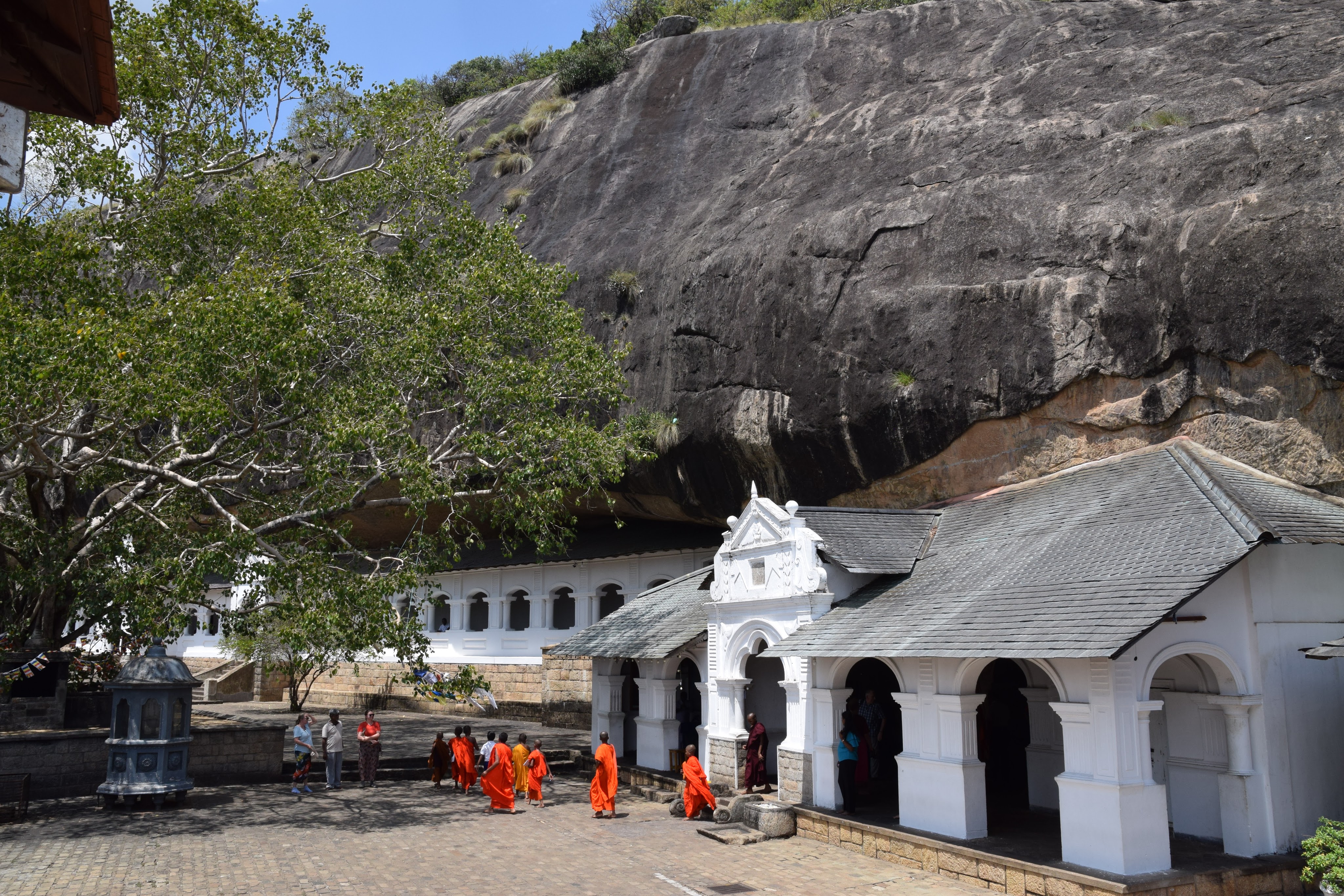 Dambulla Caves
Dambulla Caves
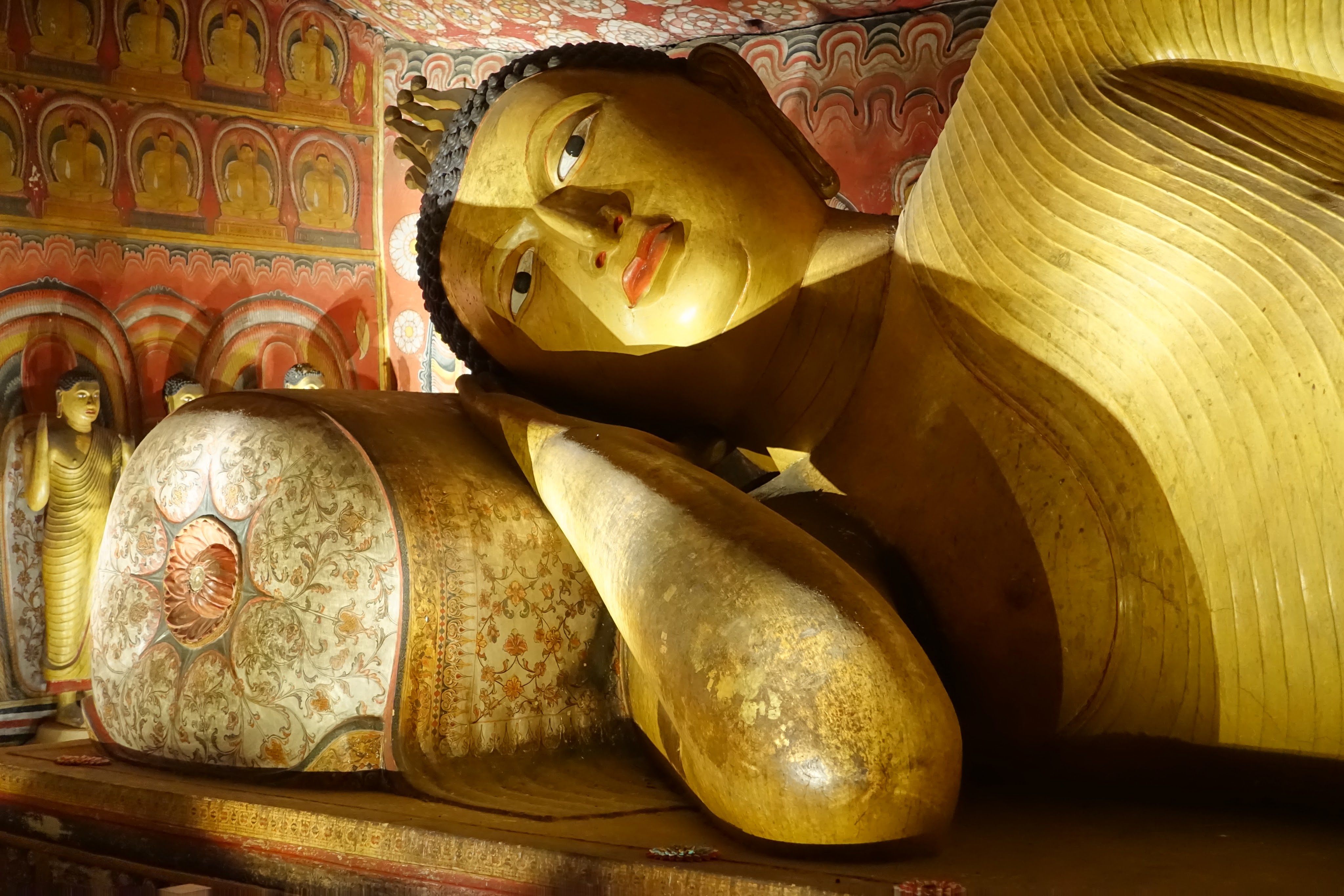
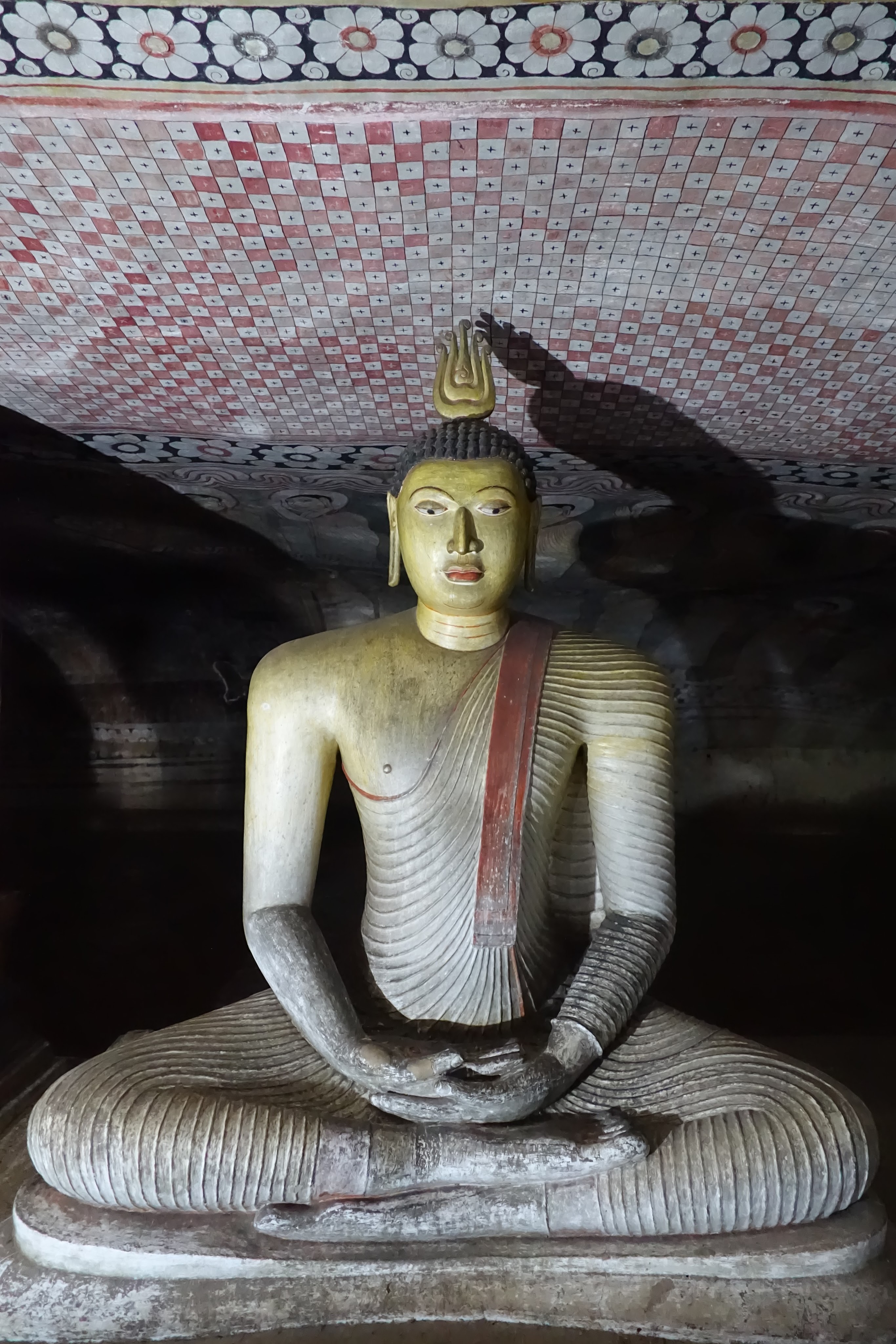
We returned to Sigiriya for a late lunch at the Wiyegiri Restaurant where I had an assortment of 6 veg curries, including beetroot curry, for just 500/-. It was the tastiest meal of the whole trip. They do cooking courses which alone make me want to return to Sigiriya one day.
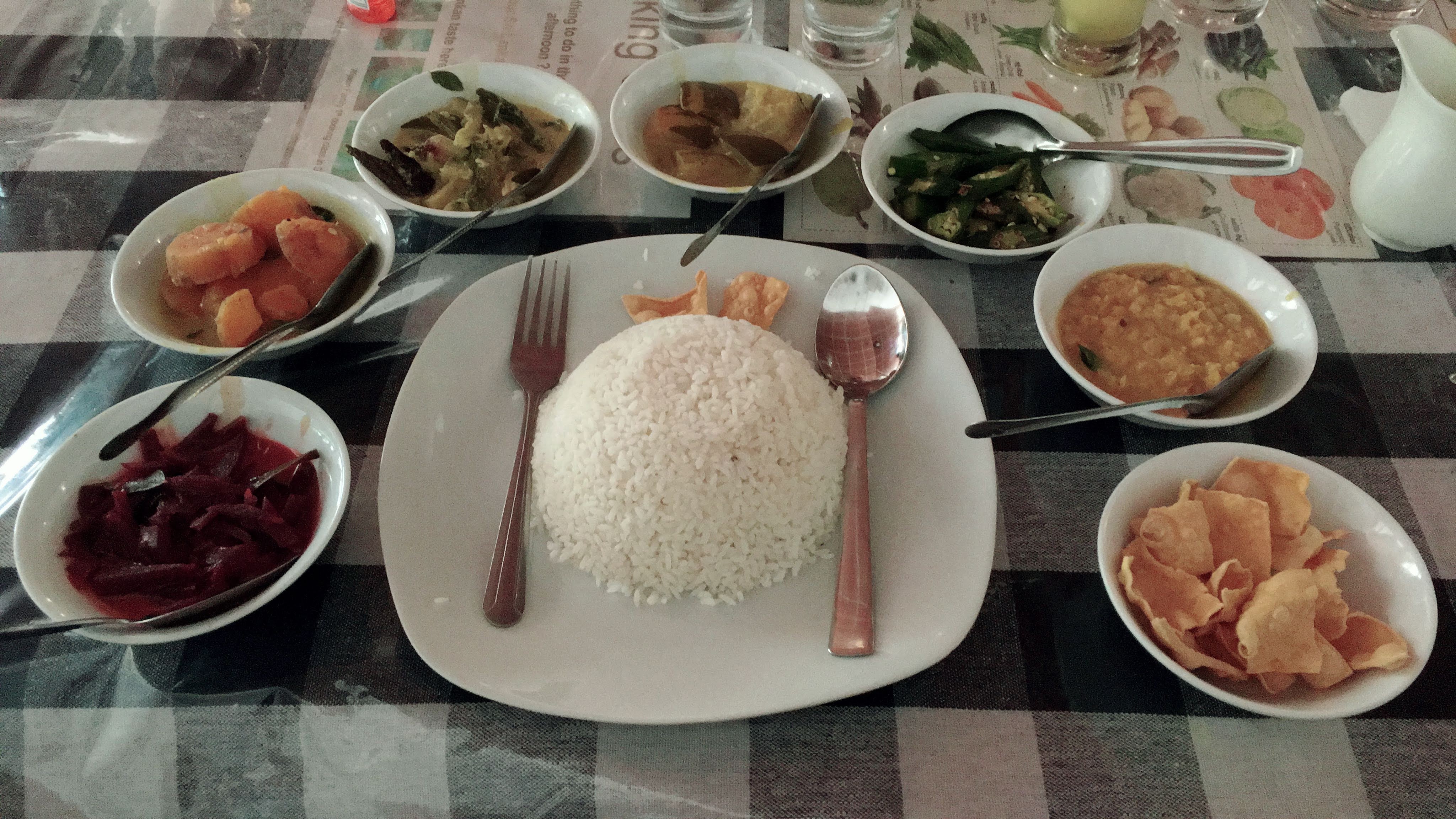 Fantastic vegetable curry at Wiyegiri Restaurant
Fantastic vegetable curry at Wiyegiri Restaurant
Thursday, Feb 27 – Sigiriya to Mahiyanganaya 114 km
 Empty roads
Empty roads
After talking with the owner of the guest house, we decided against the direct A9 to Kandy which would be very busy. Instead, we planned to do a dogleg via Mahiyanganaya which would allow us to ride the following day up the famous 18 hairpins on the A26 to Kandy. Today, we would ride from Sigiriya on the B615 and B274, via Gonawela, Bakamuna, Elahara, Laggala, Rattota, Matale, and Wattegama. It was a great ride on slightly undulating back roads ending at a luxurious place to stay, the Adaviya Resort hotel.
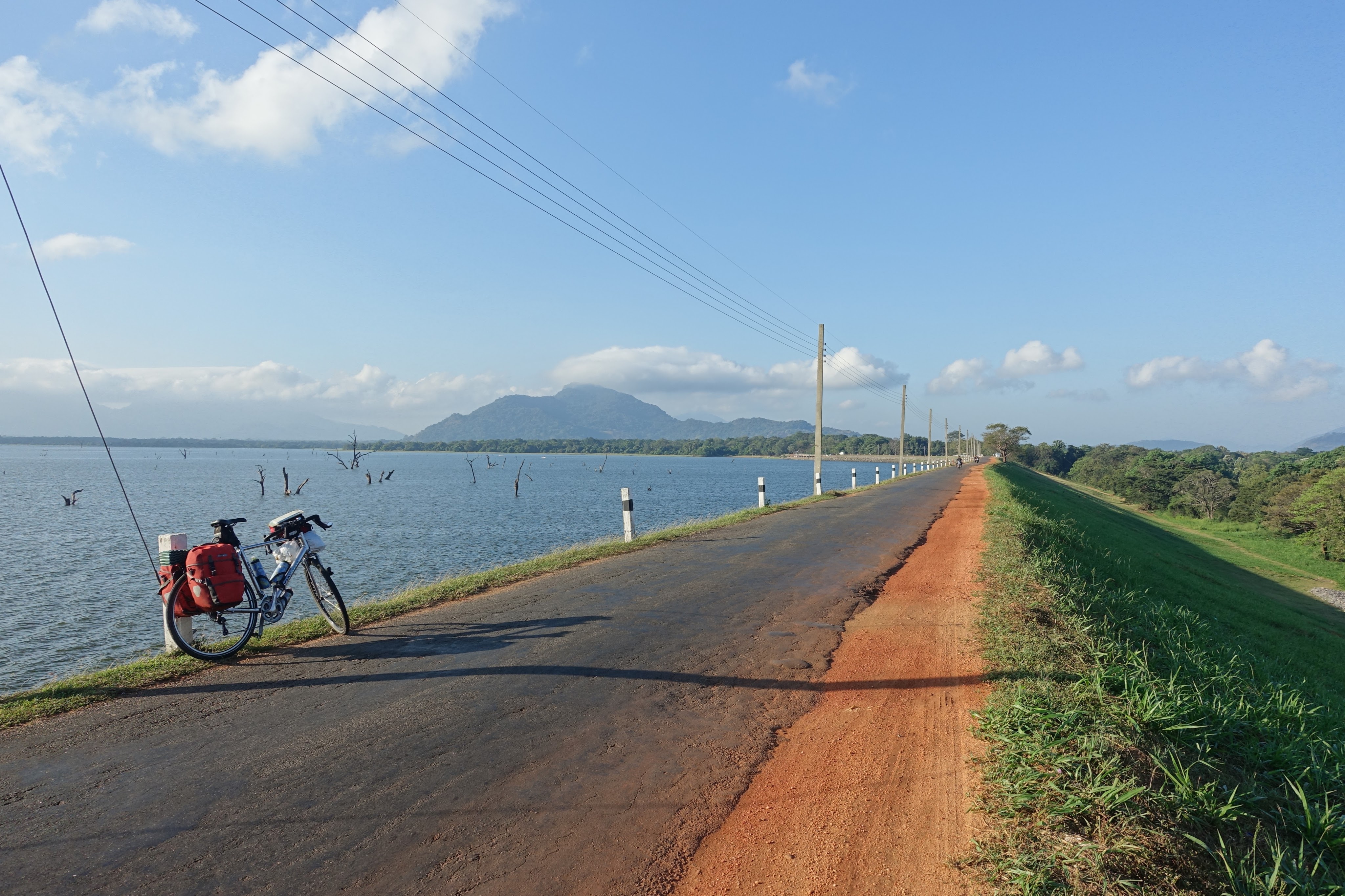 Kandalama reservoir
Kandalama reservoir
We set off from Sigiriya early: breakfast at 6:15 and off just after 7:00. This meant we could enjoy cooler, misty weather for the first hour. Most of the day we cycled through lush rice paddies with steep mountains off to the west. There was little traffic. We started off towards Kimbissa and around the west side of the scenic Kandalama reservoir and then left at the B561. It was asphalt for 3 km and dirt for a kilometer or so to the B561. At Bakamuna, we stopped for coffee and roti and then went on to Hettiploa via the B615, B312, and B274. There we had an inedibly salty curry which meant I skipped lunch. We had planned to continue on the B274 to Mahiyanganaya but somehow missed the turn off and ended up crossing the Mahaweli Ganga, a broad river that runs north and east all the way up to Trincomalee.
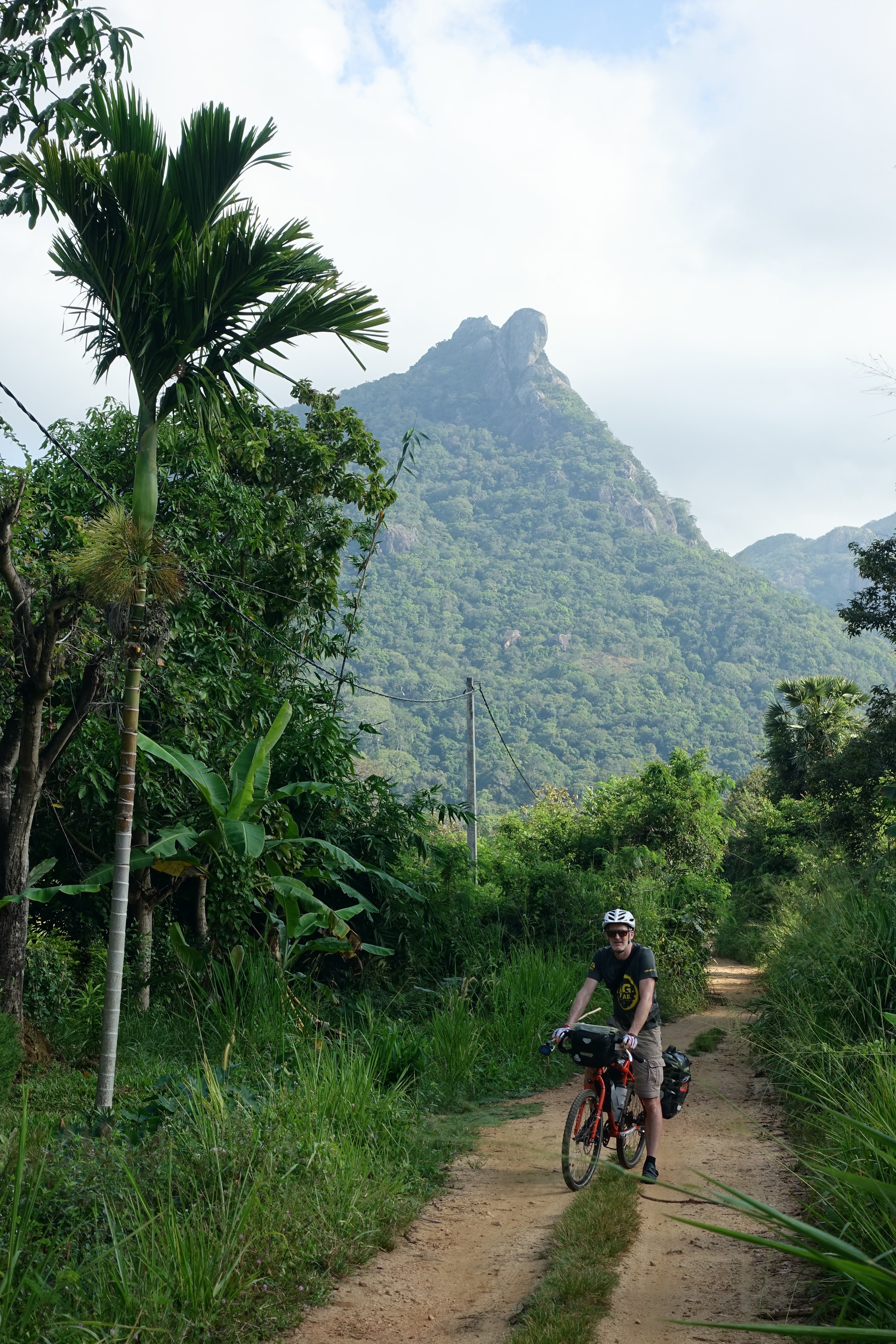 Rare dirt road
Rare dirt road
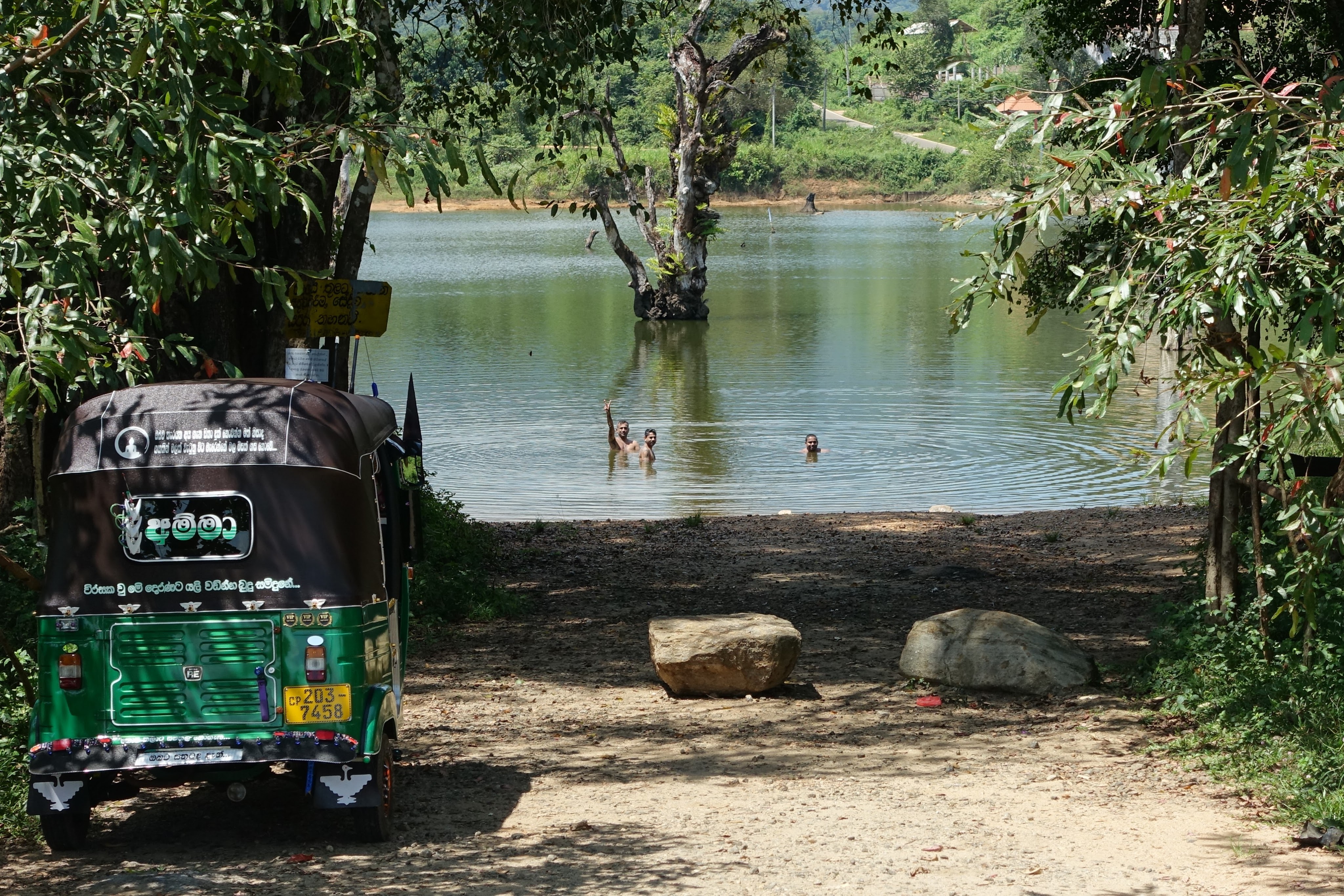
It had been all good, scenic riding on smooth roads with a tailwind. We cycled around Mahiyanganaya for a while looking for a hotel and ended up at the unexpectedly luxurious Adaviya Resort Hotel which offered us a large twin for the surprising price of 6,800/-. Dinner was not so successful. They assured us they had a restaurant, but in the end the only thing we were served was vegetable fried rice which was neither very vegetable nor very fried – a large plate of rice with a few raw vegetables thrown in. We moved on to the 988 Restaurant which was rather better. I had devilled fish which is a tasty dish of fried fish chunks and veg.
 Mahaweli Ganga
Mahaweli Ganga
Friday, Feb 28 – Mahiyanganaya to Kandy 75 km
 Adaviya Resort Hotel
Adaviya Resort Hotel
We breakfasted on half an omelette and a few meager slices of untoasted toast with fluorescent jam and set off at 7:15 for the climb to Kandy. The first half is grand: we wound up through swaying rice fields and steep forests towards the Knuckles Mountains with stunning vistas of spiky mountains at every turn.
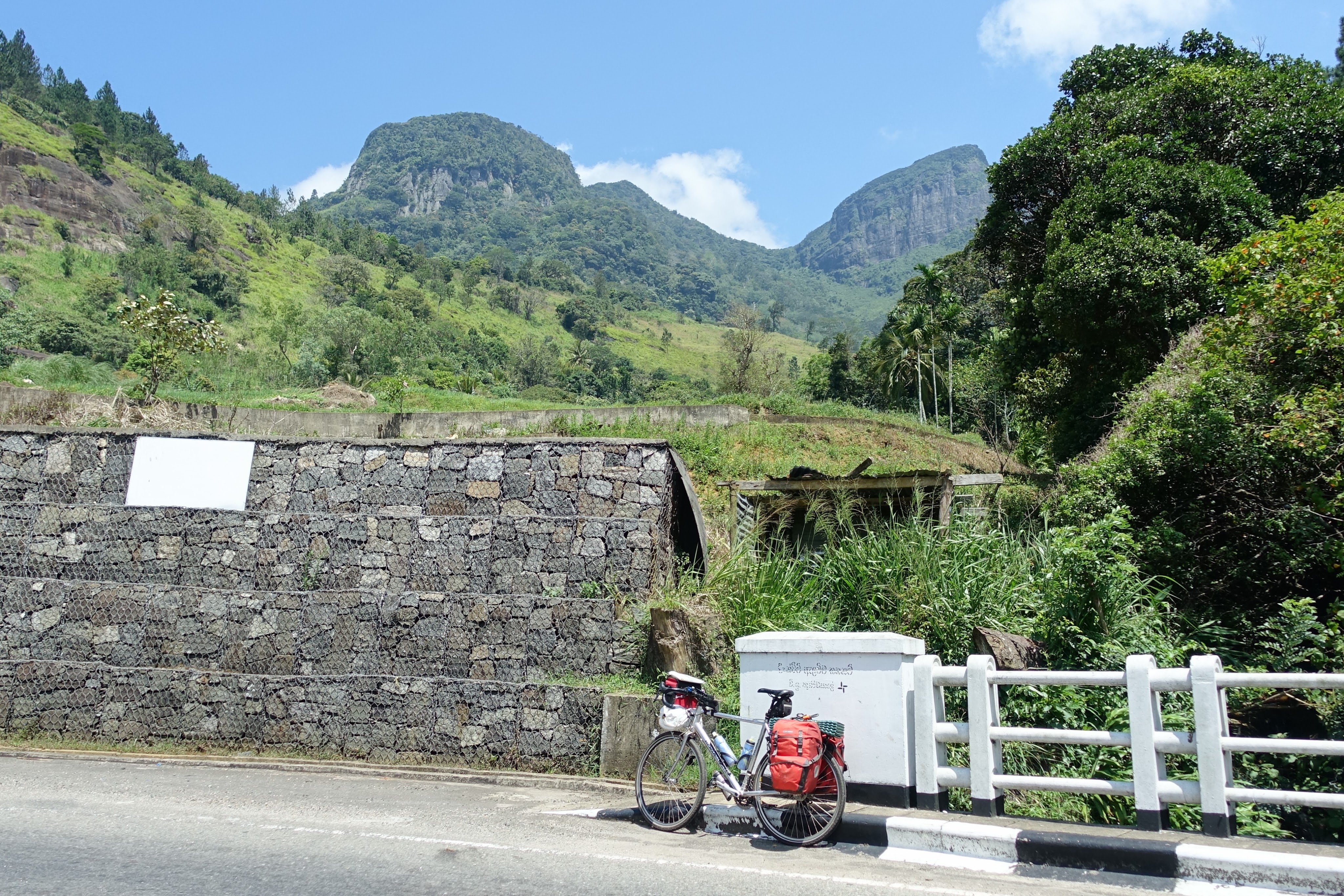 Knuckles Mountains
Knuckles Mountains
A highlight of the day was meeting two cyclists on modified steel sit-up-and-beg bikes with rod-pull brakes. We met the first at the bottom of the hairpins and the second halfway up. Despite their lack of English, and our complete absence of Sinhala, we learnt that they are brothers. The older, Sumti, sported a fine beard and legs muscled like a pro. When I asked him his job, he answered “cyclist”.
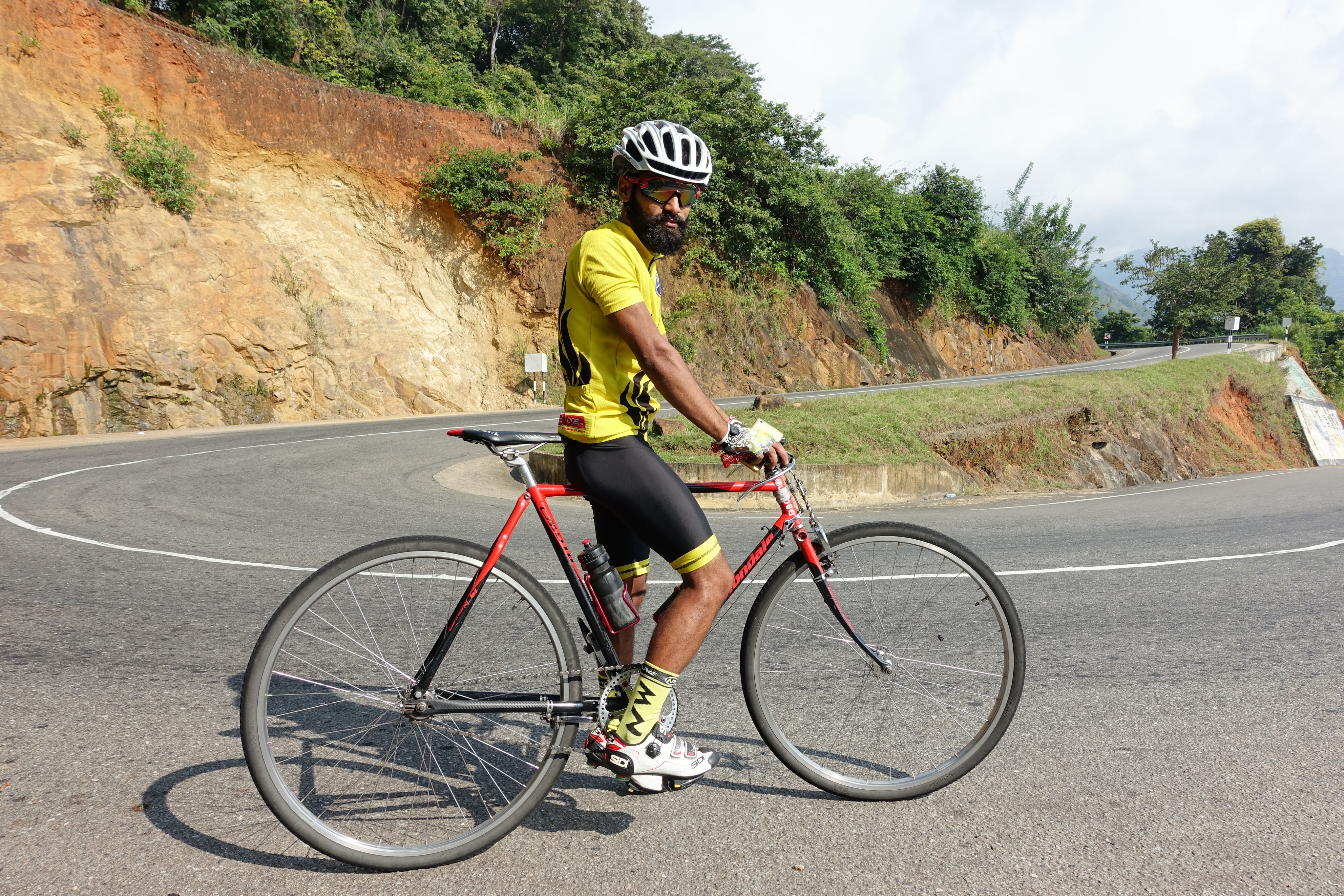 Sumti
Sumti
The bike, and the fact that he was riding it up these steep climbs, was inspiring. It had the original steel frame but repainted in red with Cannondale decals. The rod-pull brakes and chromed handlebars were original, but completely wrapped in bar tape. Somehow, they had found or made allow wheels with the groove for rod-pull brakes. The hubs were alloy, but the tyres were regular thick, local ones. The cottered steel cranks had been replaced with a modern BB and alloy cranks. It was set up as singlespeed. There were touches of the modern, such as Sumti’s Sidi road shoes a Fizik Arione saddle set low on the huge frame. I’d never seen anything like it. After lots of photos, Sumti disappeared up the steep ascent, his slight frame pushing the heavy bike at great speed.
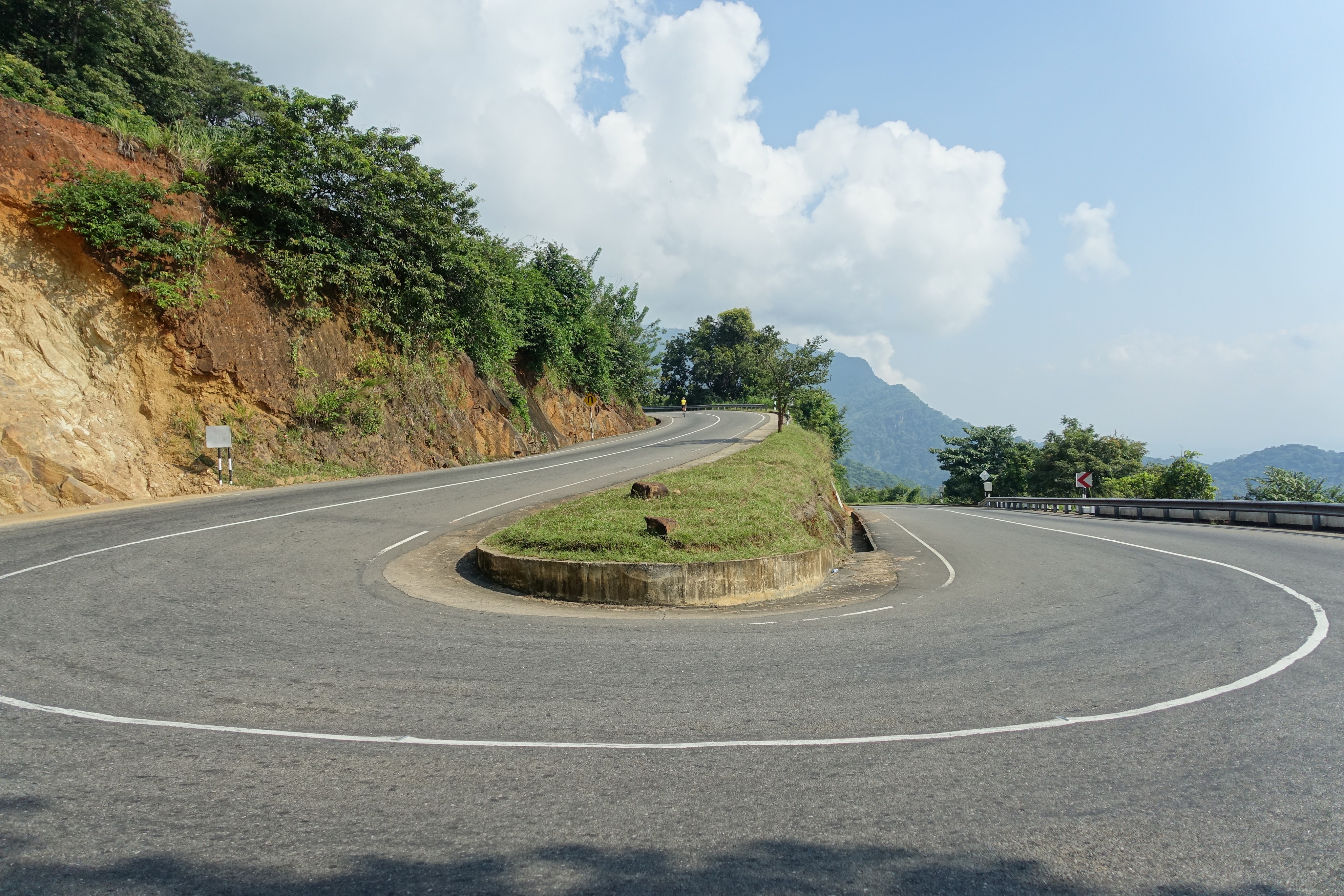 Sumti climbing the A26 towards Daha Ata Wanguwa
Sumti climbing the A26 towards Daha Ata Wanguwa
We followed more sedately and soon reached the 875-metre pass at Daha Ata Wanguwa. From there to Kandy, the road got progressively busier. The last few kilometres into the city were bonkers. We had one bit of relief at the amusingly named Onara Food Court, where we had a delicious buffet which included fine brinjal and potato curries.
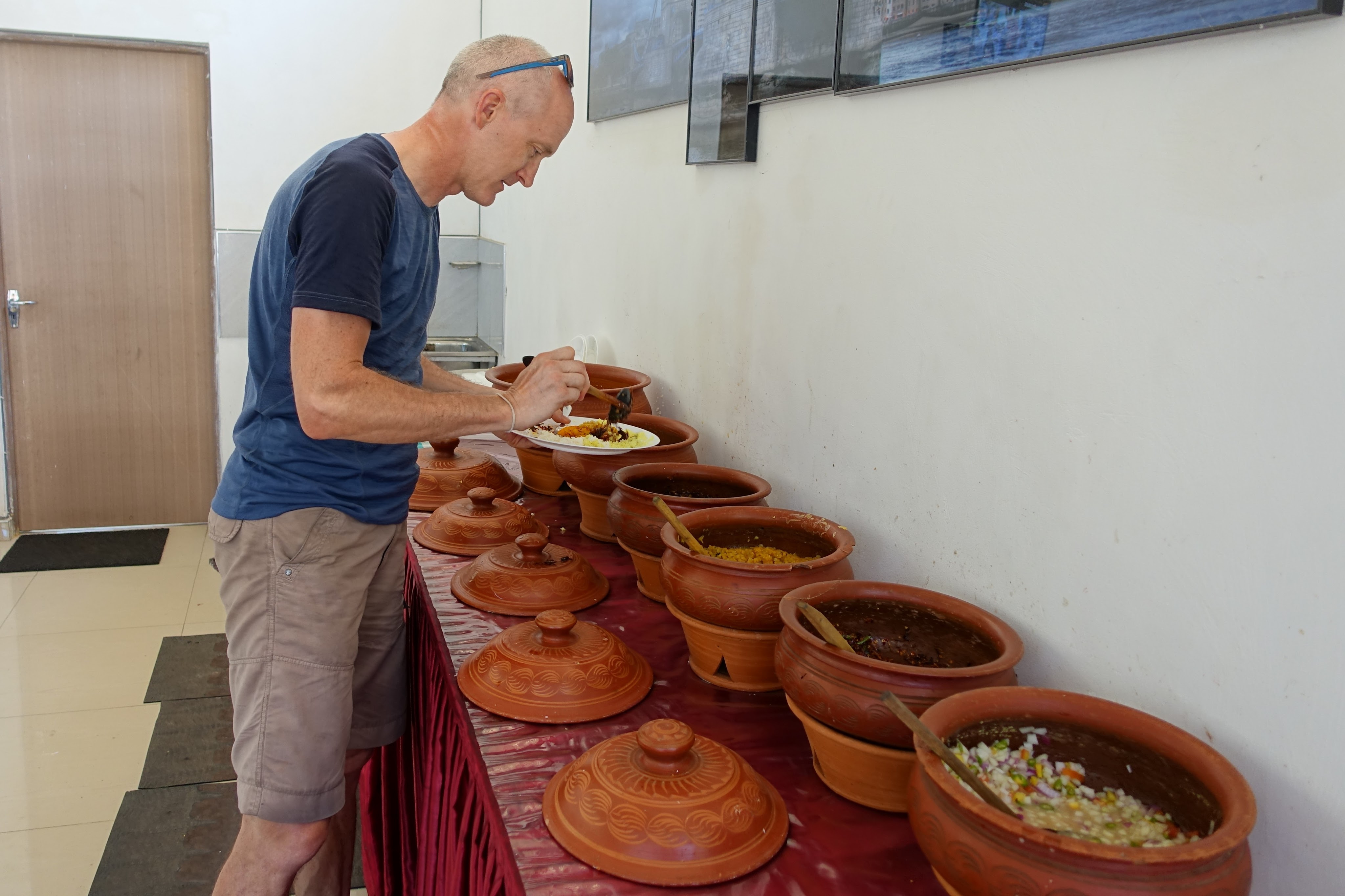 Onara Food Court
Onara Food Court
Riding into Kandy was rather hellacious. The city is plagued by exhaust-spewing, ear-shattering traffic. We slowly ground our way up the steep, winding road towards the lake, and then descended to find the former beauty of the lake transformed by heaving traffic. We finished with a steep climb up to the Hotel Sharon where we had phoned for a room. It is a nice place, but the room was tiny and right next to an extension they were having built. It was very noisy, so we made our apologies and went in search of somewhere quieter. A few doors down we found the delightful Expeditor guest house run by a lovely woman. We got two rooms for just 3250/- each, our negotiating powers strengthened by cancellations brought on by the coronavirus. The rooms were small, but the balconies all round offered fine views of Kandy, and there was a pleasant lounge.
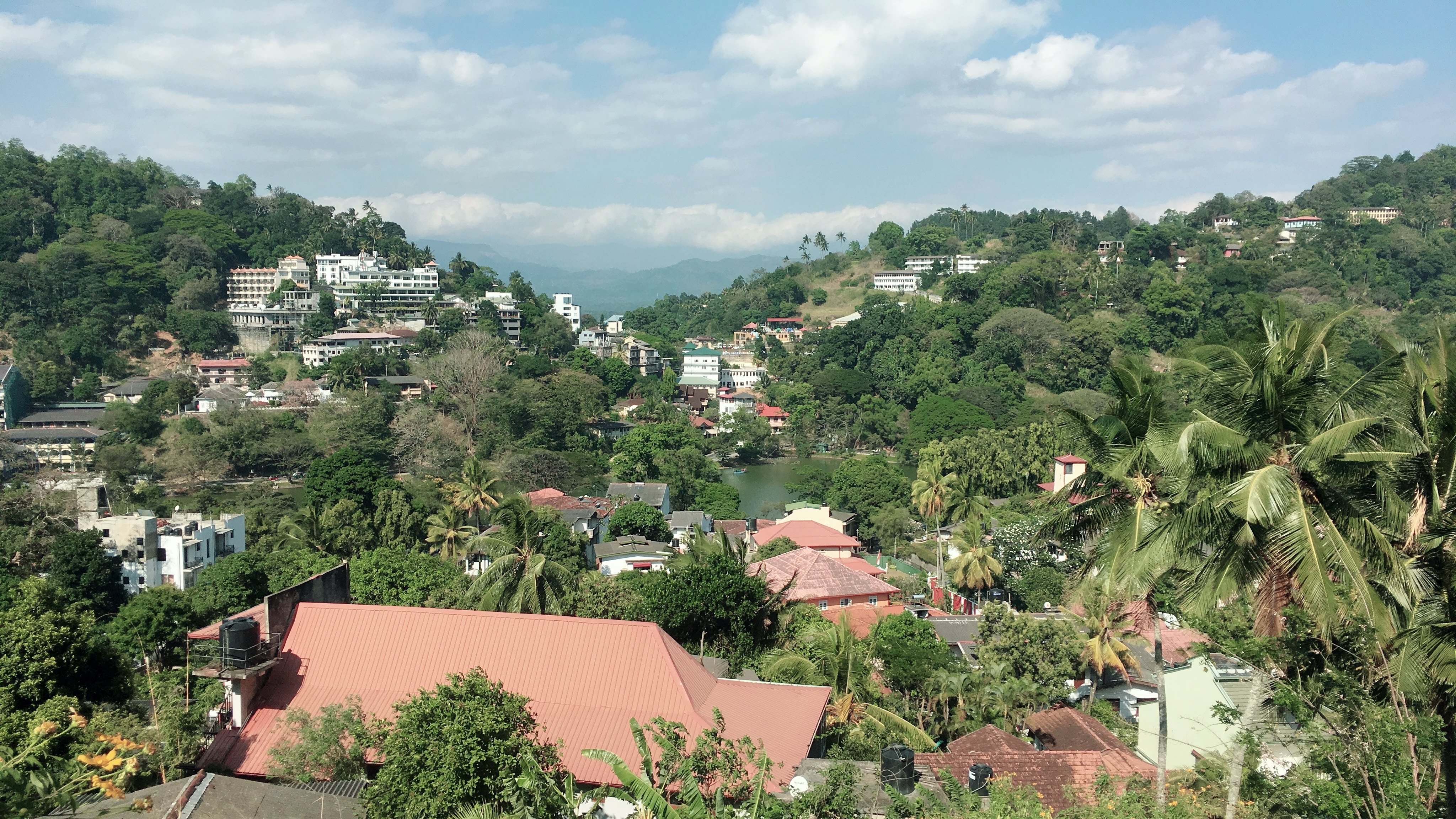 View from Expeditor guest house
View from Expeditor guest house
 Kandy Lake
Kandy Lake
In the afternoon, we walked around the lake to the accompaniment of roaring engines and loud horns. The far side of the lake has no road, so that part was very pleasant. We ate excellent South Indian food at Sri Krishna Dosai where Sri Lankans and tourists filled up on big portions of low-priced cuisine. Later, we sat on the second floor of the guesthouse planning the next day’s ride, while below us the sound of chanting rose up from a Buddhist ceremony held in honour of the owner’s husband. Our plan was much the same as usual. Head off in the direction of our next destination, look for quiet roads to ride on, and see what happens.
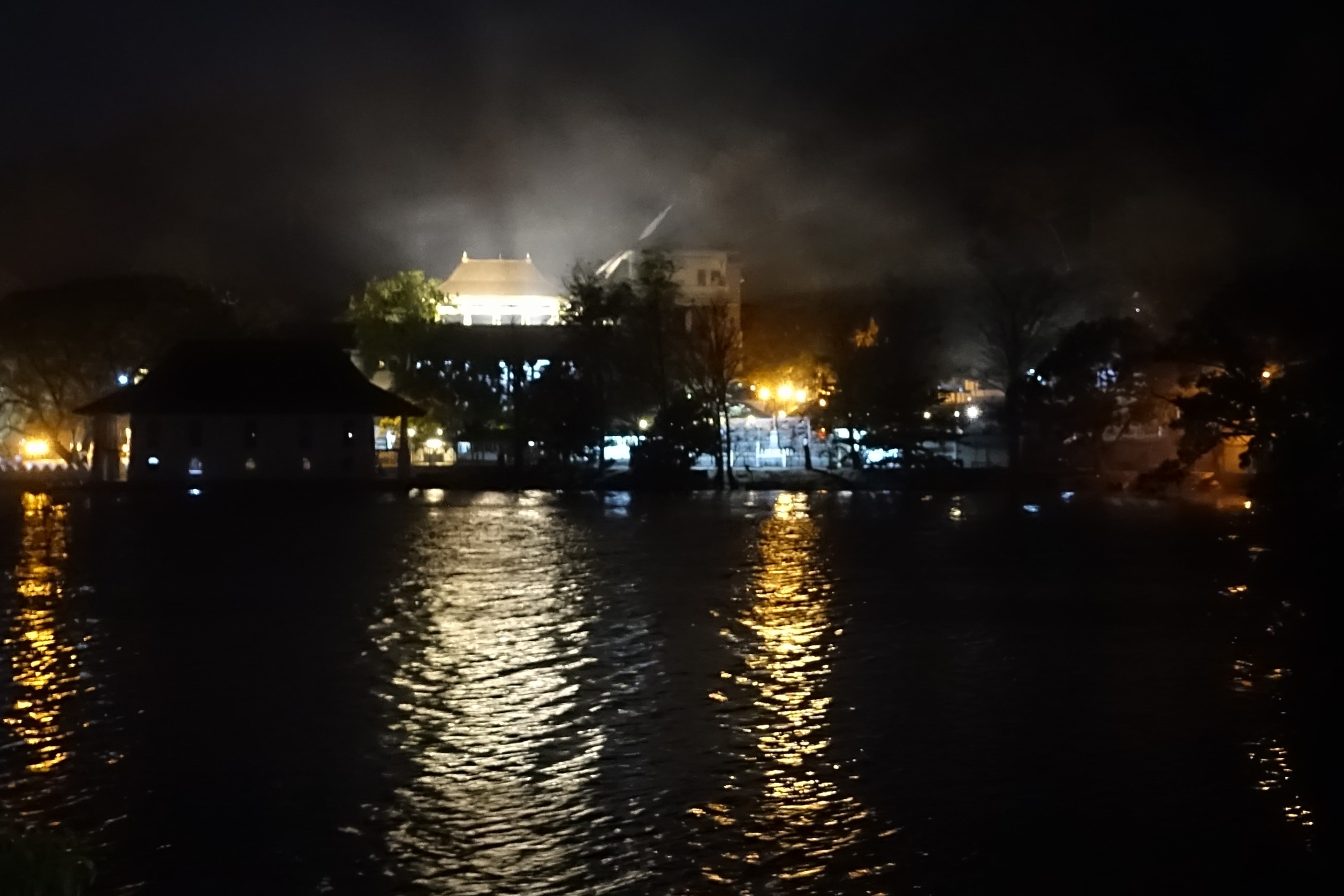 Kandy Lake
Kandy Lake
Saturday, Feb 29 – Kandy to Nuwara Eliya 112 km
 Tea above Kandy on the Hantana Road
Tea above Kandy on the Hantana Road
What a day. 9.5 hours to ride 112 km with 2,500 metres of elevation. We started at 7:30 a.m. and finished at 7:40 p.m. That would be hard work on a road bike, but on a heavy touring bike with fat tyres on bumpy roads, it was an epic. Along the way we cycled along some of the most beautiful roads I have ever ridden, and towards the end had to climb some of the steepest.
We started with egg and toast at the Expeditor and then headed expeditiously out. We rolled down to the lake, which was already packed with traffic, but soon left the main road to climb steeply up a winding road that brought us to our first tea plantations. It was a tough start to the day, but at the top of the hill we could rest at a tea stand set amongst the trees and tea bushes. Tea and cycling: the perfect combination. We descended a way before starting to climb very gently on a fantastic road which contoured for miles and miles through beautiful old tea estates. The road was smooth, the slope gentle, the traffic light, and the scenery stupendous. It is one of the world’s great cycle rides.
 Climbing through tea plantations
Climbing through tea plantations
This is what I like best about cycle touring: not knowing what you are going to find each day, going where the road takes you, the random chance of taking a right turn or a left turn, coming across a beautiful place. There is plenty of discomfort along the way, but that moment of setting eyes on a magnificent view, meeting a fascinating stranger, or simply rolling effortlessly through serene countryside is what draws me to this. I sometimes wonder why so few other people have yet to discover the joy of cycle touring.
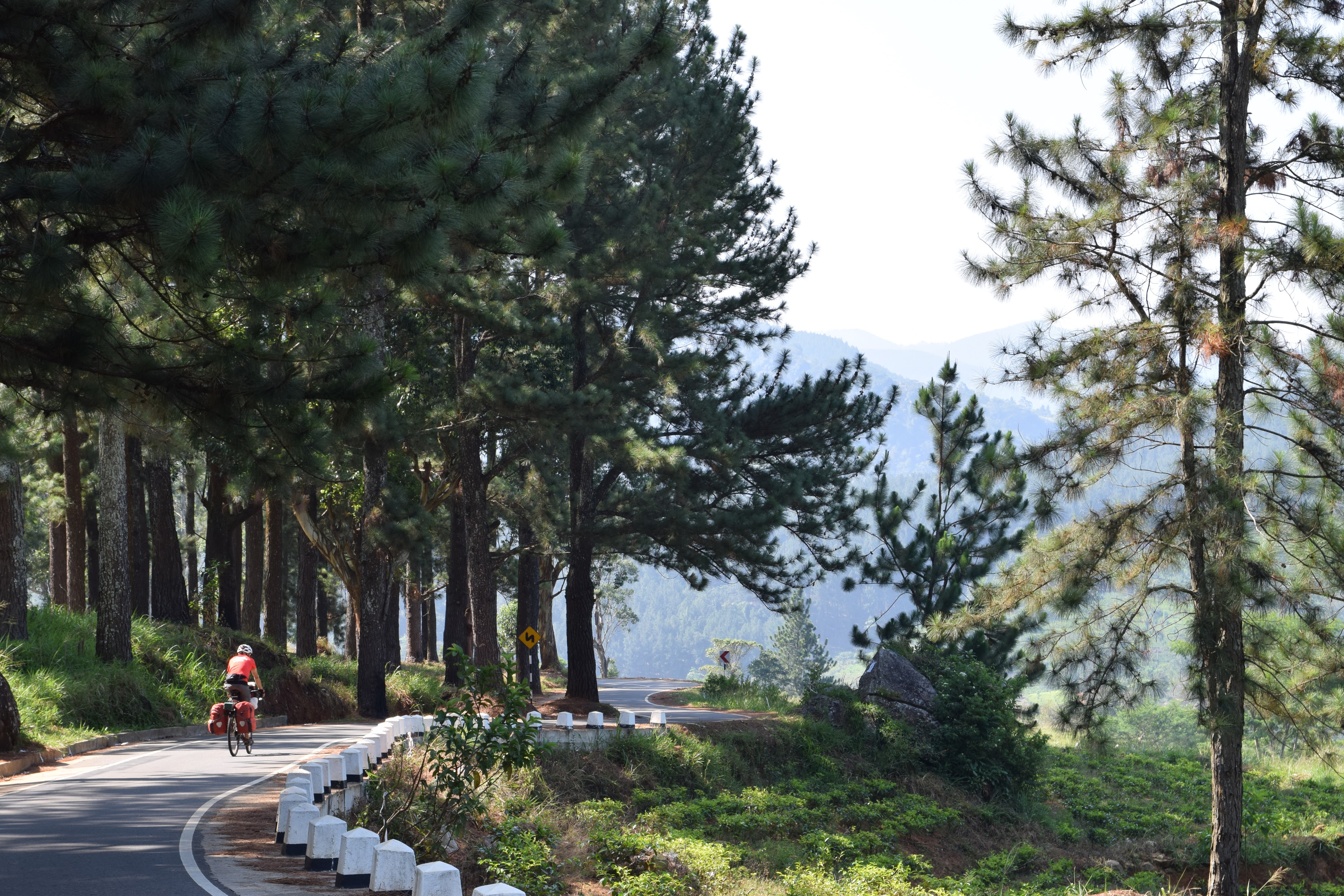 The beautiful road from Hantana to Galaha
The beautiful road from Hantana to Galaha
Our plan, if you could call it that, was to get to Nuwara Eliya, or somewhere close, without using the busy A5. We would first head for Galaha, then follow the B364 to Rikillagaskada. the B413 to Ragala, and the B332 towards Nuwara Eliya. Hopefully, there would be a guest house somewhere along the way. Our fine, quiet road took us all the way to Galaha, but after that the B364 was both busier and much bumpier. It continued like this all the way to Rikillagaskada, but still it was great riding. At Hewaheta we had a decent lunch in the usual curry restaurant, and then found relief on the B413 which was quieter and much smoother. We stayed on the 413 for hours, riding through villages, tea estates and forests, past waterfalls and mountain views far and wide. The climbs started to get steeper, but not too bad. From time to time I checked the altitude on my watch and wondered when we would gain the height we needed to reach Nuwara Eliya at 1850 metres.
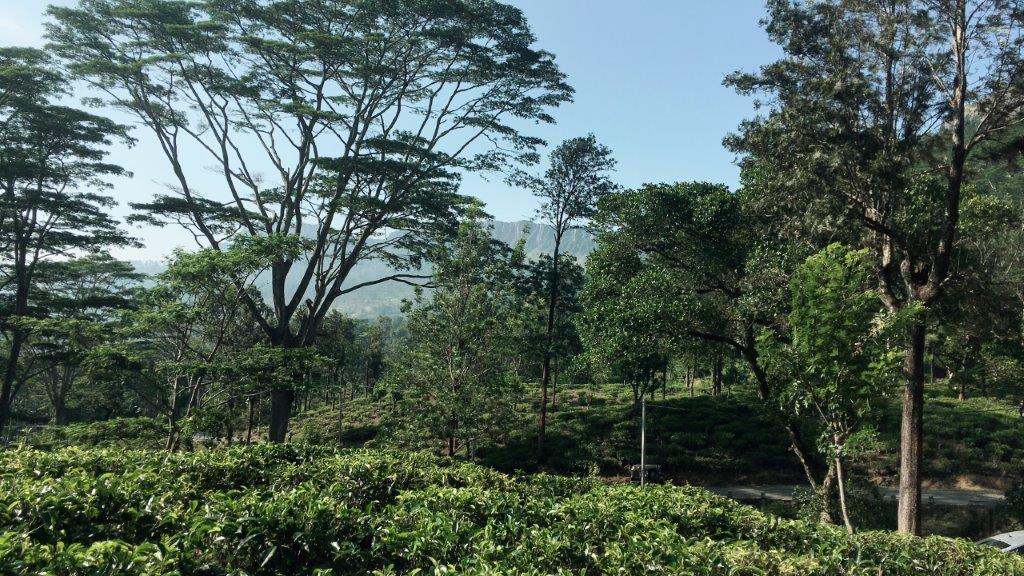 The gorgeous scenery took the sting out of the climb
The gorgeous scenery took the sting out of the climb
We got the answer at Walapane where the road suddenly ramped up to a shocking 20% for a few hundred metres. At the top of the slope a sign suggested that there is a hotel back down in the town, but we weren’t going back down that slope to discover if it was true. We hadn’t seen a hotel all day; it looked like we had a long ride ahead of us. We had. We slowly ground our way up through one tea plantation after another – these were less attractive than the ones earlier in the day, or perhaps we were just tired. Gradually, night fell as did a blanket of mist. Tea pickers carried heavy sacks in from the fields to be weighed, buses roared past, Hindu temples blared music, we pedalled on.
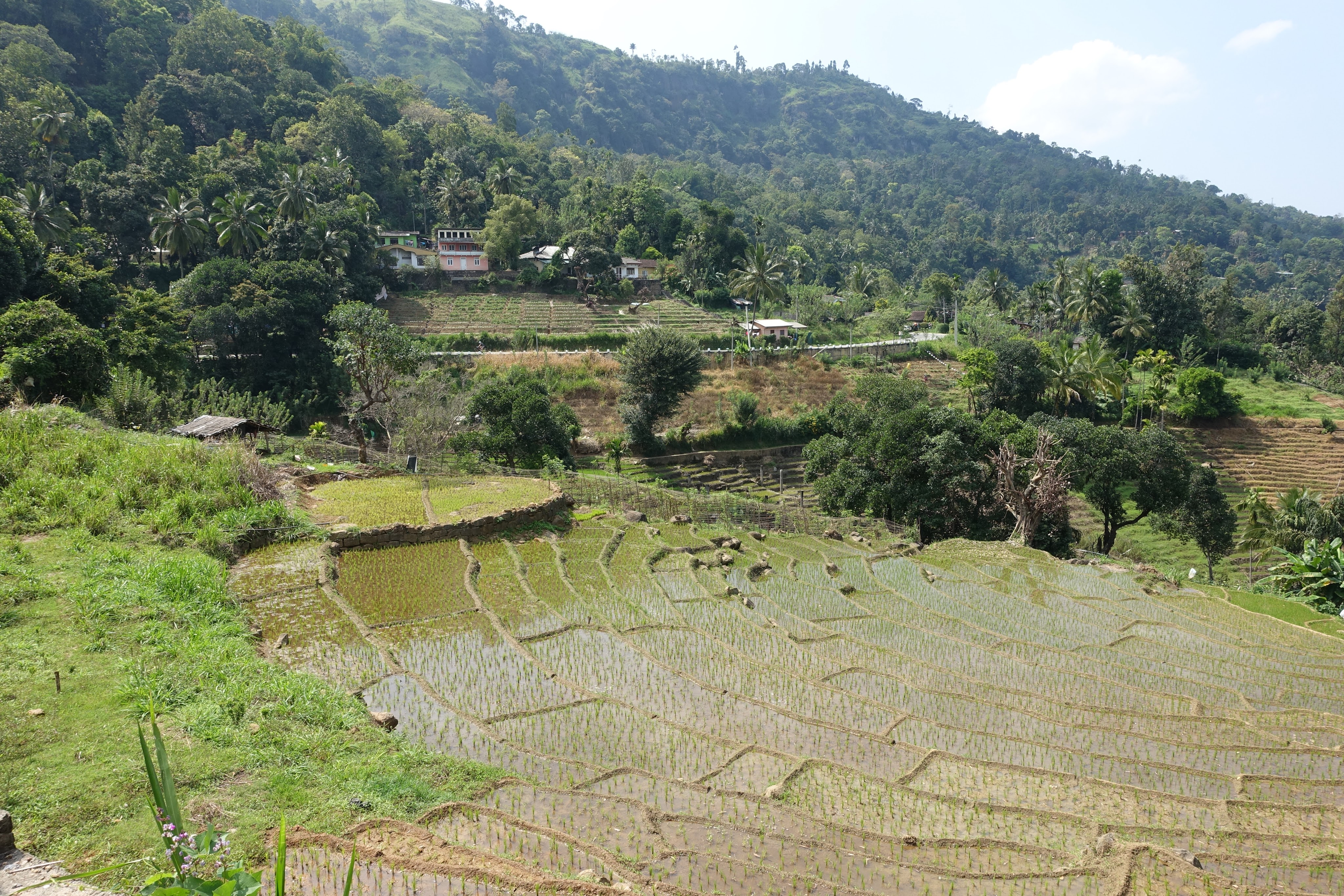 On the final climb to Kandapola
On the final climb to Kandapola
Near the top, the mist got thicker and the traffic heavier. Each truck or bus would shock us with their horn and dazzle us with their full beams; we just had to focus on riding steadily and safely. Finally, we reached the top at Kandapola, a chaos of noise and fumes and lights. There was still 12 kilometres to go to Nuwara Eliya, but fortunately it was mostly flat or slightly downhill the whole way. We had to be careful, especially of the buses which seem to be driven my insane sociopaths, but finally we made it to the beautiful Trevene Hotel, a reward for the hard day behind us. It is a fantastic colonial house set back from a quiet side street in pleasant gardens. We splashed out on excellent single rooms for 5000/- each, and then walked over to their adjacent upmarket hotel for an upmarket buffet of Western food. It was our first taste of such food on our trip. The cauliflower cheese alone made up for the last hour up that climb.
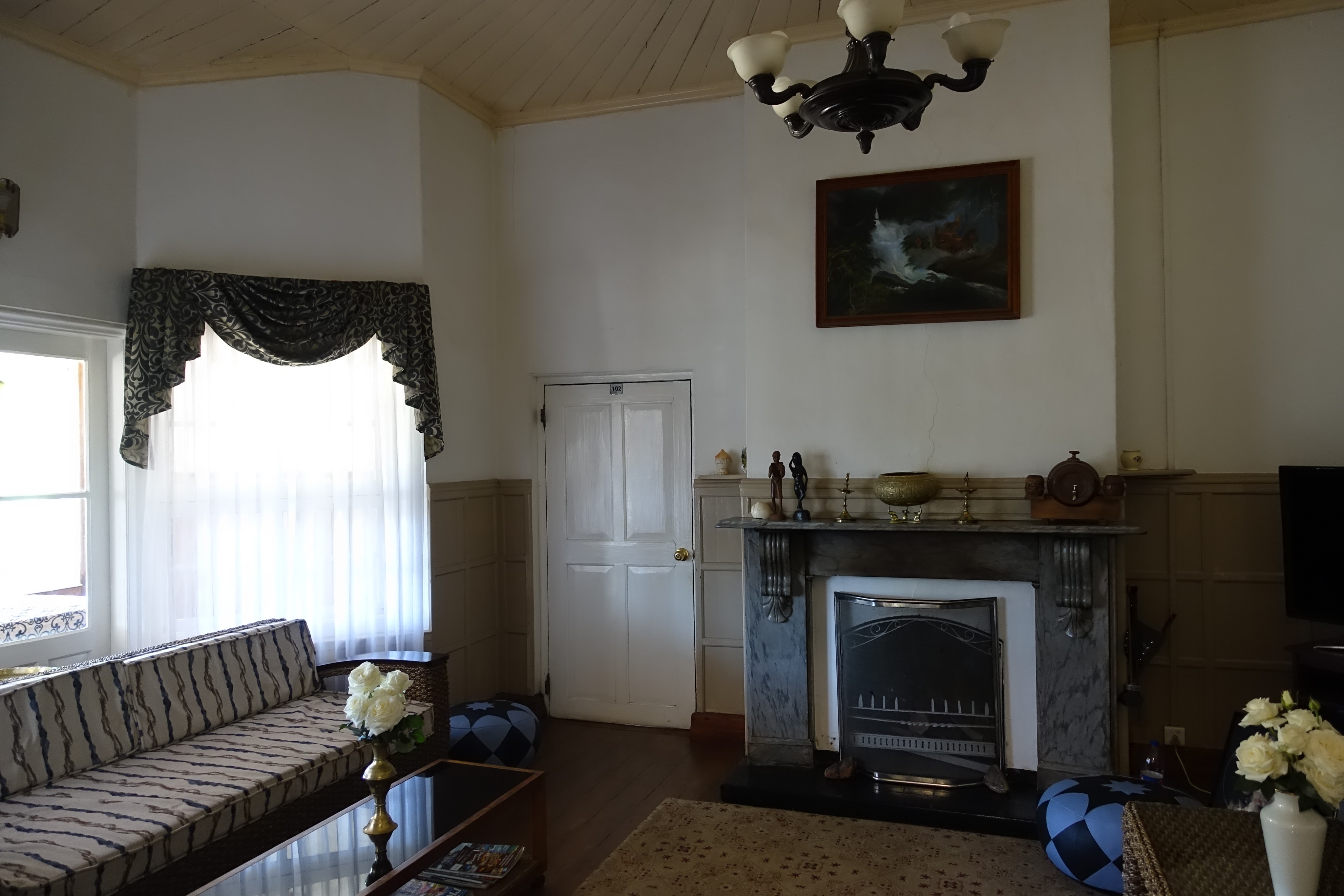 Lounge in the Trevene Hotel
Lounge in the Trevene Hotel
Sunday, March 1 – Nuwara Eliya to Passara 77 km
 Lake Gregory, Nuwara Eliya
Lake Gregory, Nuwara Eliya
Today was supposed to be a nice easy ride to Ella which came highly recommended in the guidebook. That should have raised a warning flag. We allowed ourselves the luxury of a slow start – a massive breakfast back in the buffet hall followed by leisurely packing. After photographs in the gardens outside the Trevene, we cycled down to the lake, avoiding the centre of Nuwara Eliya altogether. Next to Lake Gregory, there is a somewhat incongruous sight – a racecourse with horses and riders getting ready for training. The lake itself is a pretty place with parks around it and boats waiting for customers. From there we started a long 24-kilometre descent on the A5 to Wellimada. Being Sunday, the traffic was light which made the ride down beneath the cliffs of the Horton Plains quite pleasant.
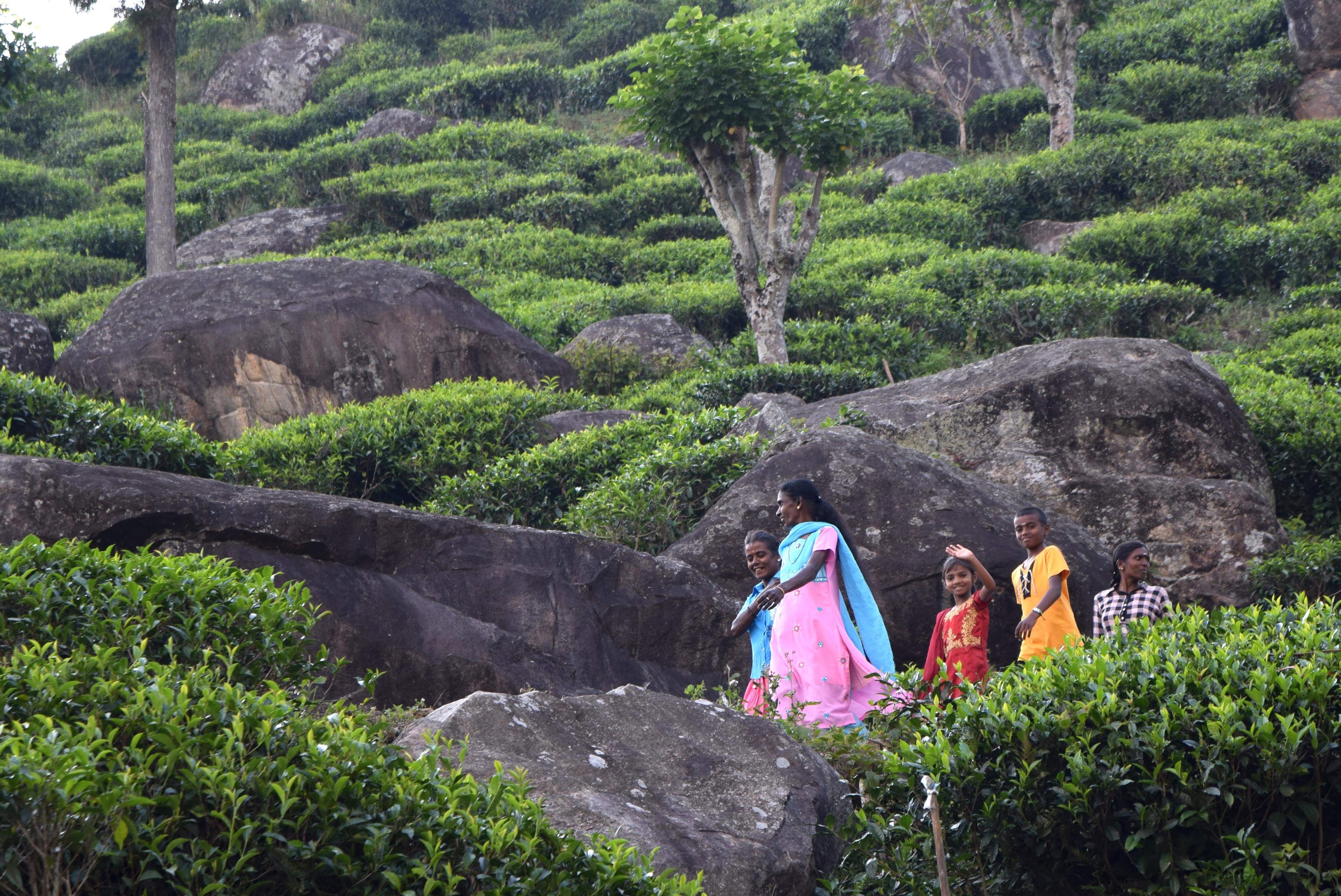
From Wellimada, we took the B44 which was a little busier than we had expected. There were guest houses all along this road dotted amongst the tea plantations. We stopped at one sales place where we hoped to learn about fine teas and buy some to take home. Instead, very ordinary-looking tea was being sold for very extraordinary prices. There was no tasting. I decided to stick to my usual Earl Grey and Assam from the Co-op.
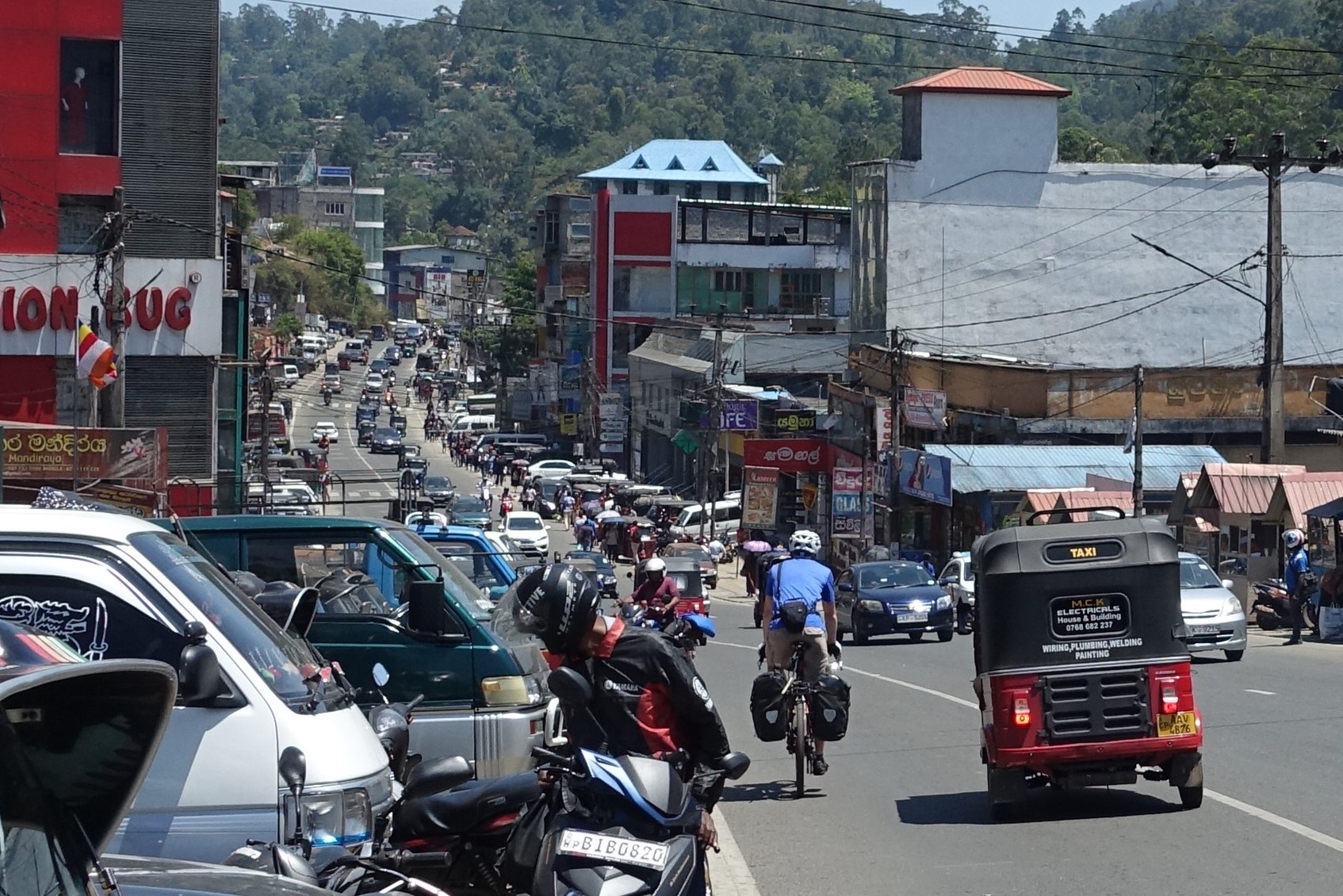 Bandarawela
Bandarawela
Bandarawela is a big chaotic town. Fortunately, the main A16 is downhill here so we could roll fast through the chaos and quickly reach the turn off for Ella 8 km below. We arrived in Ella expecting an oasis of mountain beauty, but in reality it is a typical travellers’ hangout lined with cafes and restaurants packed with young backpackers in search of exactly the same unique experience as every other backpacker in Sri Lanka. We had a big lunch, including 3 banana pancakes each, and headed out.
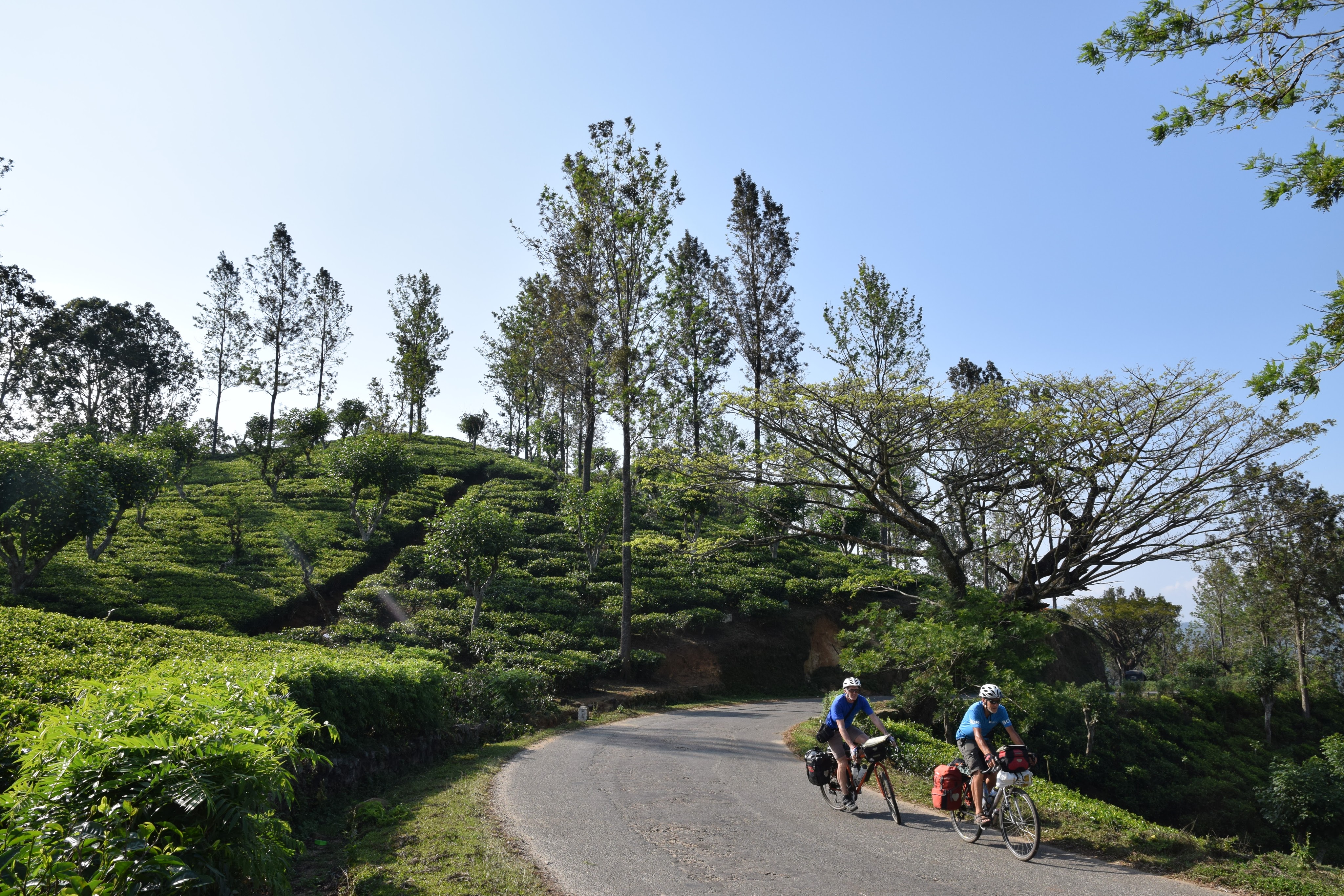 Great riding on the B113
Great riding on the B113
We had a choice here of riding south towards the coast on the A23 or east around the mountains on the B113. We had not yet had our fill of the mountains, so we continued east towards Passara. We soon left behind the string of tourist facilities promising meditation and massage and Ayurvedic healing and were once more climbing up a quiet, bumpy lane into tea country. After a morning of easy rolling, and a huge lunch, it was hard to be climbing again. We climbed and climbed several hundred metres to 1429m, but the road was empty and the views beautiful. We then had 12 km downhill to Passara where we decided to look for a place to stay. Google Maps threw up Morris Bungalow which turned out to be a great discovery. It is a former colonial residence now owned and well-maintained by the proprietors of a tea transportation firm. The sprawling stone bungalow is set in manicured lawns with vistas of surrounding mountains. The owners are a husband and wife who first appeared reserved but gradually seemed to warm to us. We were shown to rooms over a garage used by the trucks, but on inquiry found that we could also stay in the house. We chose a wonderful room with massive bay windows, creaking wooden floors, and a bathroom unchanged since colonial times. The bath was a huge cast iron tub set on ornate feet with massive chrome taps.
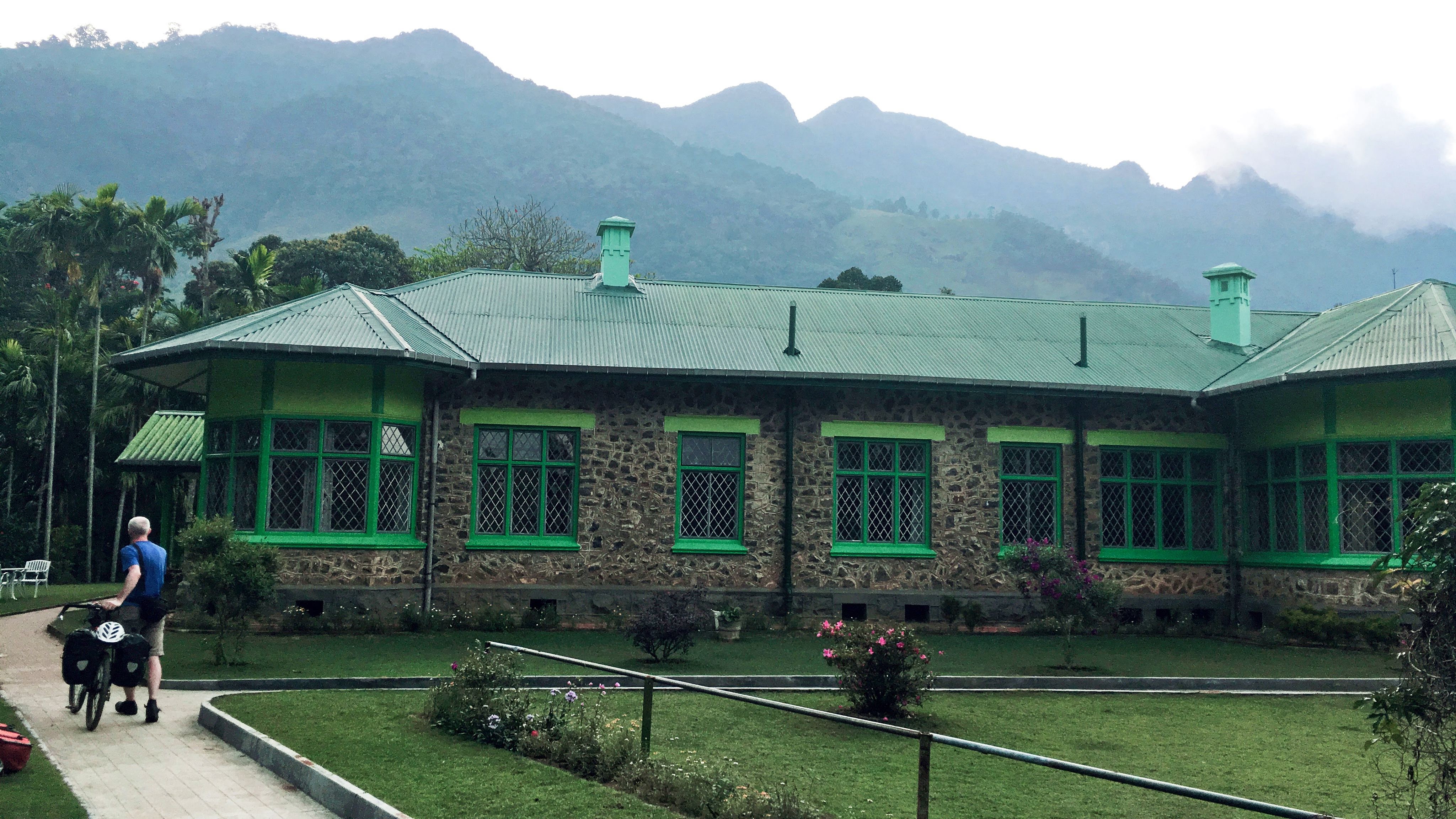 Morris Bungalow
Morris Bungalow
Seeing as the owners ran a tea transport business, I asked about the possibility of buying some tea. They came back with half a kilo of tea in a plain plastic bag from a Gonakelle Estate. It was a twentieth of the price of the tea we’d seen at the posh vendor. Dinner was cooked for us by their domestic help who seemed to manage the whole place for them. It was served in a grand wood-panelled room with old pictures of the family on the walls. We sat at a long dining table with space for another dozen people. The owners did not eat with us; instead, they stood by the table observing us and constantly checking that everything was to our liking. It was!
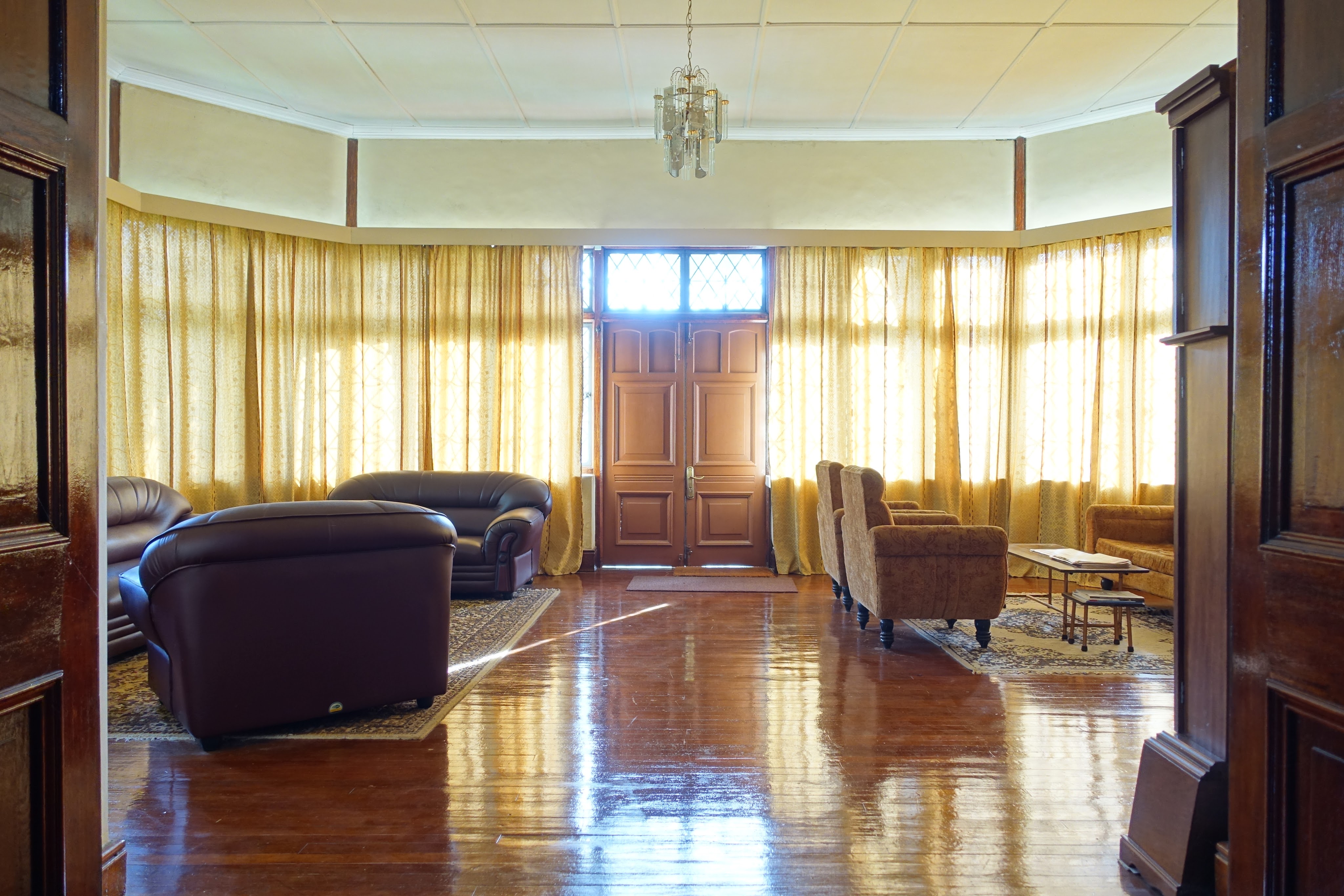 Morris Bungalow elegance
Morris Bungalow elegance
Monday, March 2 – Passara to Kirinda 116 km
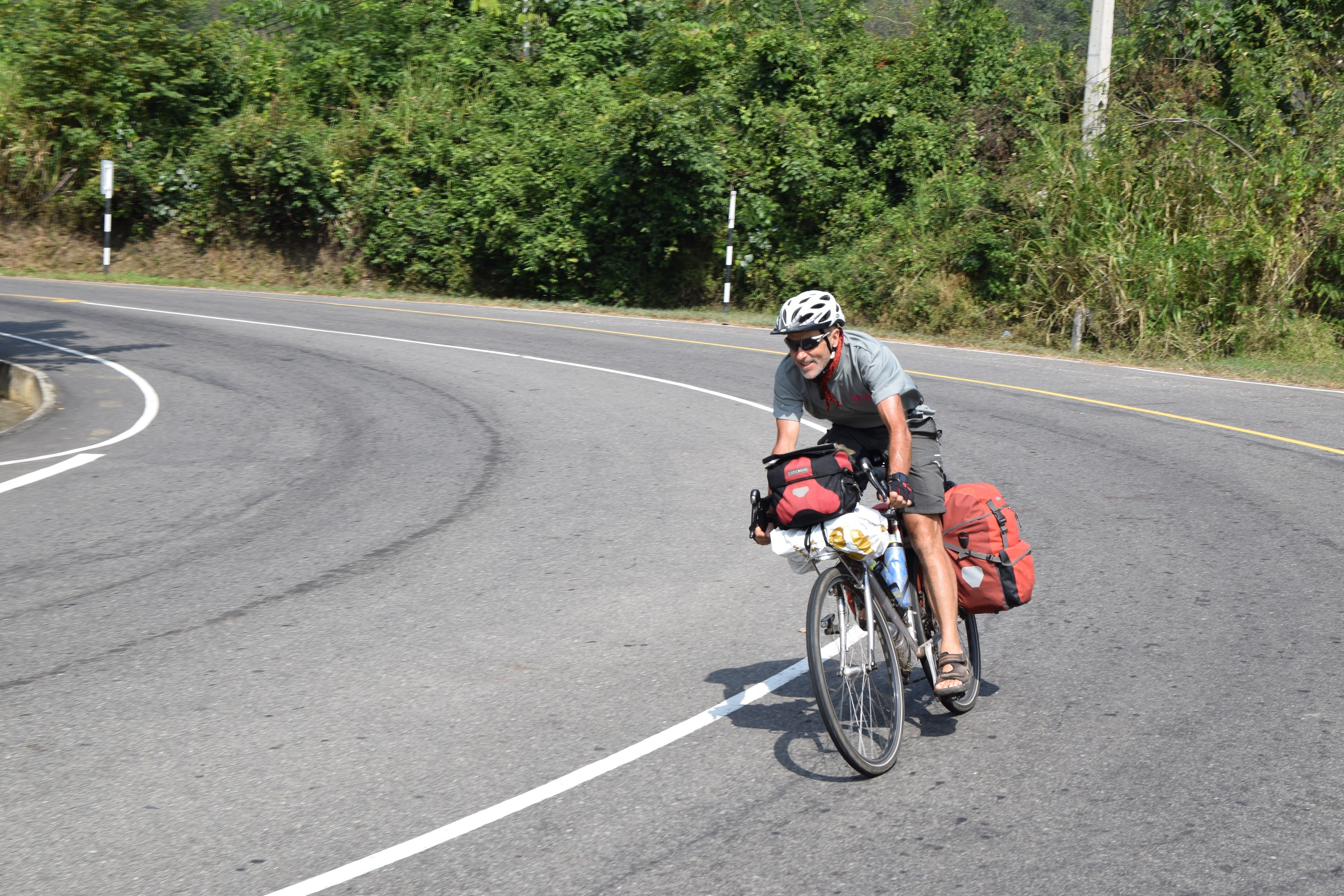 Long descent on A22
Long descent on A22
We started the day with a traditional Sri Lankan breakfast of idiyappam or string hoppers which are nothing if not filling. After much photographing and exchanging of contact details, we set off along the A5 towards the B35 which would take us all the way to the south coast. The descent of the mountain offers fine riding on smooth, gently downhill roads. We swept around one wide curve after another on the almost traffic-free A5 and then the even quieter A22. At Badalkumbura we turned right on to the B35 which runs directly south to the coast. We were aiming for Kirinda which we hoped would be a quieter resort than the more touristy ones further west.
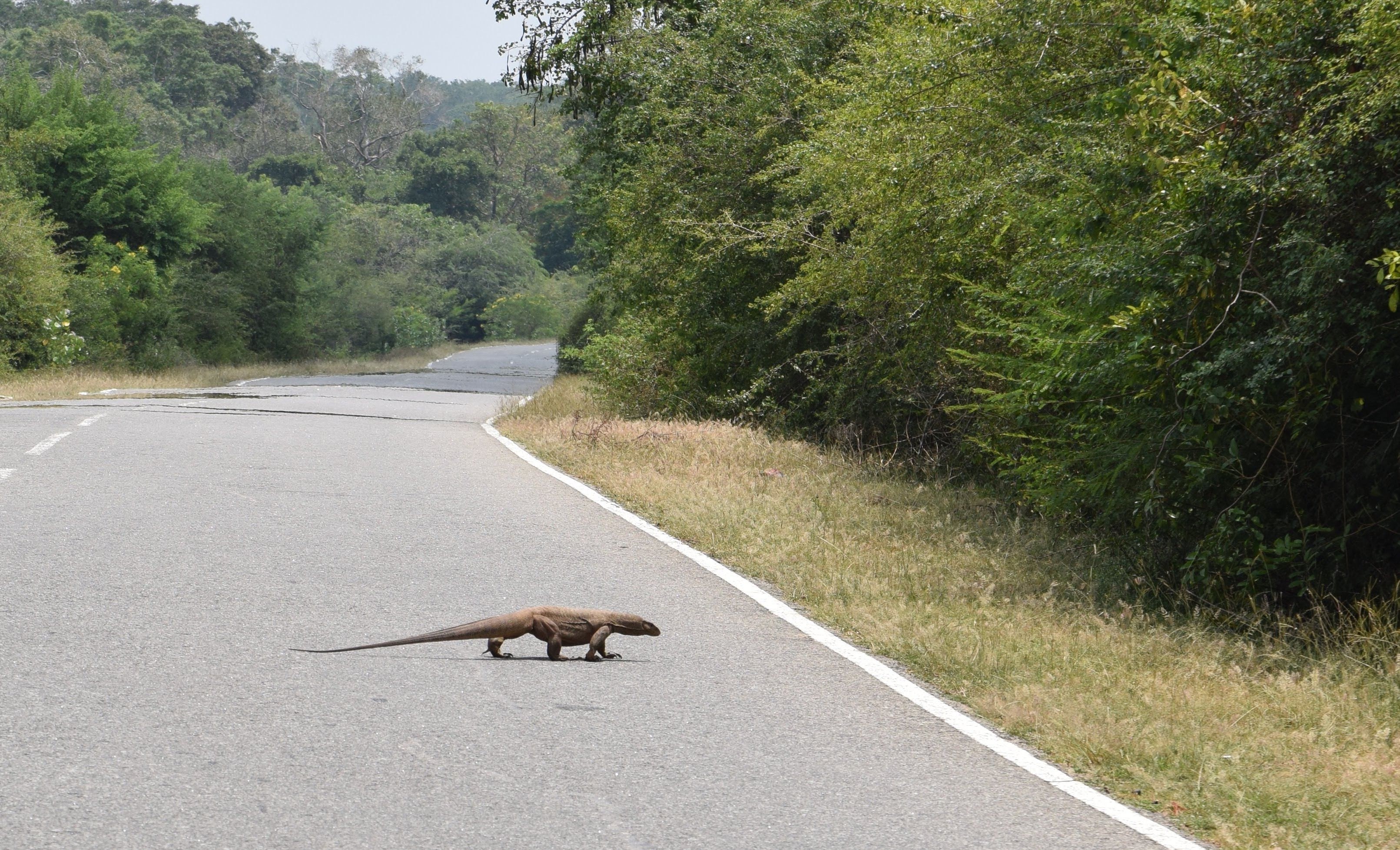 Monitor Lizard
Monitor Lizard
The first part of the B35 to Buttala is an excellent, quiet road, although there are a lot of short, sharp ascents over the last of the foothills. At Buttala, we crossed over the A4 and from then on there is very little traffic at all. After 15 kilometres or so, we entered Ruhuna (Yala) National Park which is simply beautiful. There are no buildings and hardly any cars – just raw nature which we were given the privilege of riding through. On one straight section of the road, we spotted a huge elephant standing across the road. We rolled to a stop a hundred metres away and waited for it to move. And waited and waited. A couple of cars slowly manouevred around it, but we weren’t sure if that would be too wise on a bicycle. In the end, it sedately strolled off into the forest. Another unforgettable experience.
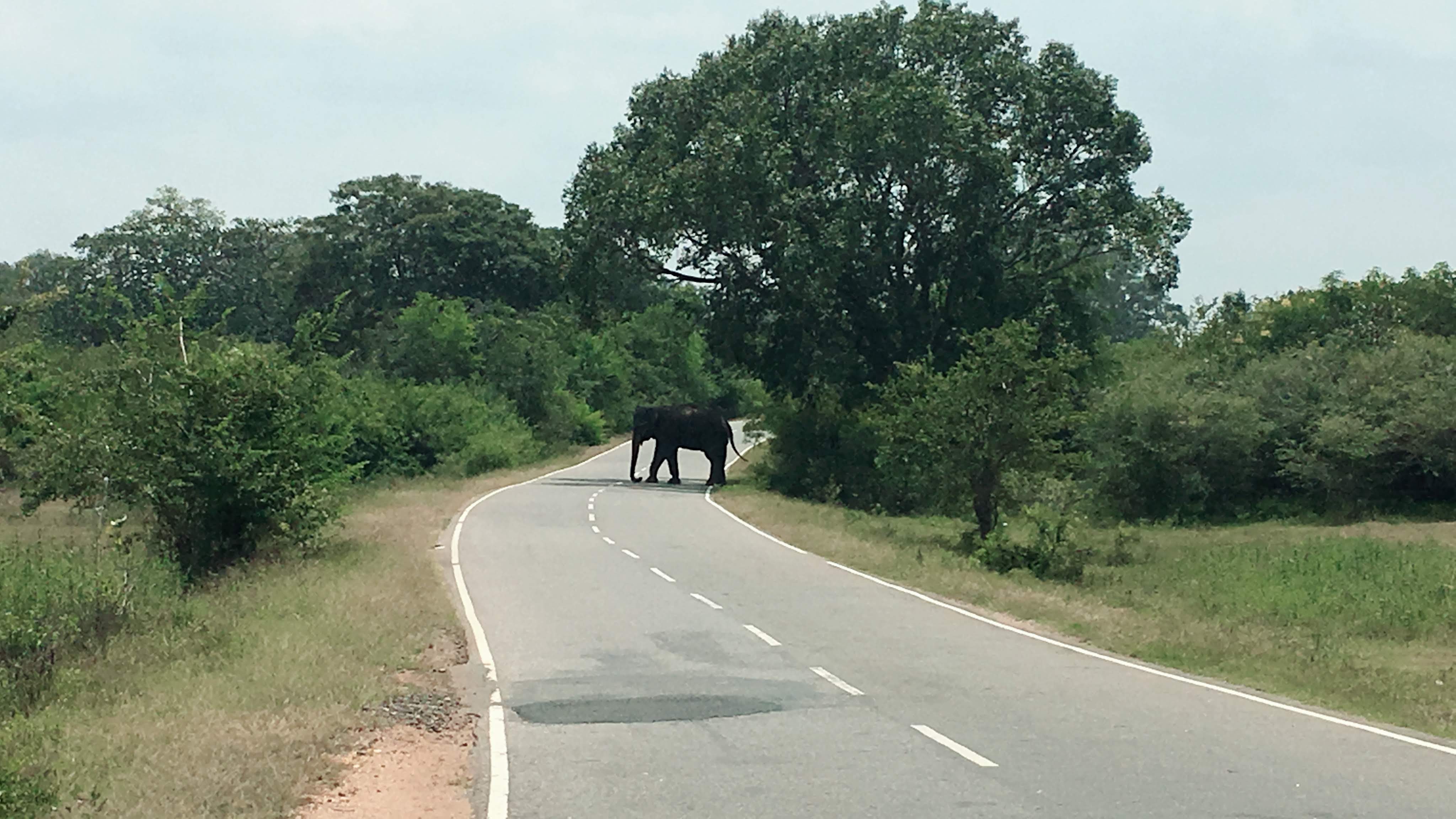 B35 through Ruhuna National Park
B35 through Ruhuna National Park
Just before Kataragama, near the “Elephant Gate” entrance to the national park, we stopped for our regular veggie curry lunch buffet, but this time it was just too hot for me. I was reaching my Sri Lankan curry tolerance threshold. From here to Tissamaharama, the road is lined with hotels, guest houses, and “rooms” serving the Ruhuna NP tourist trade. However, there were few tourists around, which we later learned was due to Covid-19. We had been blissfully insulated from this on our ride, but once we reached the tourist south coast, it became clear that most of the hotels were nearly empty of guests.
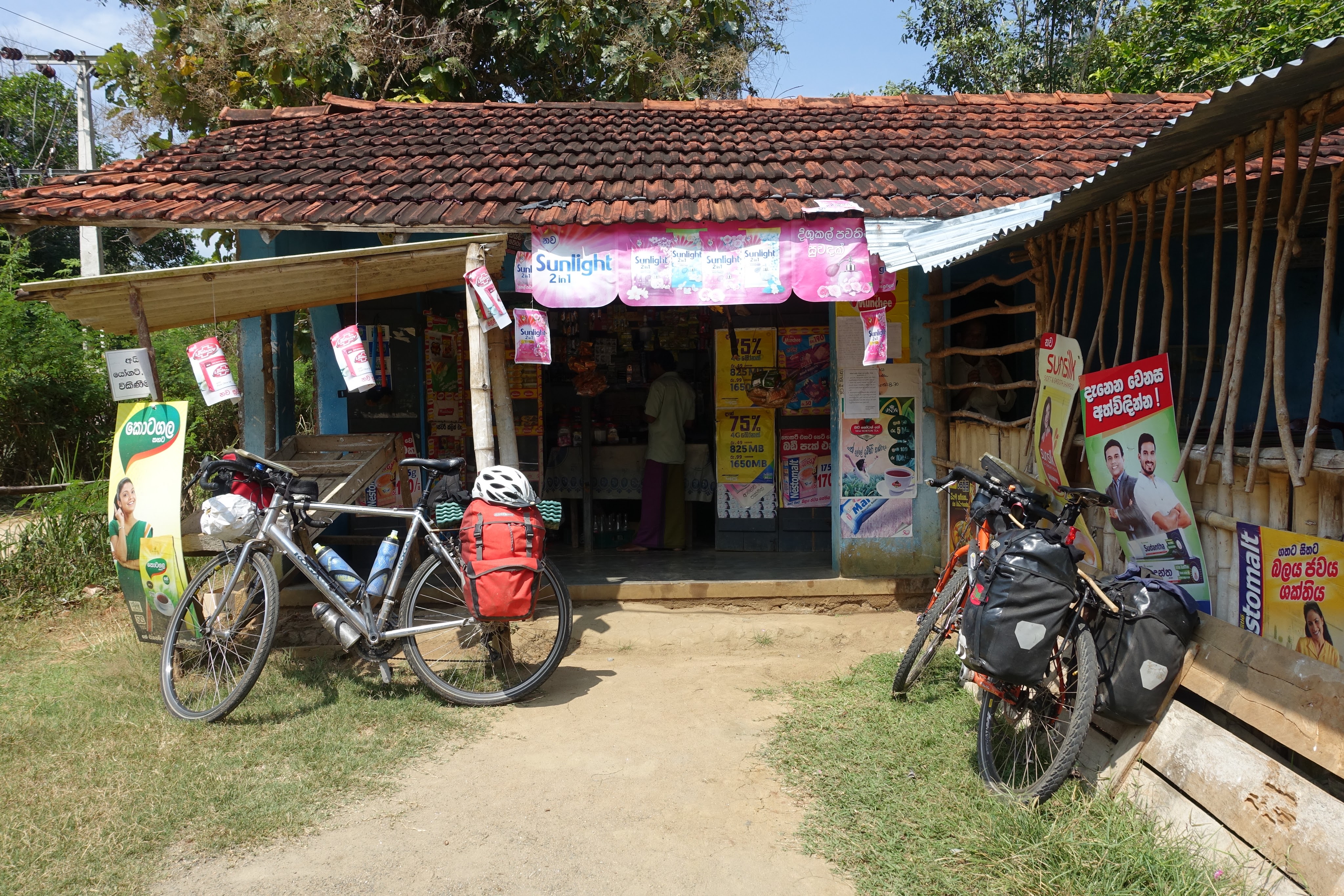
The last stretch to Kirinda is very pleasant. At Tissamaharama, we cycled past a lovely stupa in a vividly green rice field, and then alongside Yoda Lake with flags fluttering on bamboo poles stuck in the lake. It was great riding through this beautiful tropical landscape.
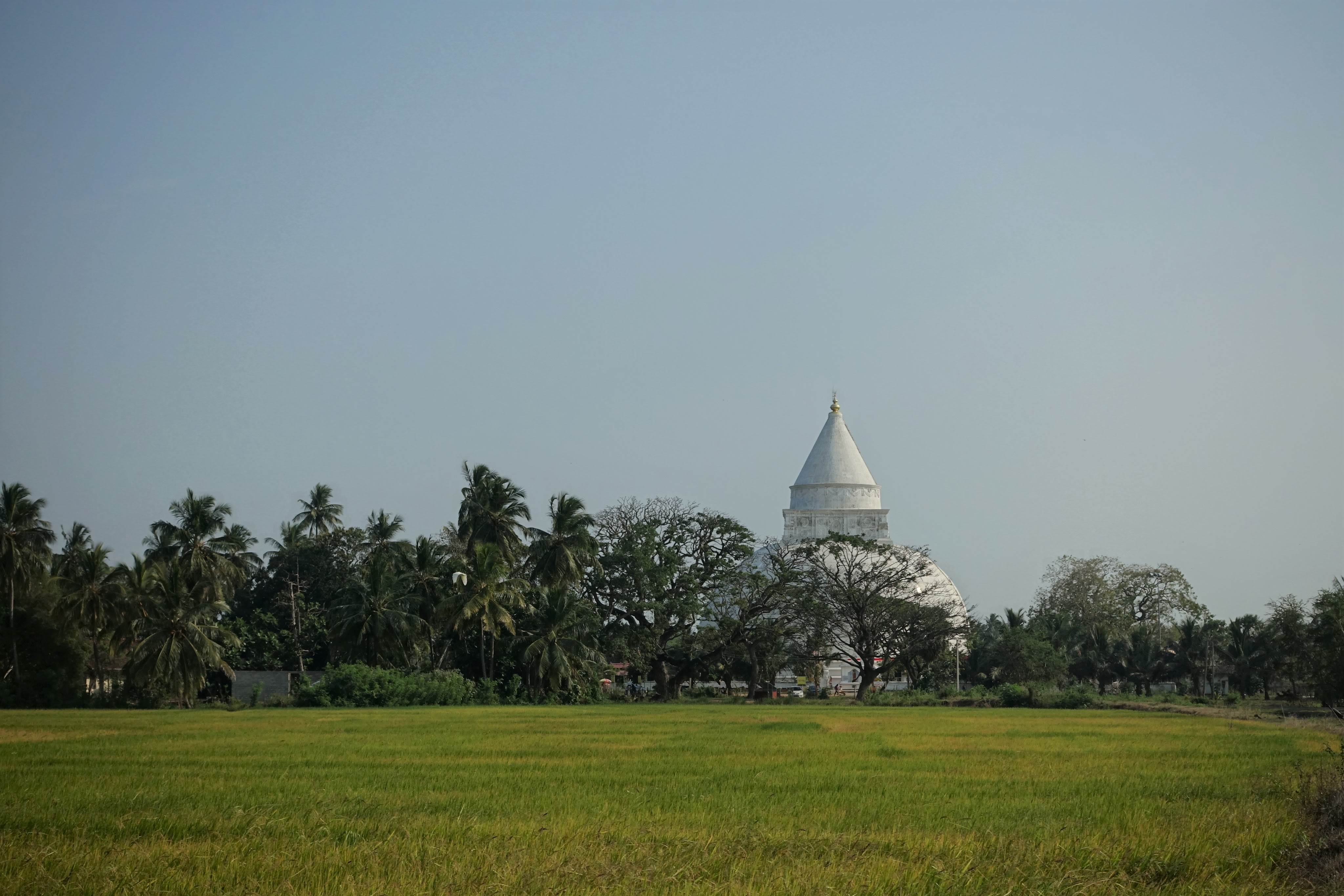 Tissamaharama stupa
Tissamaharama stupa
Kirinda town was very quiet. We stayed at the first place we arrived at, the aptly-named Kirinda Beach Front Hotel. We were the only guests so we could have a double room each, with breakfast, for just 6,000/-. It is a simple place with a big walled lawn and a gate on to the beach. The beach itself was a bit of a disappointment – some dilapidated huts, a few stalls selling plastic beach tat, and a big sound system blaring out Sri Lankan pop music onto the almost deserted beach. Still, the garden was a pleasant place to relax in the cool sea breeze. Later we had delicious grilled fish for dinner.
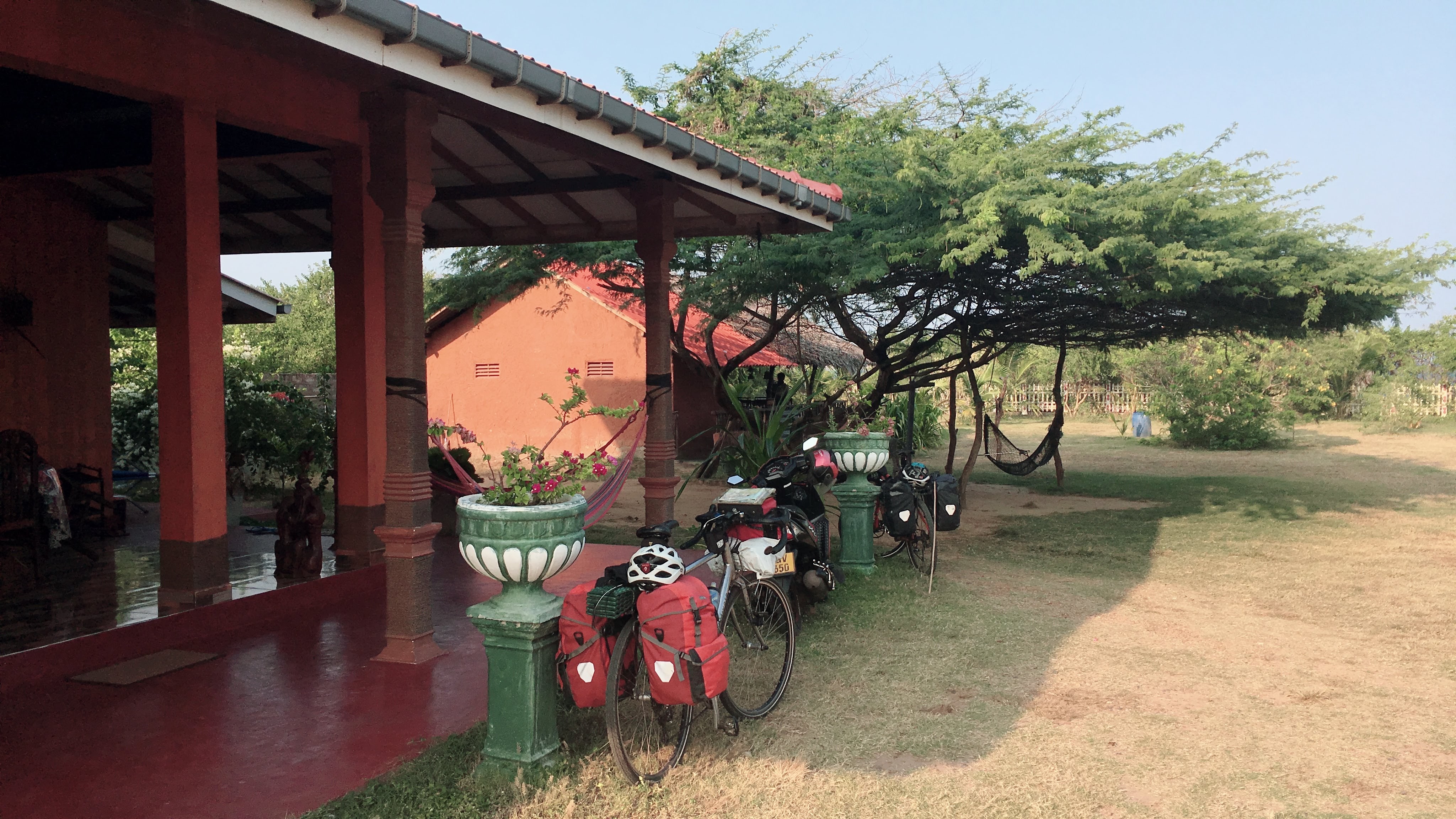 Kirinda Beach Front Hotel
Kirinda Beach Front Hotel
Tuesday, March 3 – Kirinda to Polhena, near Matara 118 km
We decided to aim for Polhena as John’s Routier guidebook strongly recommended the Sunil Guest House. To get there, we would have to ride much of the way on the main A2 coast road, so we expected a hot slog along a busy road. In places it was rather busy, but it was never a slog as we had a side-tailwind. We also had a couple of hours of wonderful riding through a small national park which we hadn’t even noticed on the map.
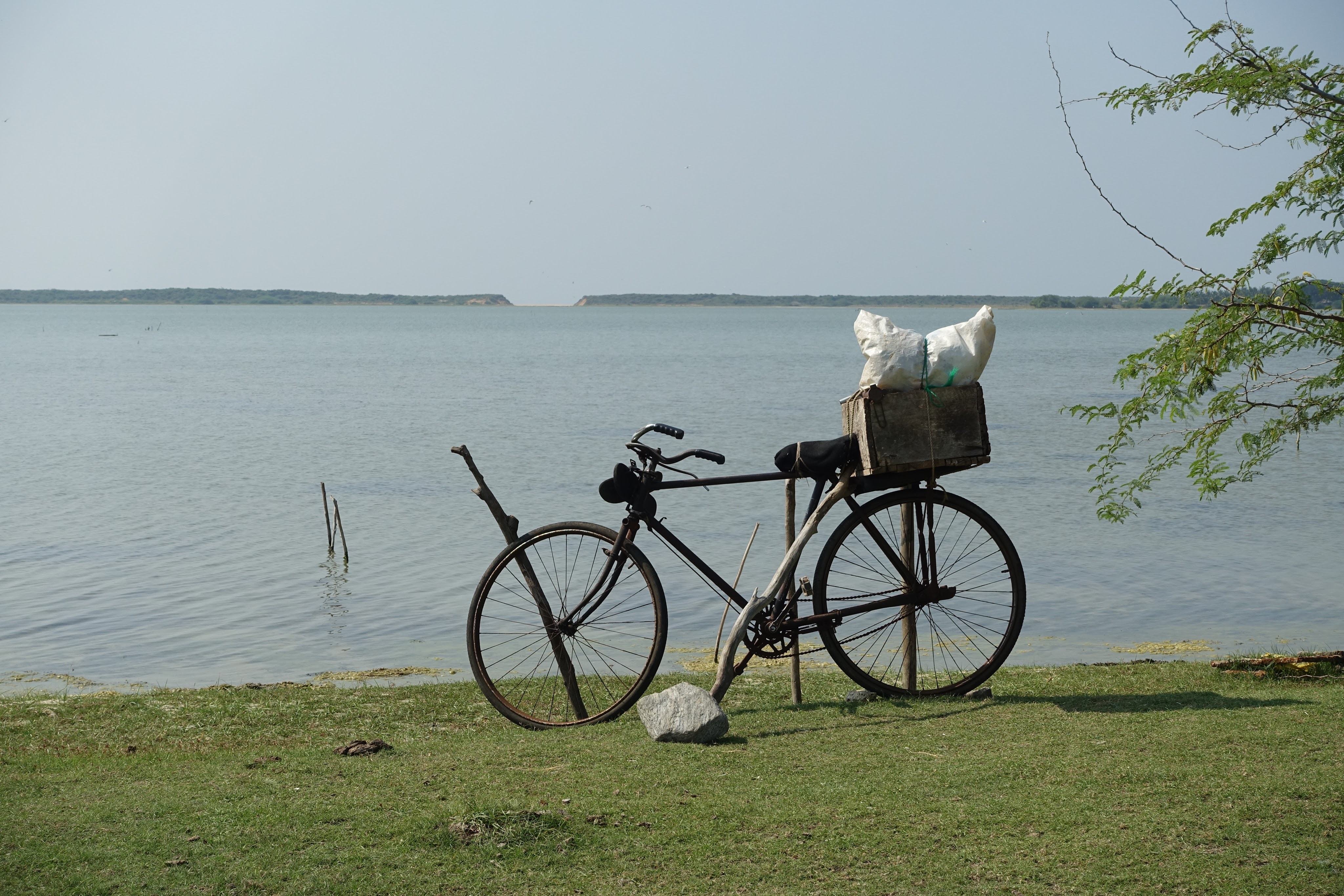 Bundala Lewaya
Bundala Lewaya
At 7:30 a.m. our peaceful breakfast was interrupted by someone starting up a petrol strimmer in the garden. The nice young lad who was running the hotel seemed genuinely surprised that we might not want to eat breakfast to the accompaniment of a strimmer. We set off on a backroad heading west out of Kirinda, navigating with the help of Google, hoping to find a shortcut to the A2. There were no roads marked on our maps, but the road we took was smooth, car-free, and lovely. Soon we came to a sign telling us we were in the Bundala National Park, and there we noticed an inviting dirt track heading off to the left. It took us into a beautiful world of lagoons and forests and grasslands and birds everywhere. We spent a couple of hours slowly riding through the park, stopping often to take in the scenery. I saw a flamingo in one lagoon and a pure-white egret standing on the black back of a bathing water buffalo. There were langurs grazing on flowers, monitor lizards rushing across the road, and flowers everywhere.
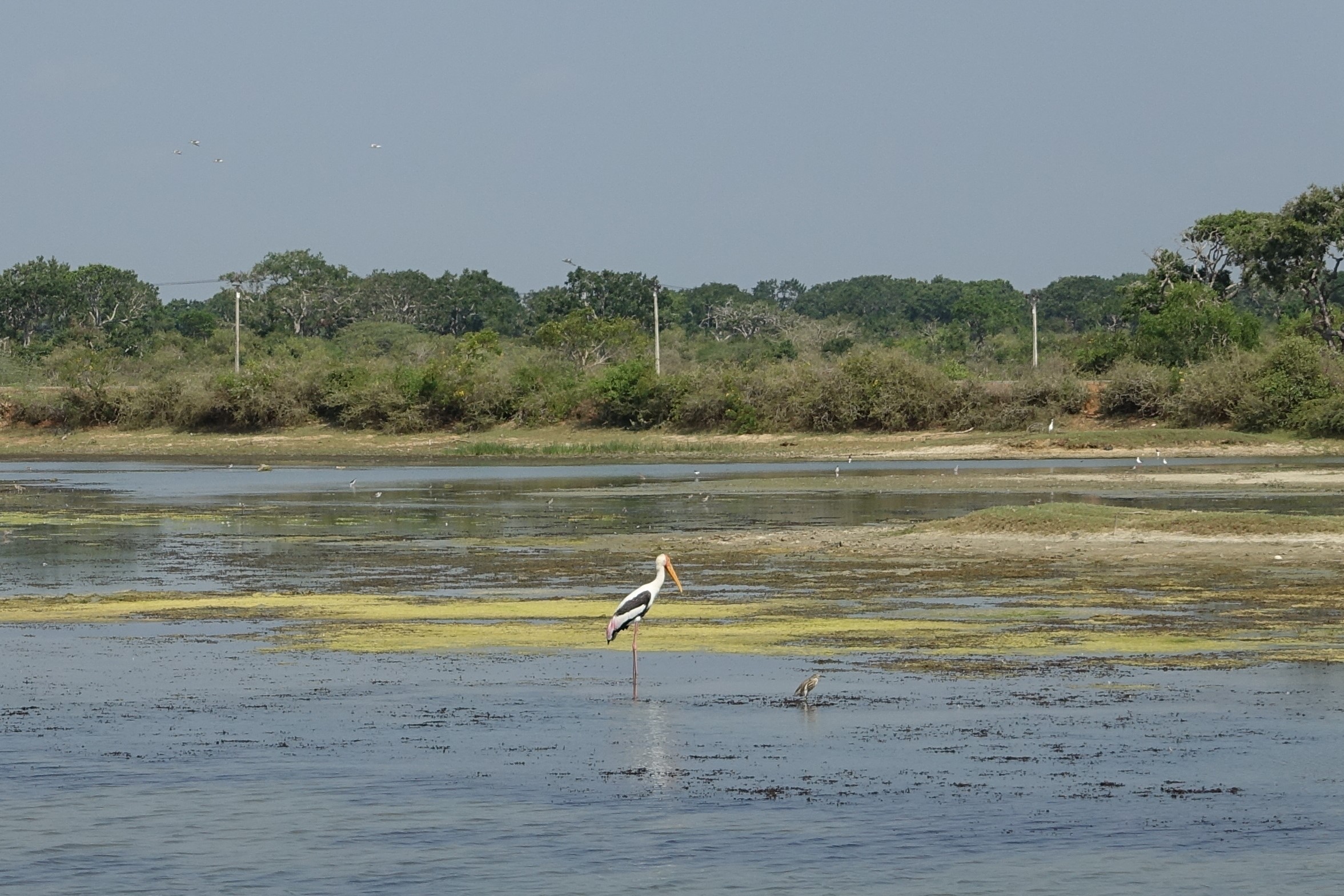 Flamingo
Flamingo
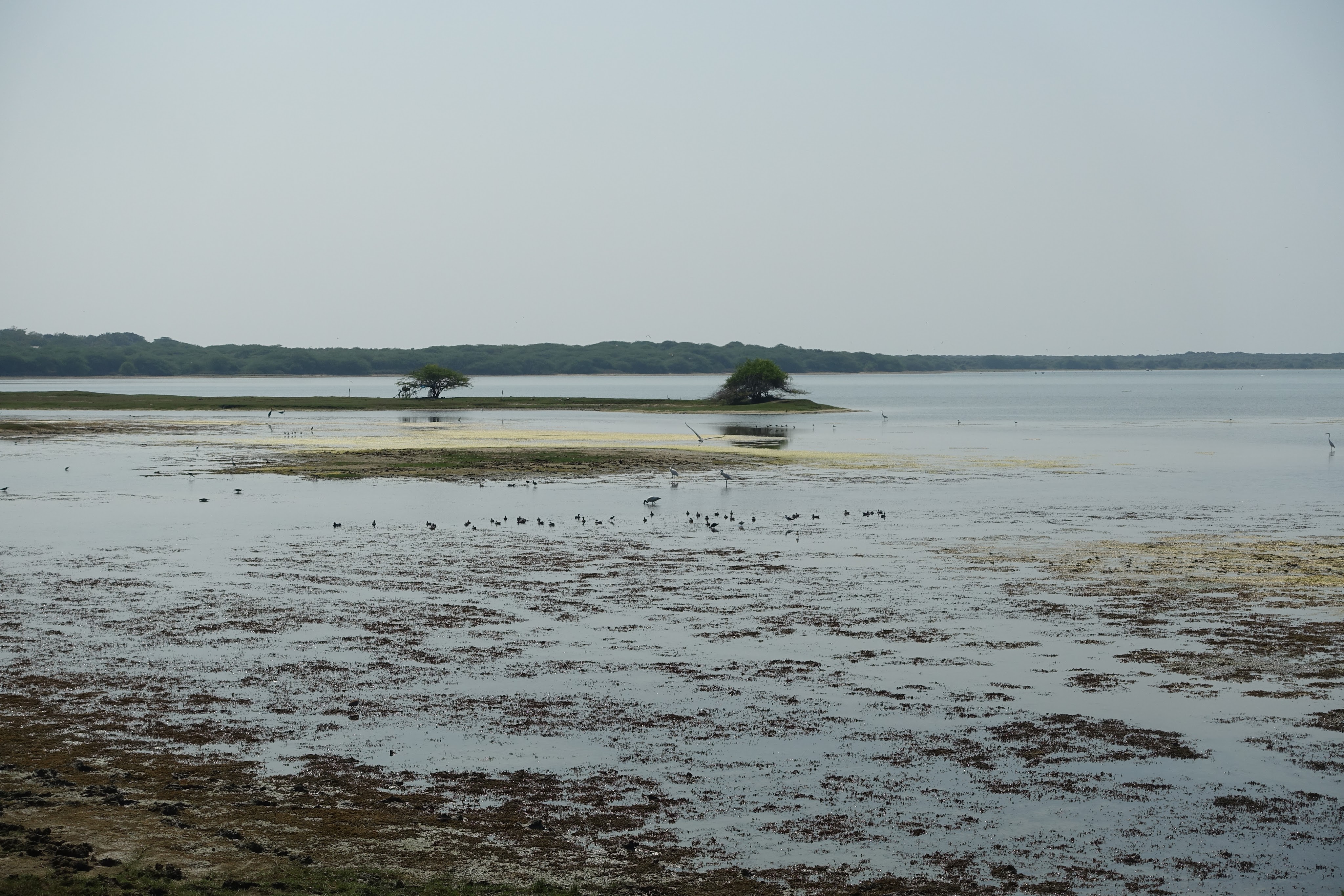 Bundala Lewaya
Bundala Lewaya
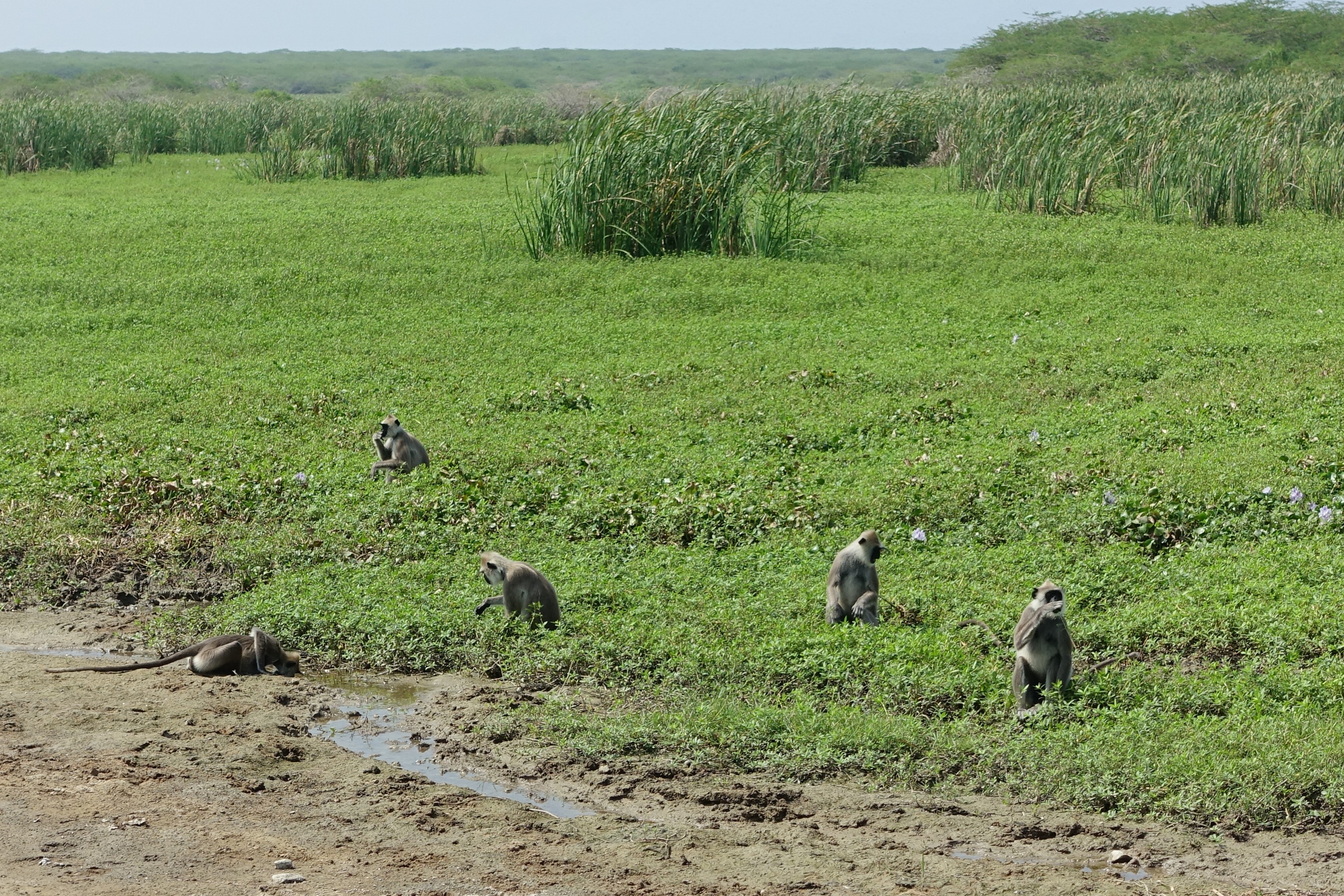 Grazing langurs
Grazing langurs
All too soon, we came to the boundary of the park where we joined the A2. It was not too busy, but soon it turned into a dual carriageway, and then a three-lane highway with a wide shoulder. We passed a huge international conference centre, the massive entrance to a port, and a sign pointing to an international airport. There were grand snaking interchanges and sprawling industrial estates, but more cows and buffaloes on the road than vehicles. On one arching overpass, there were only three vehicles on the road: John, me, and an old chap slowly pedalling his old steel bicycle. It turns out that we were passing through Hambantota, which is the birthplace of former president, Mahinda Rajapaksa. He had ordered massive infrastructure projects in his hometown omitting to consider the problem that he was born in the middle of nowhere.
After Hambantota, the road shrinks once more to a regular road with the usual erratic three-wheelers, crazy bus drivers, and crowded villages. Outside the towns it was not too bad, and trees gave us protection from both the sun and the sidewind.
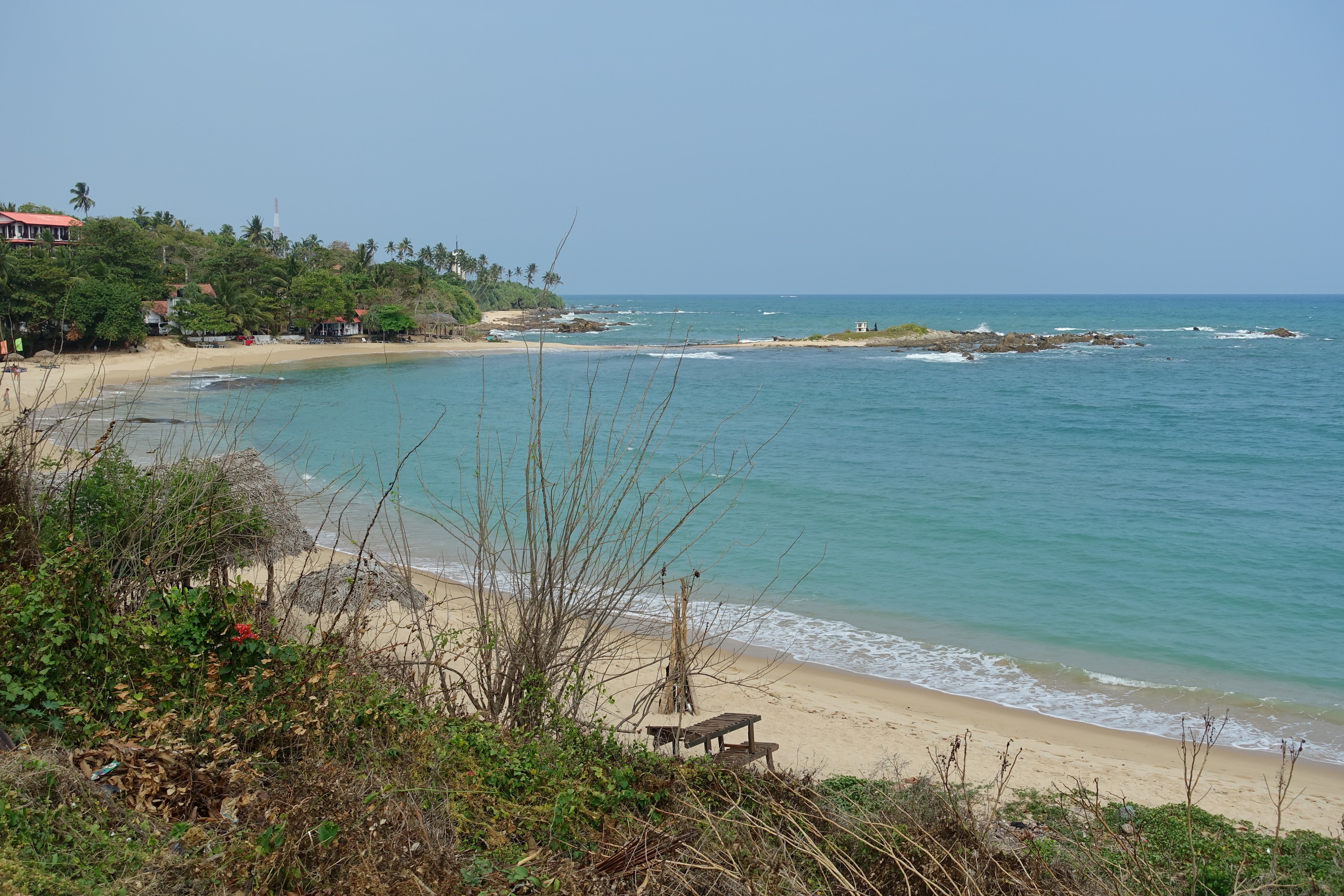 View across to Cactus Lounge restaurant
View across to Cactus Lounge restaurant
Just west of Tangalla, we stopped at the Cactus Lounge restaurant, where there is no lounge, no cacti, but fortunately a restaurant with a fine view of the beach. I had a quick dip and then enjoyed a pleasantly bland vegetable fried rice. After lunch, we cycled the last 30 kilometres to our hotel, passing through Matara with its busy town centre and awful traffic. Along the way, we met two Polish cycle tourists pink with the sun and the exertion of riding into the wind. As we approached our hotel, the traffic miraculously disappeared and we rode the last part on narrow lanes twisting through houses surrounded by tropical plants.

Sunil Rest Guest House deserves its recommendation. Sunil and his wife are charming and their place very tranquil. Rooms were only 2,000/-, so we had one each, but food was rather expensive. We had time for a swim before sunset so walked two minutes to the beach. There were quite a few foreign tourists and just as many Sri Lankans on the beach and in the water. Waves were crashing outside the reef, but inside the water was calm. It was not very clear, which meant I had quite a shock when I almost bumped into a large sea turtle. It seemed even more surprised than me as it sped off into the murk.
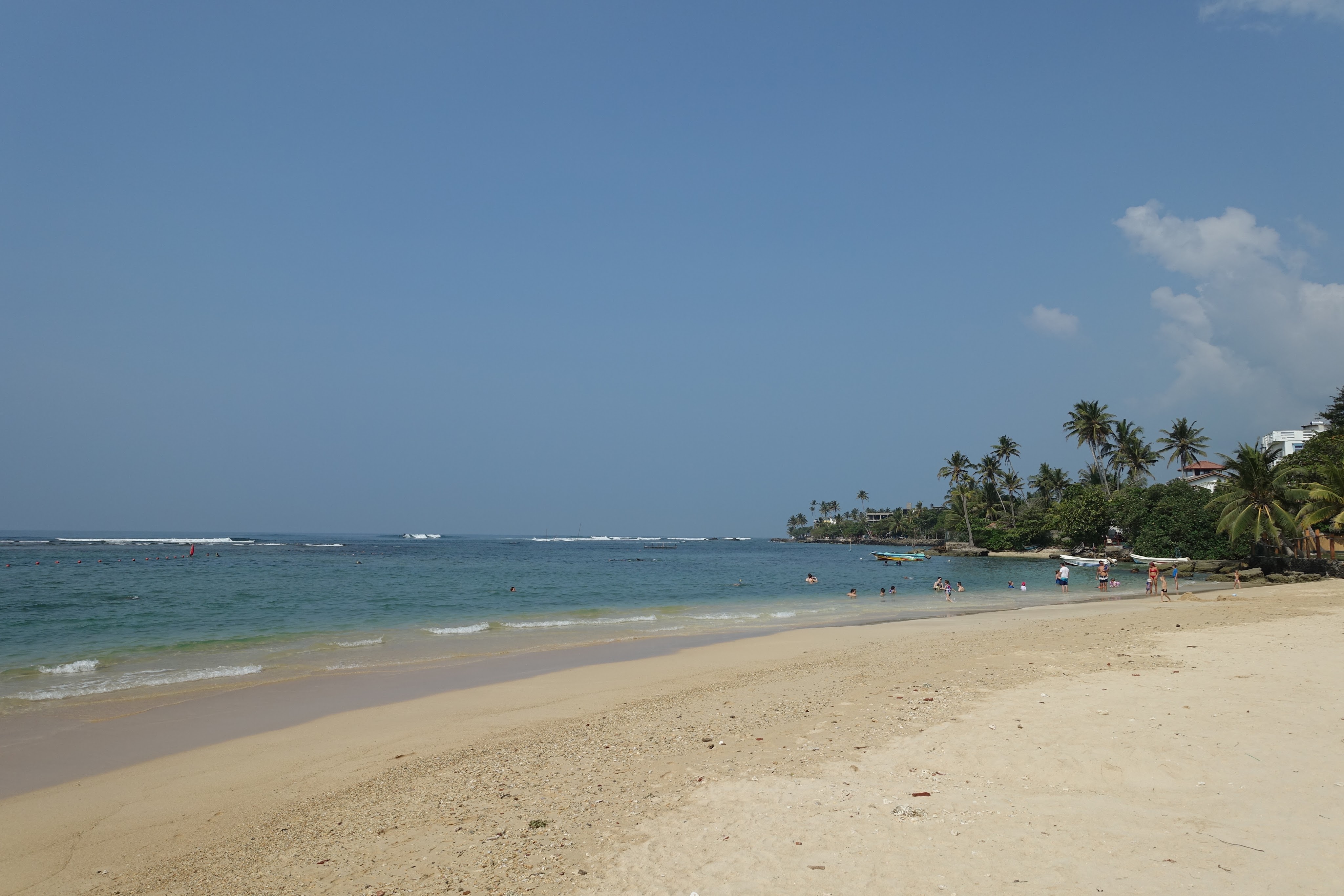 Polhena Beach
Polhena Beach
Wednesday, March 4 – Polhena to Galle 48 km
Over dinner the previous evening, we had started to formulate a new plan for our last days in Sri Lanka. Instead of finishing in Galle, spending a day sightseeing there, and then taking the train to Colombo, we thought it would be more satisfying to complete a whole loop of the country. We would only spend an afternoon in Galle, and then would have two days to cycle on backroads to Negombo where our bike boxes were being stored. The short ride to Galle also meant we could go for another swim. The sea was clearer, and I found some coral further along the beach. It was a good way to start the day.
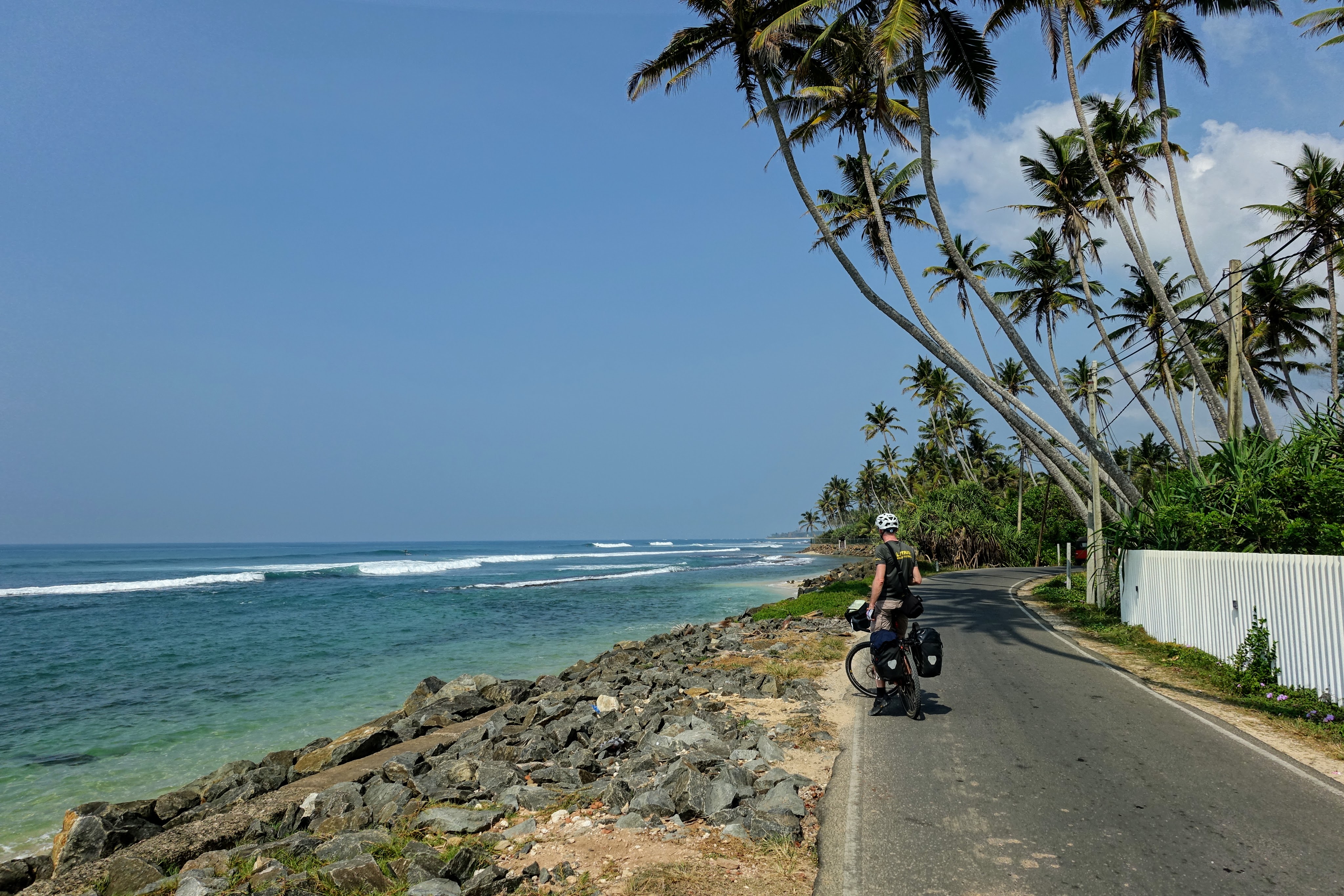 Polhena coast road
Polhena coast road
We set off along the pretty beach road for a couple of kilometres, but soon we were back on the A2 competing with the now heavy traffic. At Weligame, we admitted defeat and headed inland towards Dikkumbura. Within minutes, we were riding through an idyllic rural backwater. In one village, we stopped at a small bakery for our usual sweet bread and yoghurt drink. We had our regular conversation about the upcoming Sri Lanka – England test match with the wonderfully friendly staff. Once more Google guided us along one tiny road after another all the way to Galle where the craziness abruptly resumed. We entered the north gate of the fort and the traffic disappeared, being replaced by large numbers of tourists grazing around the shops and cafes and gelateria. In its way, it seemed just as incongruous to us as Hambantota had the previous day.
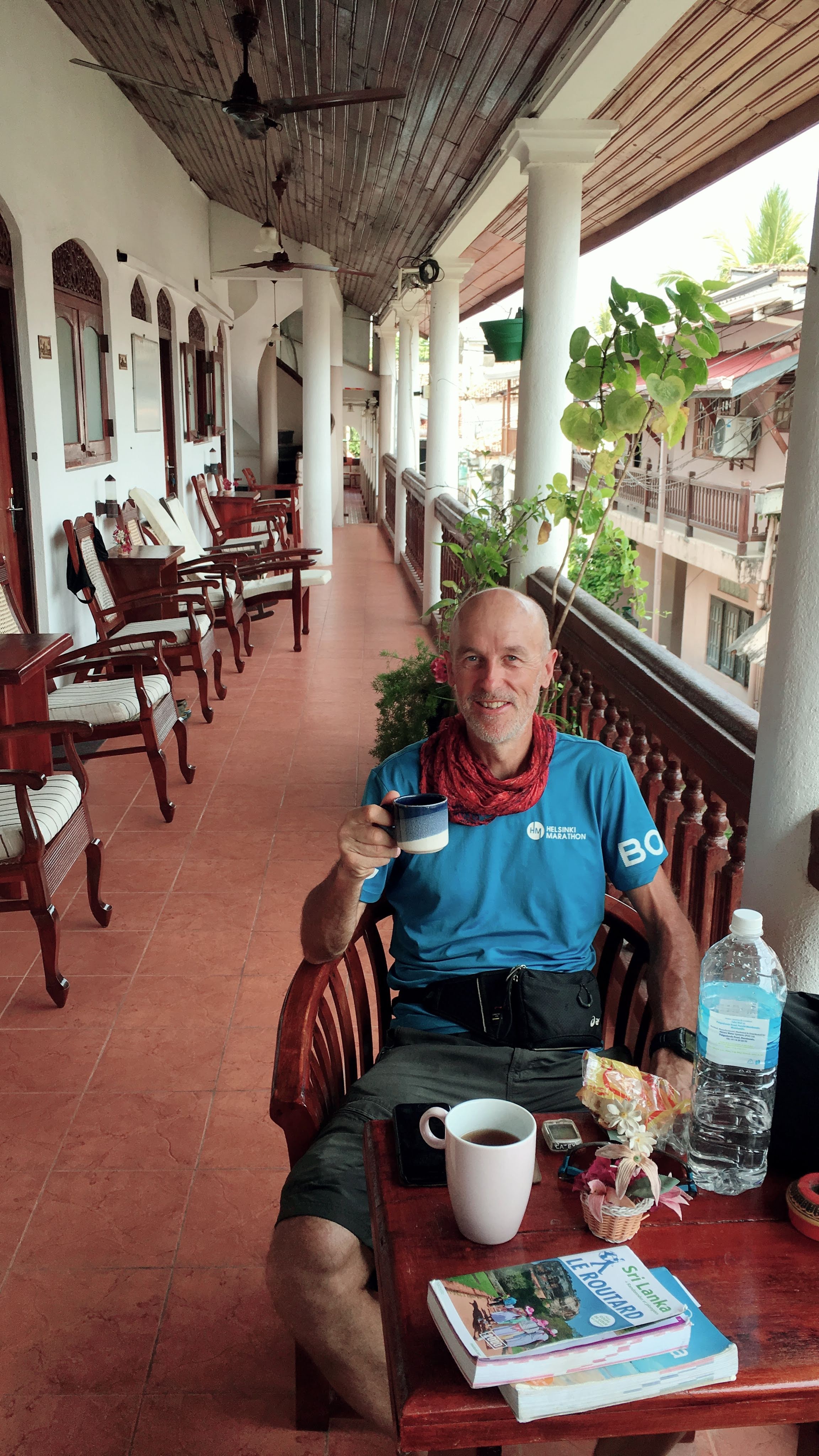 Mrs Wijenayake’s Beach Haven Guest House
Mrs Wijenayake’s Beach Haven Guest House
We stayed at Mrs Wijenayake’s Beach Haven Guest House which is a lovely place. We chose the best twin room with four-poster beds and a modern bathroom for just 5,000/-. The guesthouse is in a beautiful old house with elegant tables and chairs on the first-floor veranda and there is a kitchen with free tea and coffee.
 Galle Old Town
Galle Old Town
Galle is all about the Dutch fort and the colonial buildings within the walls. It must have been a wonderful place to visit before it was transformed into a trap for tourists who seem to have nothing better to do than eat gallons of ice cream while buying artefacts that they will forget about when they get back home. I was glad to be leaving early in the morning.
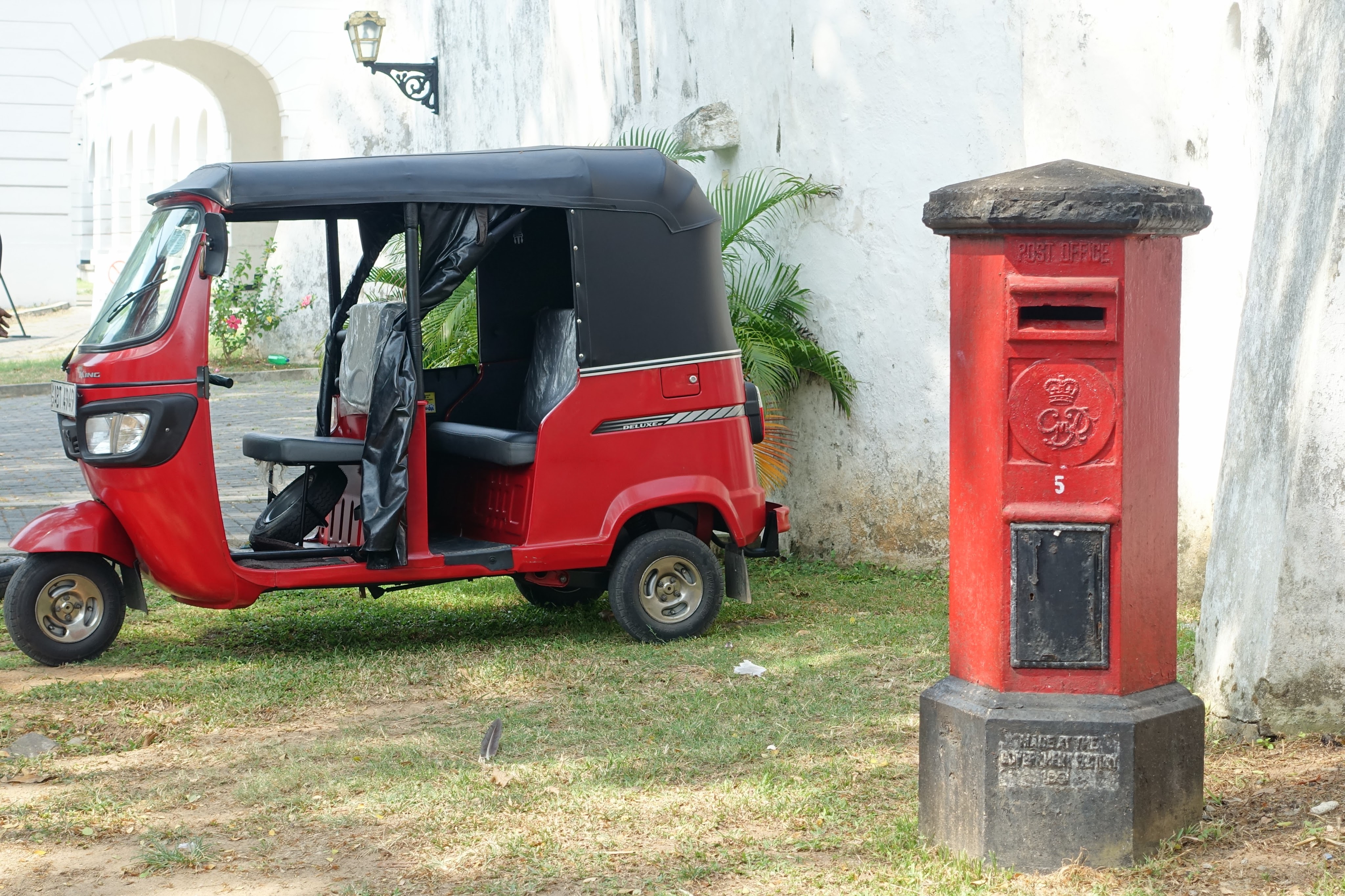
I walked in the heat of the afternoon to the new town where there was a row of pharmacies. I asked at every one of them for surgical masks for the flight home, but they were sold out. I compensated for this with an excellent trim, shave, and massage at a barbershop called Salon Milton curiously located inside the Young Men’s Buddhist Association.
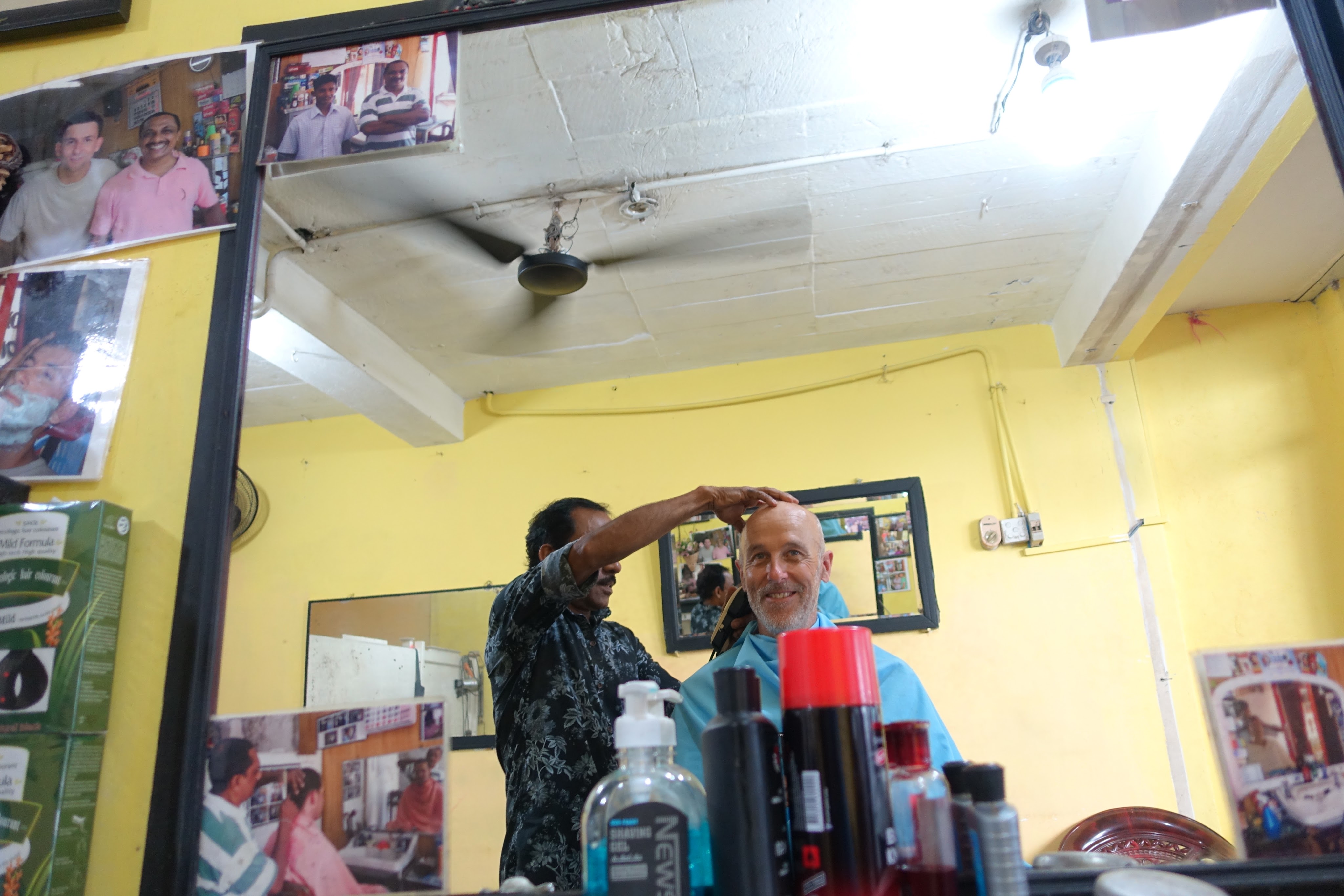 Salon Milton
Salon Milton
Thursday, March 5 – Galle to Remuna 110 km
After a fortnight of eggs and white sliced bread, we enjoyed a fine breakfast spread at Mrs Wijenayake’s: omelette, toast, crispy hoppers, real jam, a plate of fresh fruit, and pancakes with coconut and jaggery. Fuelled by this feast, we headed out through Galle’s rush hour on our first cycle lane which runs alongside the A2. Sadly, it is used as a car park for trucks and as a rat run for rickshaws and motorbikes, but at least the idea is there. We soon left the A2 and climbed north on a residential street which passed through Wakwella, Ganegama, and under the motorway at Agaliya. We then followed the Gin Ganga river eastwards for several kilometres before turning north on a tiny lane which led us up and over a shockingly steep hill to Mataka. It was a fine ride on empty roads though a lush, tropical landscape.

At Pitgala, we picked up the B158 which took us NNE to Neboda where suddenly the road widened and the traffic became heavy for a few kilometres. There were a lot of dumper trucks trundling back and forth between construction sites, but every single one of them slowed down and gave us metres of space.
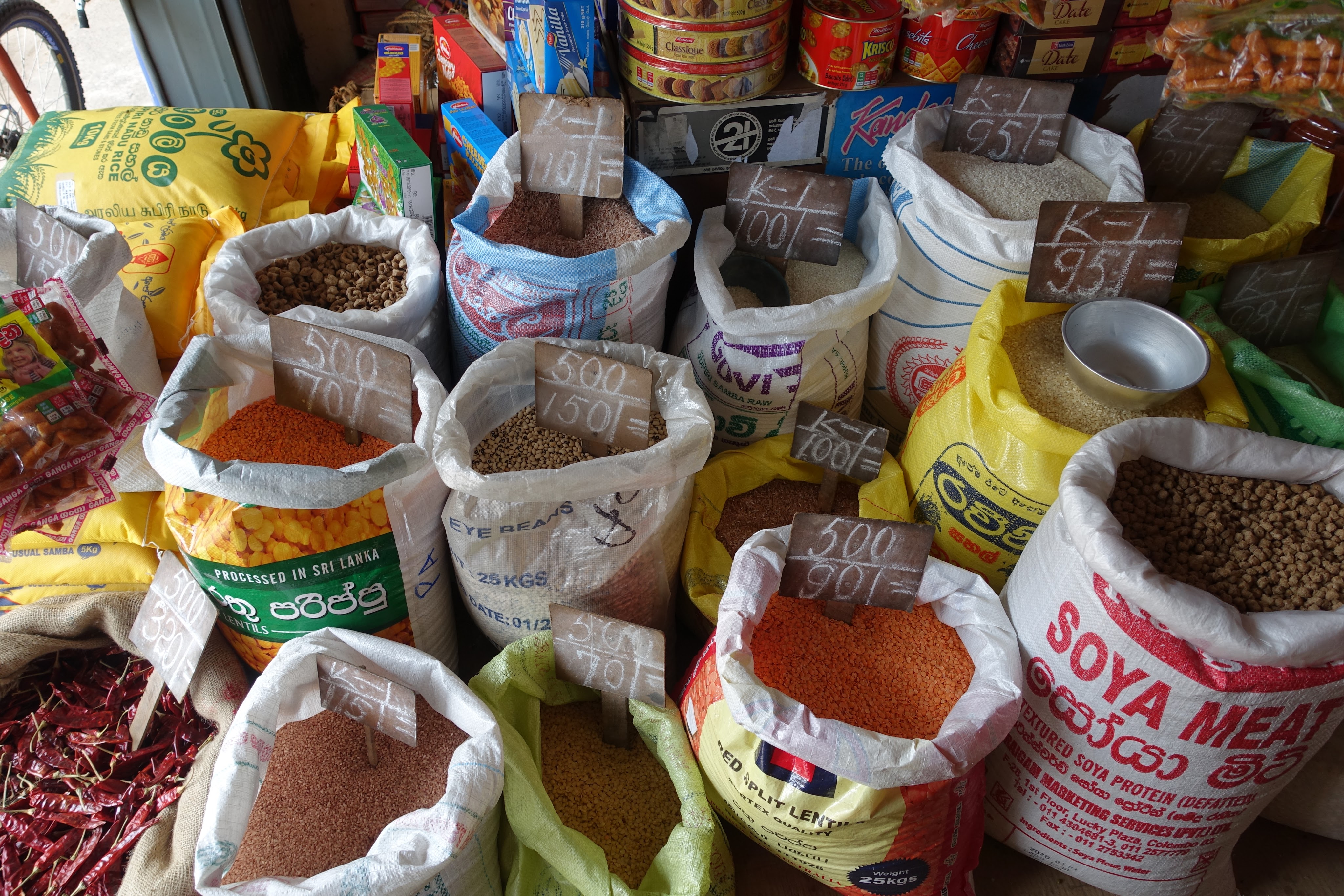
The last few kilometres to our hotel, the Lotus View, took us along another idyllic country lane lined by traditional farms. The lotus pond itself is a serene place where a few anglers were dangling lines into the reeds and flowers. In contrast, the hotel is a big, modern place used for wedding receptions. As we arrived, a wedding group was spilling out into the car park for photographs. I scuttled into my room for a shower. The rooms were splendid – clean and modern and with large balconies overlooking the lake. All this luxury for just 3,000/- per room. Even better, there was a rooftop restaurant with a cool breeze and decent enough food.
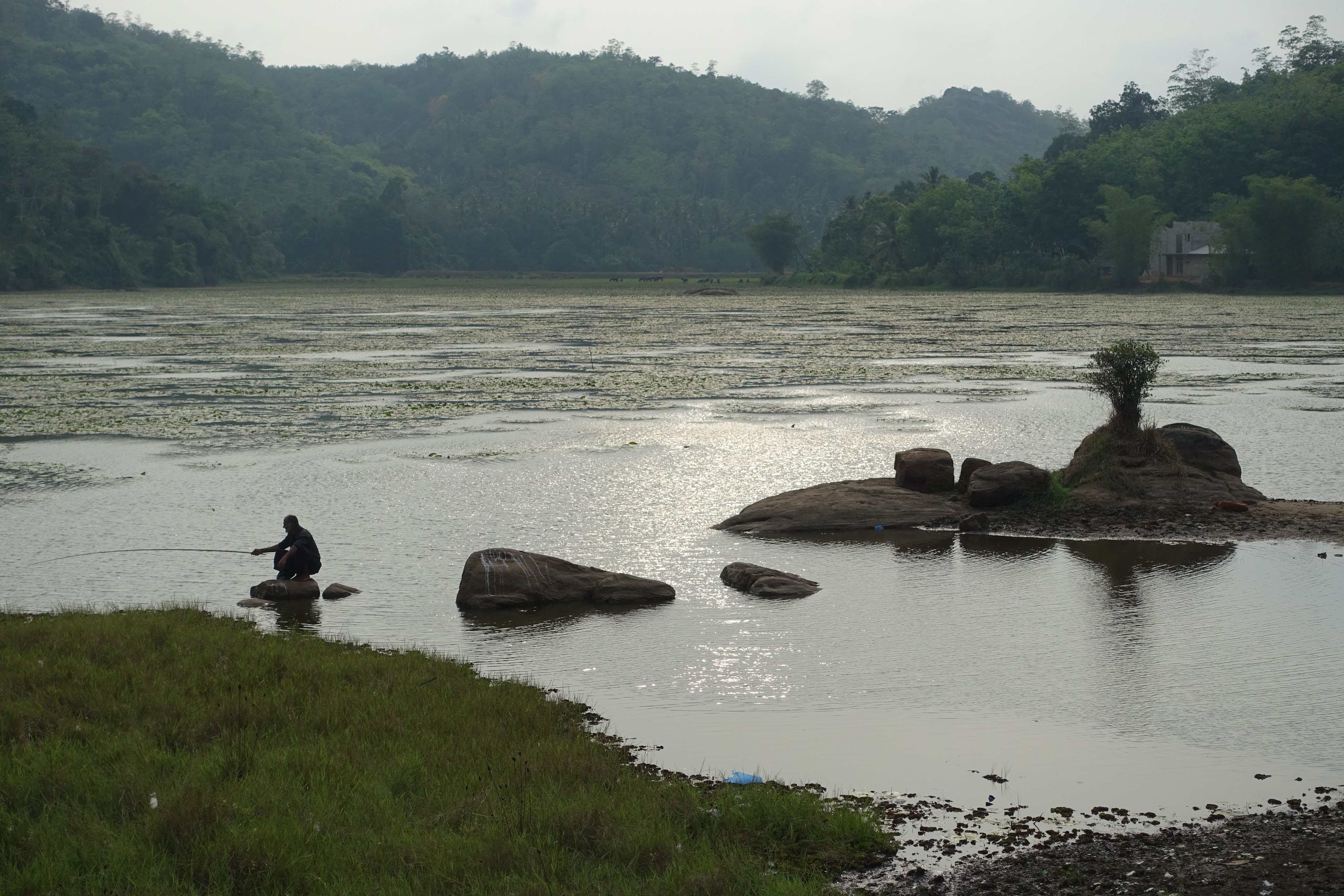 View of Remuna Lake from Lotus View Hotel
View of Remuna Lake from Lotus View Hotel
Friday, March 6 – Remuna to Negombo 96 km
Our last day of riding did not quite live up to the rest of the tour. The roads were busier than usual, and the scenery not quite so wonderful, but it was still a great way to finish: we had completed a loop of the island. At times, the traffic was too heavy for us, and around Gampaha it was uncomfortably so, but for the most part it was pretty good riding considering we were passing so close to the capital.

We left the hotel at 8 o’clock after a return to half-cooked eggs and half-toasted bread for breakfast. Our route took us through Horana, Millewa, Padukka, Kapugoda, Wellweriya, Gampaha, Dewalpola, Dunagana, and finally Negombo. At Gampaha, we found ourselves right in the city centre and had to ride along heaving roads to escape its clutches. The day was at its hottest and at one point we just had to stop and retreat into a shop for cold drinks and a brief respite from the traffic. Later, we were once more riding on a busy stretch through rice fields when a sparkling new café bakery miraculously appeared at the side of the road. Simple things can become exquisite pleasure when you are cycle touring.
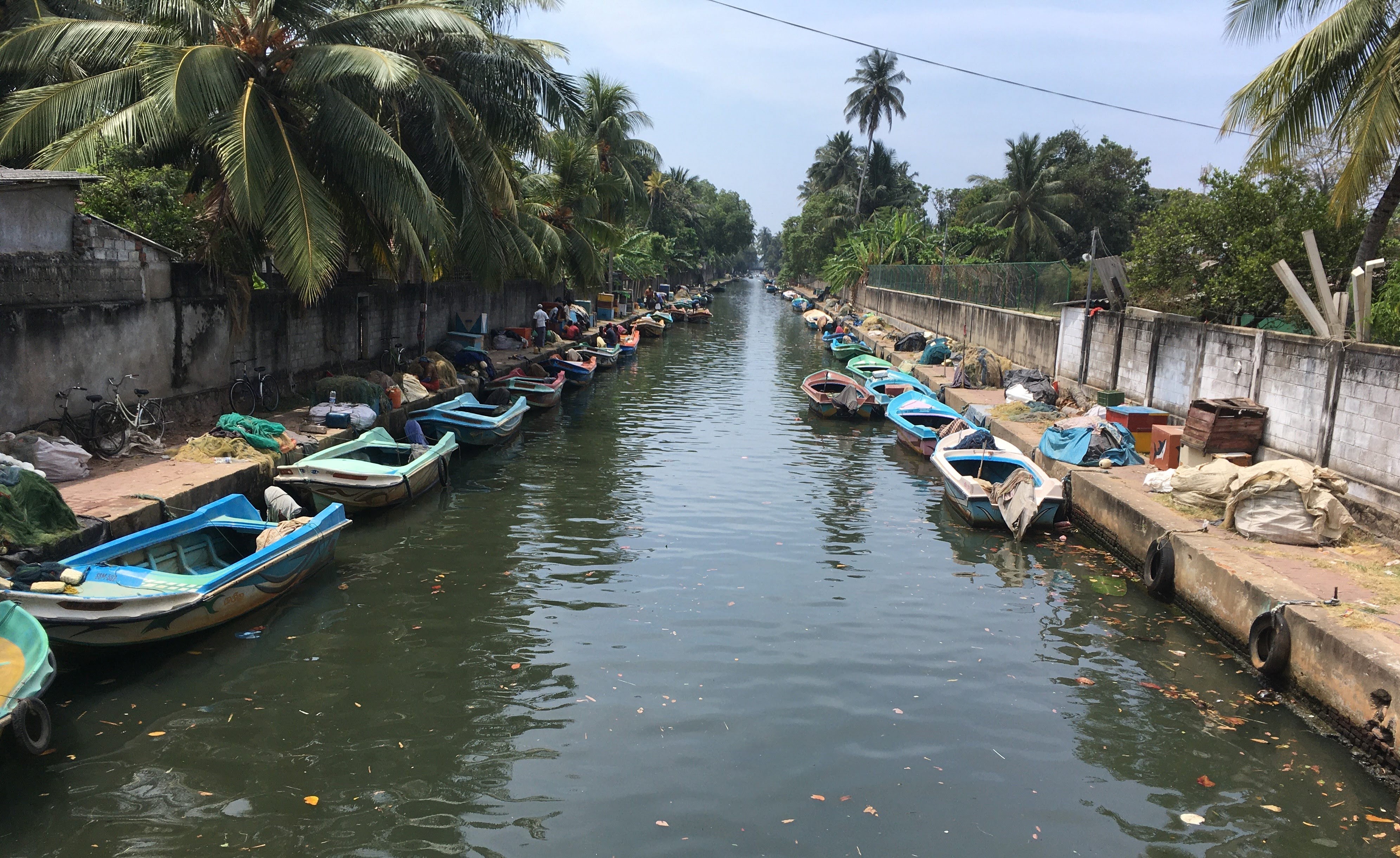 Hamilton Canal, Negombo
Hamilton Canal, Negombo
The last stretch into Negombo took us through coconut plantations and an area of beautiful big houses set in large, well-maintained gardens. We rode into Negombo and up to our hotel. We had completed our loop in just 14 days of riding. Along the way, we had enjoyed a rich mix of cultures, ancient history, warm hospitality, quiet roads, gorgeous scenery, fine weather, and not a single problem. It is hard to imagine a better place for a short cycle tour.
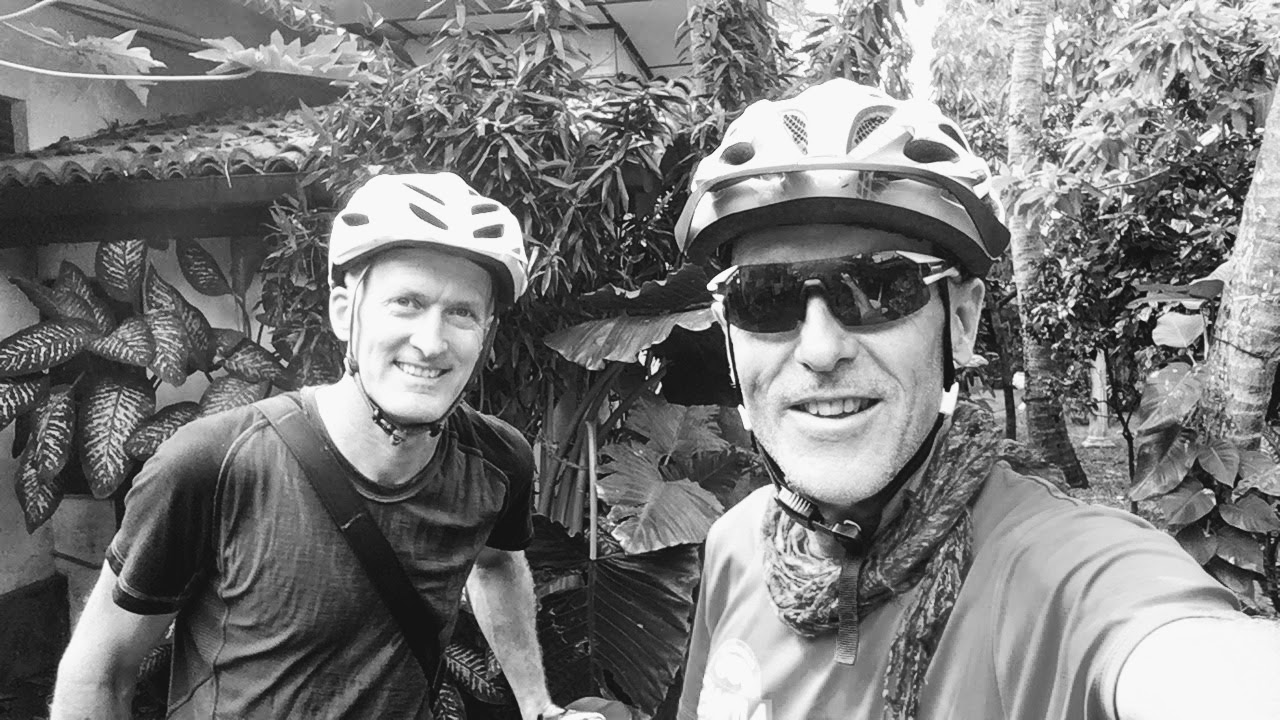 Finished!
Finished!
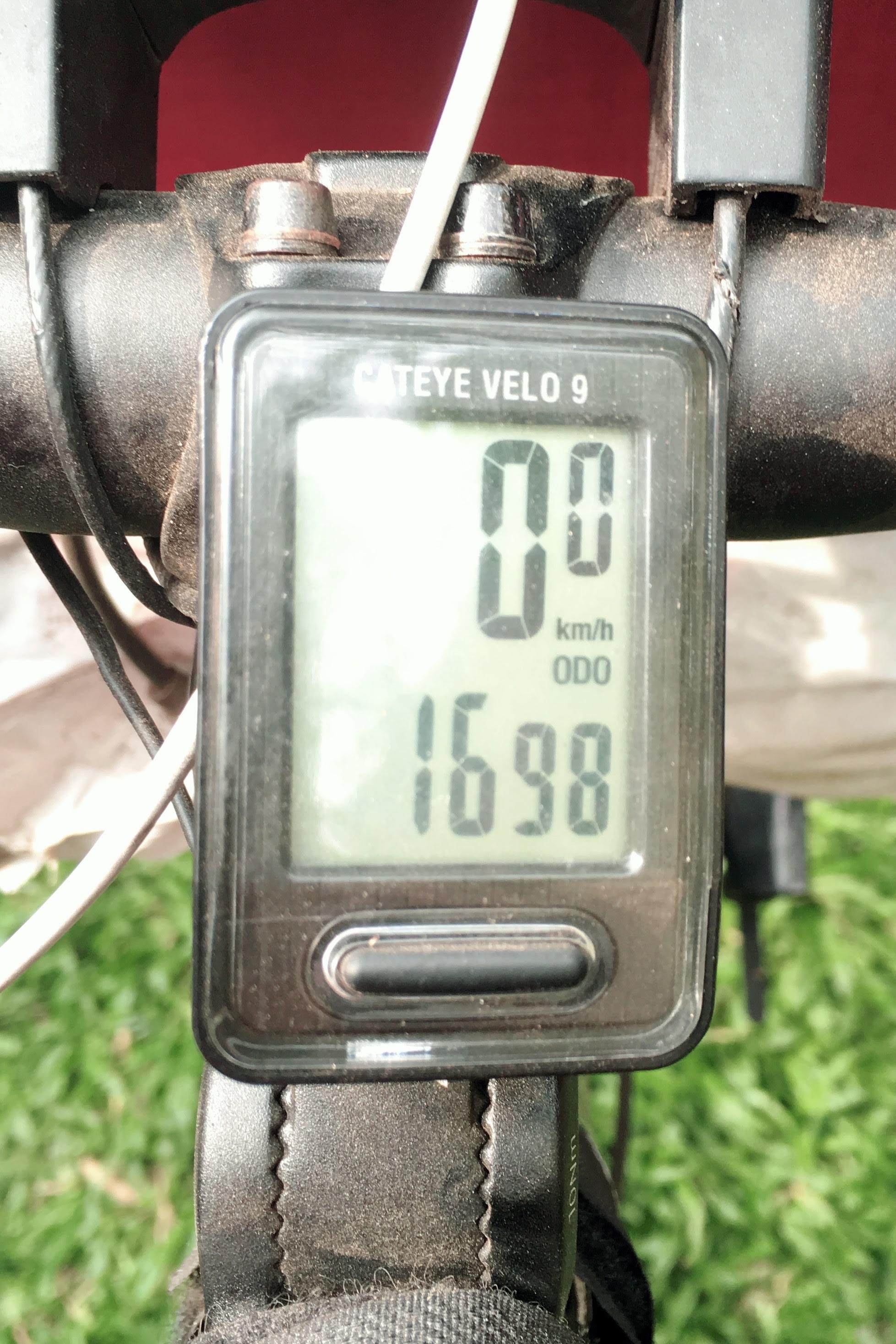 1698 km + 55 km around Jaffna Islands
1698 km + 55 km around Jaffna Islands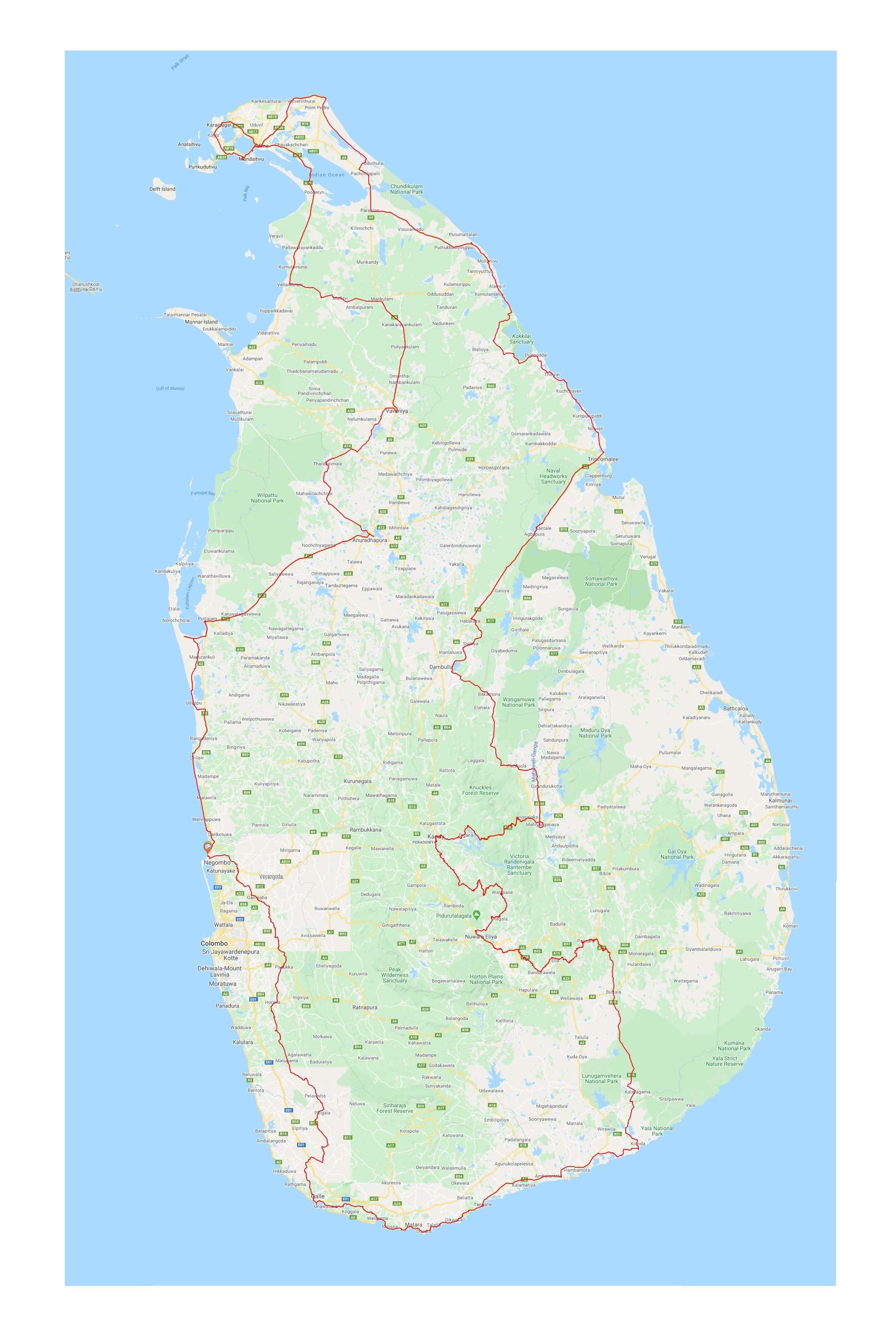 [Our Route]
[Our Route]
